

THE OFFICIAL MAGAZINE OF THE NEW ZEALAND WINE INDUSTRY AUGUST/SEPTEMBER 2023 ISSUE 141 NEW ZEALAND WINEGROWER The
Package Measuring wine packaging options, from keg to cardboard AUGUST/SEPTEMBER 2023 / ISSUE 141 Vintage Survey Harvest data Exploring Chardonnay From vine to glass OIV Chief Dr John Barker
Whole






















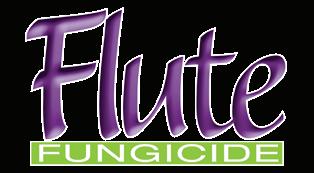









The chemistries stomping out grape diseases UPL crushes Botrytis, powdery mildew Talk to your local merchant to find out more. UPL chemistries deliver against Botrytis (Kenja® 400 SC) and powdery mildew (Kusabi® and Flute®) in grapes. Registered pursuant to the ACVM Act 1997, Kenja P009740, Kusabi P009488, Flute P009077. See www.foodsafety.govt.nz for registration conditions. Approved pursuant to the HSNO Act 1996, Approval Code, Kenja HSR101512, Kusabi HSR101410, Flute HSR100834. Flute, Kenja and Kusabi are registered trademarks. UPL-LTD.COM
Regulars
Editorial
Sophie Preece
From the CEO
Philip Gregan
The Balance
Jeremy McKenzie
The Profile
Tony Bish
Women in Wine
Dr Jo Cribb
Point of View
Uttam Floray
Wine Weather
James Morrison
Features
Vintage 2023
This year’s national harvest is 6% down on the bumper 2022 yields, with 501,000 tonnes. Marlborough contributes 81.3% of that total, with 393,865 tonnes, down 5% on last year’s record crop. Sauvignon Blanc takes the lion’s share of the harvest, at 78.1%, followed by Pinot Noir at 6.3% of total production.


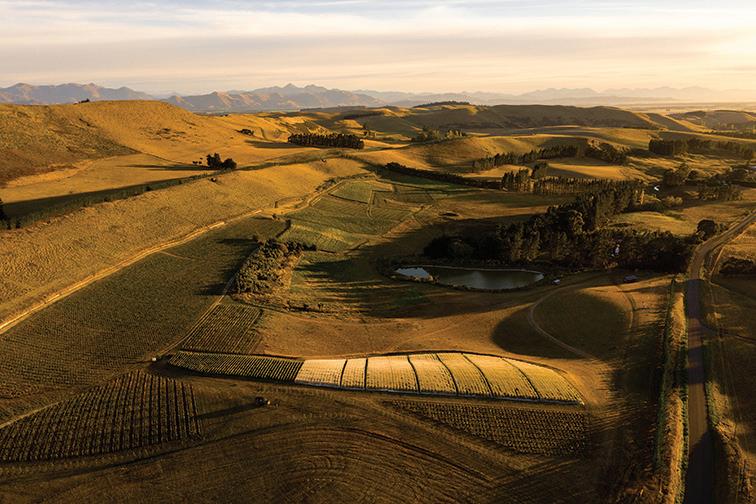
OIV Chief
The newly elected Director General of the Organisation of Vine and Wine takes up his role 100 years after the organisation began. We ask Dr John Barker about a career that has married his love of law and of wine, and about the significance of having a New Zealander at the helm of the OIV.
Fifty years in wine
Allan Scott took a punt on a new job in August 1973, joining 90 bewildered workers in the dry and dusty Brancott Valley. Fifty years after Montana planted its first Marlborough wines, he says “having to carve out a whole new life I didn’t know about was probably one of the best decisions I made”.

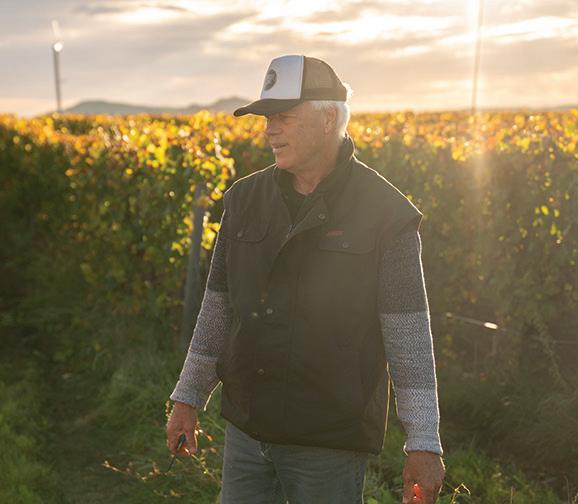
ISSUE 141 – AUGUST/SEPTEMBER 2023
COVER PHOTO
The carbon cost of glass packaging led winemaker and lecturer Nadine Worley and viticulturist Logie MacKenzie to launch Fugitive, with organic Sauvignon Blanc and Pinot Noir sold only in reusable kegs and bottles. Nadine looks at packaging options in this month’s focus feature. Go to page 18. Photo Lisa Duncan.
4 6 38 36 14 40 48 36 38 42 64 66 14 44 48
Photo Richard Brimer
EDITOR Sophie Preece sophie@sophiepreece.co.nz
CORRESPONDENTS
Wellington Wine Country: Joelle Thomson mailme@joellethomson.com
Hawkes Bay: Olly Styles oliverstyles@hotmail.com
Canterbury: Jo Burzynska jo@joburzynska.com
ADVERTISING
Upper North Island: Stephen Pollard stephenp@ruralnews.co.nz
Ph: 021 963 166
Central North Island: Lisa Wise lisaw@ruralnews.co.nz
Ph: 027 369 9218

Lower North Island: Ron Mackay ronm@ruralnews.co.nz

Ph: 021 453 914
South Island: Kaye Sutherland kayes@ruralnews.co.nz
Ph: 021 221 1994
CIRCULATION & SUBSCRIPTIONS
Carolina Paiva carolina.paiva@nzwine.com
027 700 0740
New Zealand Winegrowers PO Box 90 276, Auckland Mail Centre, New Zealand
PUBLISHING & PRE-PRESS
Rural News Group PO Box 331100, Takapuna, Auckland 0740
Ph: 09 307 0399
Location: Top Floor, 29 Northcroft Street, Takapuna, Auckland 0622
Publisher: Brian Hight
Managing Editor: Adam Fricker
Production: David Ferguson, Rebecca Williams
Published by Rural News Group Ltd under authority of New Zealand Winegrowers Inc. Unless directly attributed, opinions expressed in the magazine are not necessarily those of Rural News Group and/or its directors or management, New Zealand Winegrowers Inc. or its constituent organisations. Published every second month. One free copy is mailed to every member of the New Zealand Winegrowers Inc, the New Zealand Society of Viticulture & Oenology and the New Zealand Vine Improvement Group, and to such other persons or organisations as directed by the owners, with provision for additional copies and other recipients to be on a subscription.
ISSN 1174-5223

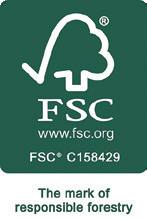
From the Editor
When Philip Gregan began working at the Wine Institute of New Zealand in 1983, this country had 6,000 planted hectares and an abundance of potential. Fast forward four decades and there are 41,860ha of producing vineyard, and a whopping $2.4 billion in exports for the year ending May 2023.
While history is key, where we are going is more important, Philip says, in reflecting on his time in the industry (see page 46). “We must always have our eye on what the next 10, 20, 30 years will bring. And I fundamentally believe that’s a really exciting future for New Zealand wine.”
That future will doubtless include innovations to ensure the industry grows its environmental sustainability and reduces its carbon footprint, including by addressing the emissions involved in producing and transporting glass bottles. “Although no non-glass packaging is the perfect solution, the overwhelming environmental benefits, improved convenience, and increased options for serving size have now made alternative packaging a viable option,” says Nadine Worley on page 18, as she explores the possibilities.
Wine merchants expect consumers to adopt alternative packaging, and especially wine in bag-in-box containers and aluminium cans, according to the ProWein Business Report 2022 (see page 23). Many New Zealand companies have already adopted light weight bottles, while some are also finding alternatives to glass for some of their wines, including Dicey with their Dice bag-in-box Central Otago Pinot Noir, and Uncommon with their wine in a can. These are two of the stories Nadine looks at, but there are plenty of other companies weighing up their options. Belinda Jackson of Lawson’s Dry Hills, one of the speakers at last month’s Grape Days events, has been researching options to bottle the company’s Inviniti brand –dedicated to sustainable wine at an accessible price – in a Packamama bottle, which has a flattened shape that enables many more lightweight PET bottles to be stacked in a container. It’s an exciting prospect, says Belinda. “The challenge is actually finding someone in New Zealand who is willing to bottle it.”
Sophie Preece EDITOR
Contributors
Nadine Worley
Wine lecturer Nadine Worley co-founded a wine company using reusable kegs and bottles. Nadine looks at the packaging alternatives for wine. Go to page 18

Joelle Thomson Writer and wine lover Joelle Thomson speaks to Tony Bish about his rise to Chardonnista, Hawke’s Bay’s tough 2023 vintage, and an accidental career in wine.
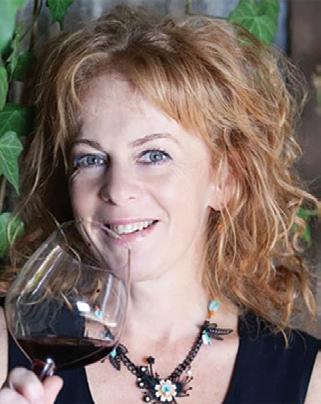

Go to page 38
Bob Campbell MW
Following the entomology of ‘plonk’ for his wine students led Bob Campbell MW through World War 1, from vin blanc to plinketty plonk.
Go to page 50
Power, cooling and heating specialists for wineries
With over 20 years’ experience working with the wine industry throughout the New Zealand Pacific region, we understand what it takes to enhance productivity and decrease costs for your winery. We can help you make your vintage a success by:

Controlling fermentation
Providing temporary cooling for cellars or other critical functions


Providing additional power when needed We are on call 24 hours a day, seven days a week to serve you.

Warehouse cooling Extra chilled water for tank cooling Hot water for seasonal peak loads Call us to learn more 0800 003 921
From the CEO
Ask what they can do …
PHILIP GREGAN
The General Election is now less than three months away and the various political parties are out there launching policies and making announcements about what they will or will not do if they are in power. That makes it a great time to talk to the parties and candidates, to tell them what you think, to ask them about what they are going to do … for your country, for our sector, for your local community.
year our exports have jumped 25% in value to $2.4 billion; wine is this country’s 6th largest export good. We attract tourists, and we know tourists who come to New Zealand and visit wineries stay longer, visit more regions, and spend more.
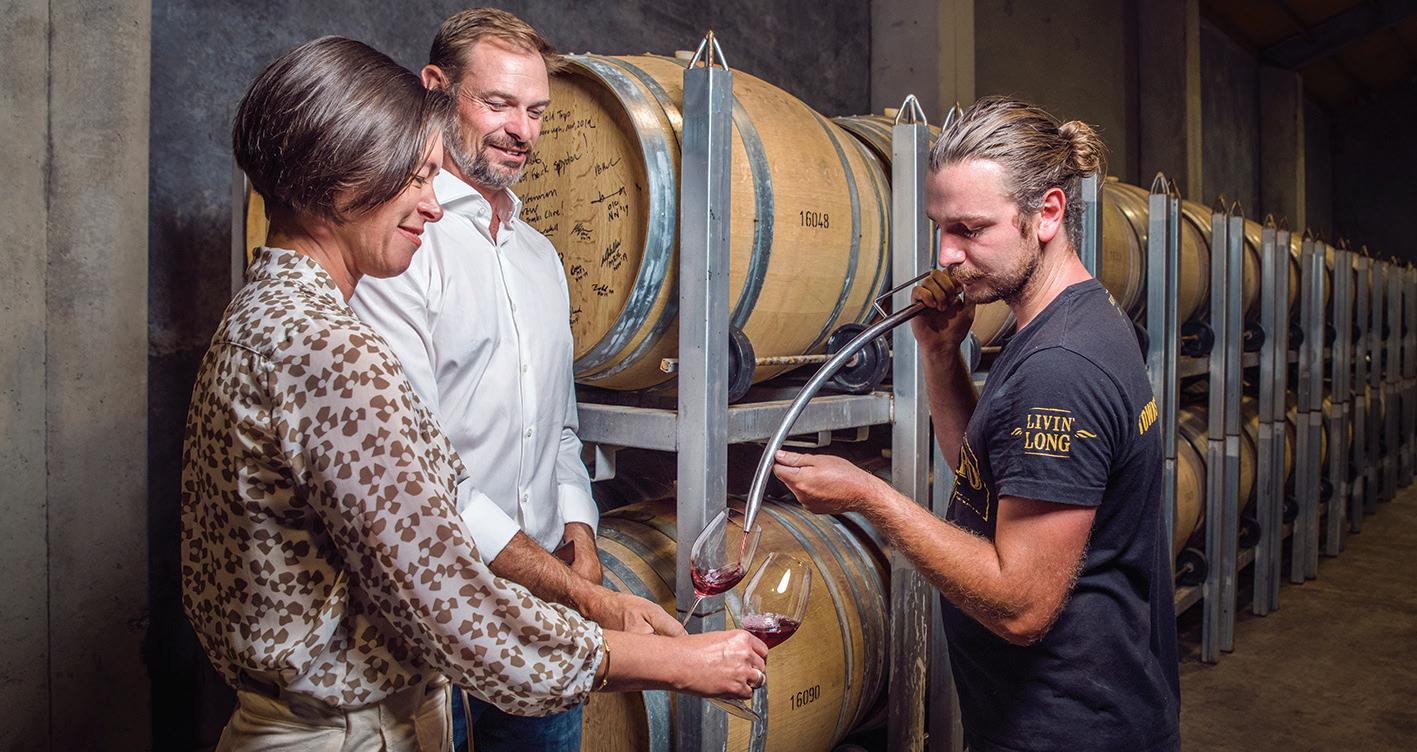
governments impose a host of regulations and rules on business. Are they planning new rules, are they planning to get rid of any?
So what are some of the messages you might like to convey in the lead up to the election? You can obviously talk about your business and the detailed issues you are facing – you know those better those anyone else.
You might like to talk about pride. The pride you have in your business, that all our growers and wineries have. We know our wine community is incredibly proud of what it does. Everyone works hard to apply their knowledge, their craft in the very special places they farm, from Northland to Central Otago. The result of that endeavour is that we produce, without doubt, some of the very best wine in the world.
You can talk about the contribution your business makes to your local community, and your region. From a wider New Zealand perspective you can tell candidates that the New Zealand wine community is important for our economy, for the country. We employ more than 7,000 full-time staff and a host of seasonal workers as well. In the past
You can talk about how our wines promote New Zealand overseas in a way no other product does. All our wines proudly bear the words ‘New Zealand’, along with our various regional and subregional names. What other product tells our stories the way wine does?
You can talk about sustainability and the way we care for our special wine places, our people, and for the future. That we have had an industry-wide sustainability programme in place since the mid-1990s. That many growers and wineries are organic or biodynamic. That we use water efficiently, that we use little nitrogenous fertiliser, that we are committed to protecting the places where we grow our grapes and make our wines. That we support our people through programmes like Young Winemaker, Young Viticulturist, and Women in Wine.
What about questions for the candidates? You might ask them if they are proud of our industry, and the contribution our growers and wineries make to the economy, our local communities and New Zealand as a whole. What about specific questions? We all know

How are they going to keep the cost of regulation down? A good example is that vineyard freshwater farm plan certification costs are estimated to fall between $4 million and $20m – what are they going to do to contain those costs? Will they enable us to use Sustainable Winegrowing New Zealand to assist with compliance, rather than building a duplicate system with all those extra costs?
Think about Sale of Alcohol issues and the costs associated with all those impositions on our cellar doors. Are they supportive of the Recognised Seasonal Employer scheme and getting vintage workers into the country each year? What’s their attitude to Fair Pay Agreements currently being imposed on parts of our industry? And don’t forget excise, of course.
Elections are a great time to ask questions. So get out there and meet the candidates standing in your electorate. Ask them what they are going to do for your country, for our sector, for your local community. It’s been 40 years since Philip Gregan joined the Wine Institute, which would later become New Zealand Winegrowers. To read more, go to page 46
6 I NEW ZEALAND WINEGROWER I AUGUST/SEPTEMBER 2023 FROM THE CEO
“In the past year our exports have jumped 25 % in value to $ 2.4 billion; wine is this country’s 6 th largest export good.”
Philip Gregan
Tourists who come to New Zealand and visit wineries stay longer, visit more regions, and spend more.
your wine!
Accurate sensors mean:

• Monitor wine quality 24/7
• Perfect wine temperature control
• Precise wine density reading
• Minimise waste
Temperature control is a critical quality parameter in wine production. ifm’s wine tank control solution assists in maintaining a stable temperature of the wine during the various phases of its fermentation and processing to ensure that the final wine quality is acceptable.



By controlling the temperature, the wine maker controls the biological process and

Easy to use, pre-configured, no programming necessary

Plug and Play
Trending Data allows trend analysis from past procedures and historical data
Tank and Plant Alarms
run dry, level switch
Scalable to include additional measurements
Remote monitoring and control enabled

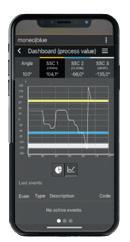
Ensuring Final Wine Quality Ph: 0800 803444 sales.nz@ifm.com | www.ifm.com/nz
Ditch the guess work, unlock the
potential of
full
PLC Power Highest accuracy LR radar level sensor (+/-2mm/10m) TCC: the most precise temp sensor available TCC: the most precise temp
LMT:
34 bit high resolution pressure sensor 34 bit high resolution pressure sensor Monitor your processes ifm Winegrower A4 advert.indd 2 28/03/23 9:25 PM
sensor available
MVQ: valve position sensor (monitoring 0...90º)
TUKU turns five
TUKU, the world’s first collective of Māori wine producers, celebrated its five-year anniversary in July. Since launching in 2018, TUKU has helped members create a platform to tell stories globally about Māori wine producers. During that time, the collective has provided insight to government strategy and free trade agreements – and it is now reaching out to indigenous winemakers in other countries, starting with Canada, to create an informal network of support. Wines from TUKU members were served at an official Matariki dinner in Christchurch in July to recognise the milestone.

Historic site
Heritage New Zealand Pouhere Taonga has listed the former Corban’s Winery and Mt Lebanon Vineyards near Henderson as a Category 1 historic place, identifying the complex as having outstanding national
importance. The site includes the original wine cellar complex, the 1920s Corban homestead, the distillery tower with its well-known ‘Corbans’ sign visible from Swanson Road, and extended office, bottling plant and despatch facilities. The
Global wins for Greystone
listing includes shelter trees and other historic plantings from the complex’s early years.
The winery and vineyards were founded by pioneer Lebanese winemaker Assid Abraham Corban and his family in 1902.
Research Conference
The inaugural New Zealand Wine Centre Scientific Research Conference on 14 November will highlight scientific grape and wine research from universities and research organisations across New Zealand. The one-day conference in Blenheim will include international guest speakers and provide a forum for researchers, post-graduate students, and industry technical specialists to meet and connect, increase research awareness, encourage collaborative opportunities, and showcase leading New Zealand grape and wine research. mrc.org.nz/nzwc-scientific-research-conference
Greystone’s 2021 Organic Chardonnay won best organic wine in the country at the 2023 Aotearoa Organic Wine Awards, taking Riedel Wine of the Show as well as Champion Chardonnay. The North Canterbury Chardonnay has attracted “a huge amount of attention”, says winemaker Dom Maxwell, following a trifecta at the International Wine Challenge (IWC) 2023, with the New Zealand White Trophy, New Zealand Chardonnay Trophy and Canterbury Chardonnay Trophy. “We’ve understood for a while that there is some compelling Chardonnay coming off Greystone Vineyard – these awards just back that up,” Dom says. Greystone also won the IWC Organic Trophy.
New Zealand came away with 38 gold medals for wines at the IWC, one of the top 12 wine-producing countries. Thirteen of those medals went to Chardonnay. Greystone’s General Manager of Sales and Marketing Stephen McGowan says New Zealand has long been celebrated for its exceptional Sauvignon Blanc, but its Chardonnays often remain “under the radar”. Greystone’s success demonstrates that New Zealand is not limited to a single varietal “and possesses the climate, talent, skills, and expertise to excel across different grape varieties & wine styles”, he says.
Dom and Greystone Viticulturist Mike Saunders are presenting at the Aotearoa New Zealand Chardonnay Symposium in Hawke’s Bay in October, as part of the New Zealand Society for Viticulture and Oenology (NZSVO) Technical Workshop. Read more about the workshop on page 30
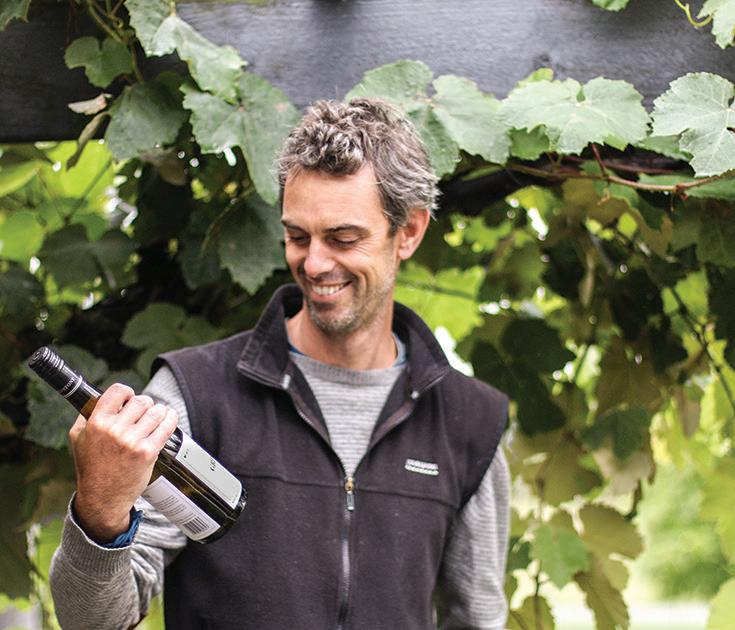

8 I NEW ZEALAND WINEGROWER I AUGUST/SEPTEMBER 2023 NEWS BRIEFS
Maude
Organic Vermouth
Hastings Distillers has added two certified organic dry vermouths to its line-up – the Aubyn Orange and Aubyn Blanc Extra. Following the success of the Rubis red vermouth, launched in 2021, the company’s founders David Ramonteu and Kate Galloway (pictured) began working on a white version. Vermouth has a wine base and is flavoured with herbs, but David says commercial versions of the drink often contain high sugar and preservative. The two Aubyn vermouths, by comparison, are low in sugar and produced using only organic Chardonnay grapes from Maraekakaho in Hastings, along with Kate’s blend of 21 botanicals, chosen especially for each vermouth.

“We’ve used indigenous yeast – that is, yeast found in the vineyard where the grapes are grown – to ferment the wine base of the vermouth,” explains David, who is French and grew up in a winemaking family. “We use every part of the grape – the pips, the stalks, the skins, and add nothing but pure alcohol, and Kate’s botanicals – wormwood, lemongrass, sage, thyme, curry plant, kaffir lime, and wild pepper among them –to create the finished product.”
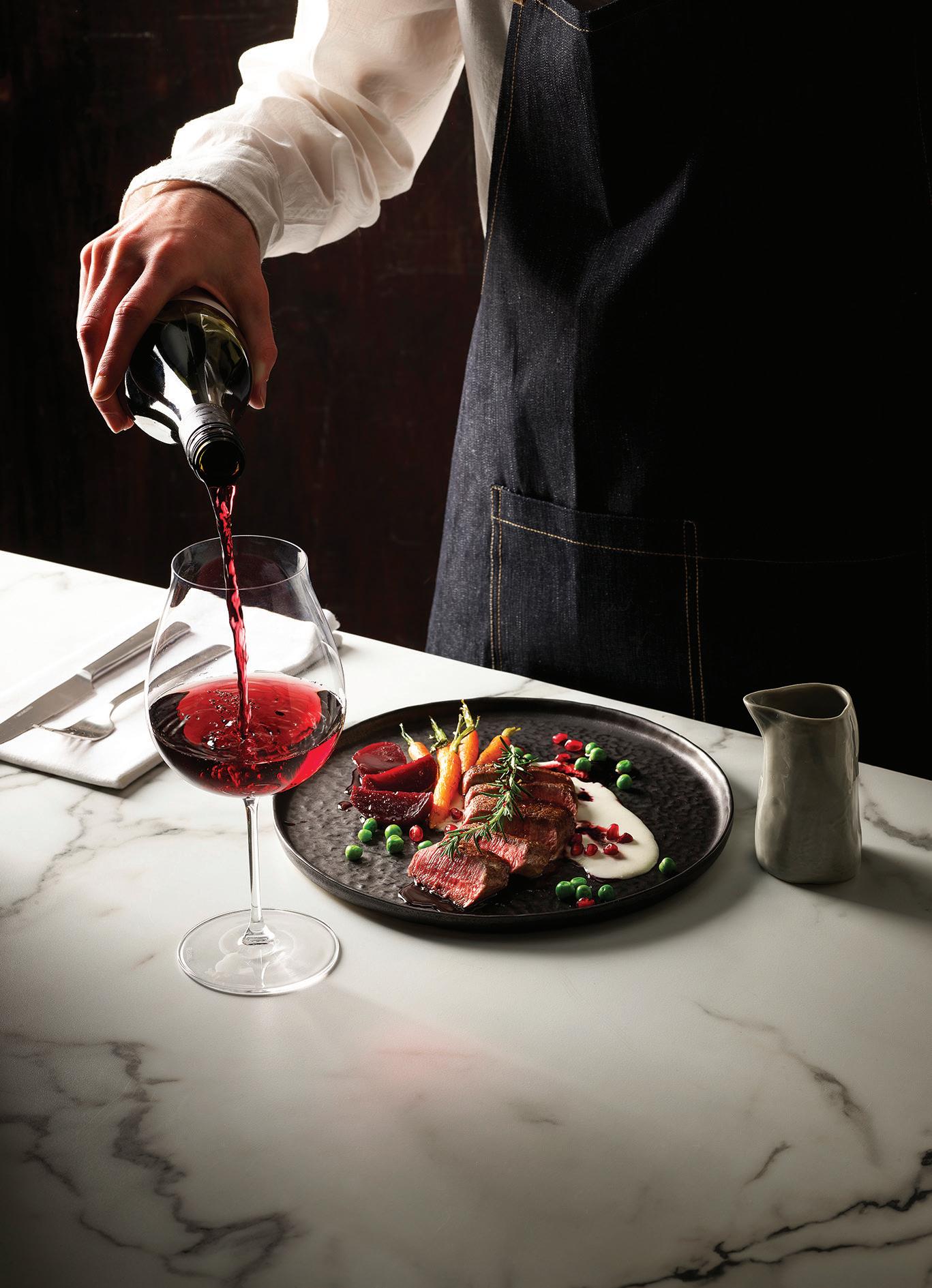
There’s no sulphur, preservative, or fining when producing any Hastings Distillers liqueur or aperitif, and this extends to their vermouth. “The natural wine movement has gathered plenty of momentum in recent years,” notes Kate. “There’s a growing appetite for wines that are low intervention, and we believe that focus will soon shift to fortified wines also. Our vermouths will appeal to anyone who enjoys the textures, flavours and provenance of natural wines.”
Chief
New Zealand Winegrowers has welcomed the election of Dr John Barker to Director General of The International Organisation of Vine and Wine. “Dr Barker is an outstanding New Zealander and has a deep appreciation of the history and traditions of the global vine and wine sector, but also recognises the current opportunities and challenges that our industry is experiencing today,” Chief Executive Philip Gregan says.
To read more about John, go to page 44.
NZW Board appointee
Dr Jo Cribb has been appointed to the board of New Zealand Winegrowers, bringing more than a decade of governance experience on commercial, government and not-for-profit boards. To read more about Jo, go to page 42.
Pinot Celebration
Pinot Noir NZ is returning in Feb 2025. The event Chair is Michael Henley MW, supported by an enthusiastic committee from across New Zealand’s premium Pinot Noir producing regions, made up of Paul Donaldson, Alistair King, Natalie Grace, Ben McNab, Ben Leen, Anna Flowerday, Philippa Fourbet, Helen Morrison, Rosie Finn, and Charlotte Read. More to come, get ready to charge your glass with New Zealand Pinot Noir!
NEW ZEALAND WINEGROWER I AUGUST/SEPTEMBER 2023 I 9 NEWS BRIEFS
OIV
Upcoming events
To have events added to our calendar contact sophie@sophiepreece.co.nz
Spray Days
8 August-14 September
nzwine.com/members/events/ workshops
The Spray Days roadshow – running in wine regions throughout New Zealand –works to connect growers with industry experts and provide best practice advice.

– is the focus of a viticulture conference and field trip, held in collaboration with the Young Viticulturist Final in Hawke’s Bay. NIWA will kick off the conference at Linden Estate in Esk Valley, and an afternoon field day will head further up the valley, then out to Gimblett Gravels, where local viticulturists will discuss findings from some of their latest trials.
NZW Members’ Meeting
31 August
nzwine.com/members/about-us/ governance
The New Zealand Winegrowers Annual Members’ Meeting will be held in Hawke’s Bay on 31 August at 3pm. Members can attend in person, or by registering online. To read more go to page 70.
New Zealand International Wine Show
19-21 September
nziws.co.nz
Young Viticulturist
30-31 August
nzwine.com/en/events/young-vit
The 2023 Young Viticulturist of the Year National Final will be held in Hawke’s Bay on 30 August, with an awards dinner the following evening. Competition committee chair Caleb Dennis, who won the National Final in 2015, says the event nurtures the next generation of talented New Zealand viticulturists, celebrates their success, and gives young members of the industry an opportunity to grow, by stretching and challenging their technical knowledge and skills. “At the same time it gives them a platform to showcase their abilities and develop a profile within the industry, which builds their confidence to take on greater challenges.” Caleb says it is “fantastic” to see the industry get behind the contestants.”

To read about the 2023 regional finalists, go to page 55.
Viti Conference and Field Trip
31 August
nzwine.ticketspice.com/2023-viticonference-field-trip
Weather – the good, the bad and the ugly
New Zealand’s biggest wine competition is on in Auckland from 19 to 21 September. Chief Judge Bob Campbell MW says the show, which has been running since 2005, is the high point on his wine tasting calendar each year. The Trophy Awards Event will be held on Friday 13 October at Auckland’s Crowne Plaza Hotel.

Winemaker of the Year competition will run throughout the country in September, before regional winners compete at the National Final in Canterbury on 31 October. The winner will be awarded at the New Zealand Wine, Altogether Unique Celebration on 1 November.
Wine Business Forum
1 November
nzwine.com/en/trade/events/wbf
Focus on the future of your wine business at the NZW Wine Business Forum, before heading to the New Zealand Wine, Altogether Unique celebration. The daylong forum has been designed to inform, inspire and facilitate networking amongst industry members, with presentations from experts and practitioners, offering case studies and practical applications. The programme will build on the industry’s momentum, with a focus on leveraging learnings to advance New Zealand’s position in the world of wine and beverage.
Young Winemaker
31 October
nzwine.com/en/events/youngwinemaker
The 2023 Tonnellerie de Mercurey Young
Altogether UniqueA Celebration
1 November
nzwine.com/members/events
This event will unite winemakers, grape growers, industry partners and media in a celebration of New Zealand’s wine industry from vine to glass. The event will shine a light on the 2023 Fellows of New Zealand Winegrowers, announce the 2023 Young Winemaker of the Year, and recognise outstanding efforts during Cyclone Gabrielle recovery.
XXXXXXXXX 10 I NEW ZEALAND WINEGROWER I AUGUST/SEPTEMBER 2023
Photo Richard Briggs
Chardonnay Symposium
Wine writer Christina Pickard is one of the speakers at the inaugural Aotearoa New Zealand Chardonnay Symposium in Te Matau-a-Māui Hawke’s Bay in October. Christina will provide a writer’s perspective on Chardonnay, delving into the stories that resonate with customers, while shedding light on the trends surrounding fine Chardonnay and its positioning within the American market. “Chardonnay that strikes that delicate balance between power and elegance, lightness and darkness, site expression and winemaker expression, well, there is no wine more gorgeous in all the world,”
Christina says. “It’s a variety that, as a wine professional, I love to write about. And it’s one, as a consumer, that I love to drink.”
Elizabeth Kelly MW, who is currently the buying manager at Majestic, panel chair at the International Wine Competition, and deputy chair of the Sustainable Wines of Great Britain, will lead a benchmarking tasting and give a British wine buyer’s view of the competitive retail market.

“Chardonnay is the most versatile grape
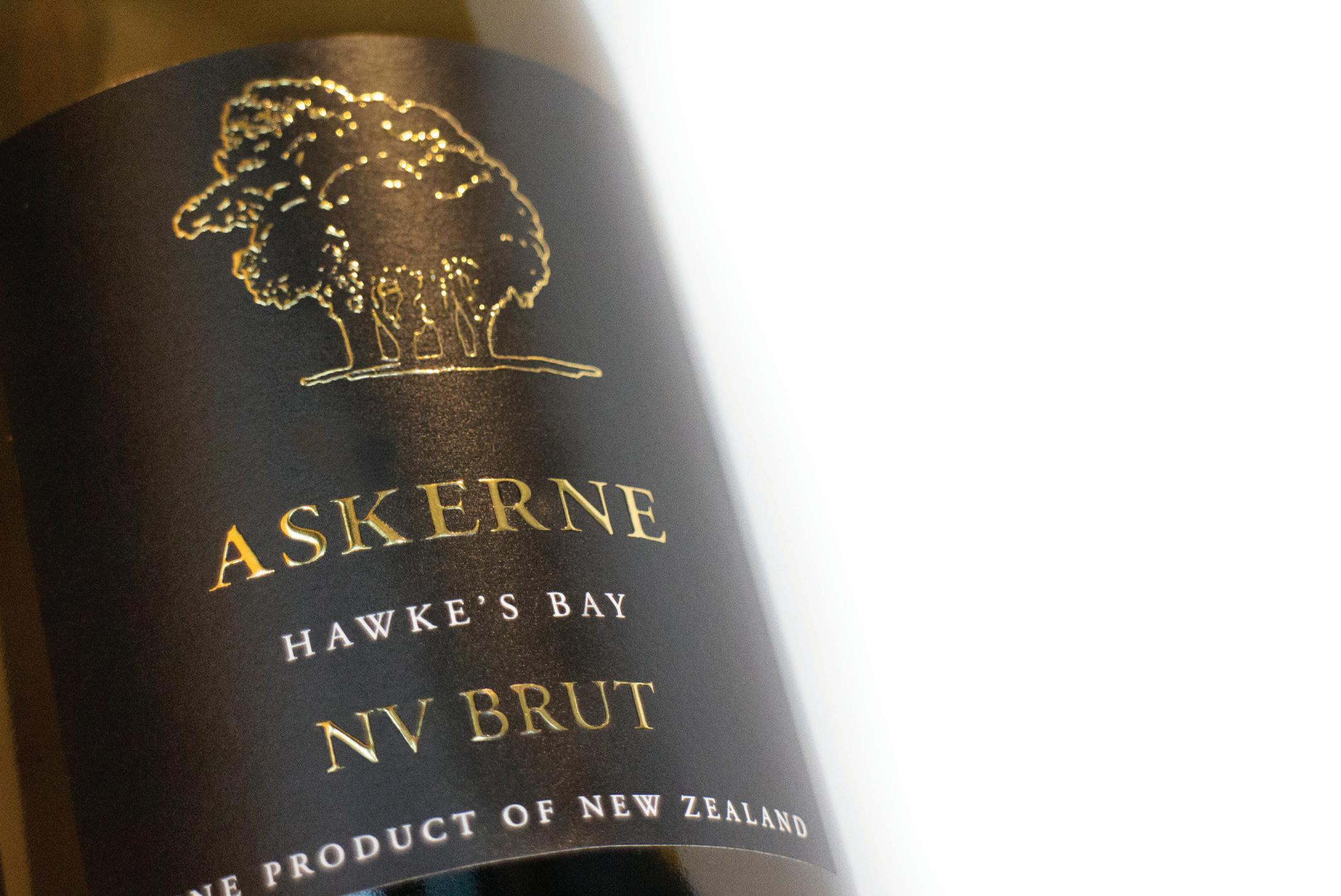
variety, easily adapting to different climates and creating wines that run the gamut from bone dry, mineral-driven wines to big rich buttery styles; and of course the best sparkling wines in the world,” she says. “The diversity of styles ensures there is always something new to discover with this variety and a fresh direction for winemakers to pursue.”
The symposium, organised by Hawke’s Bay Winegrowers (HBWG) in collaboration with New Zealand Winegrowers and the New Zealand Society for Viticulture and Oenology (NZSVO), kicks off with a NZSVO technical workshop on Chardonnay on day one (see page 32) followed by the Great New Zealand Chardonnay Celebration in the newly refurbished laneways precinct of Toitoi. The second day of the symposium will focus on an international perspective on the variety. HBWG Executive Officer Brent Linn says Chardonnay has an extremely important place in the New Zealand wine story, both domestically and internationally, “so we
are delighted to present this symposium, which will take a deep dive into where we are at today and where we want or need to go with this varietal.”
Tickets are now available for the Aotearoa New Zealand Chardonnay Symposium 5-6 October
hawkesbaywine.co.nz/symposium
NEW ZEALAND WINEGROWER I AUGUST/SEPTEMBER 2023 I 11 UPCOMING EVENTS
Award
Floating Foil Explore the possibilities with us. Award winning label print techniques An extensive range of wine label materials Market leading innovative label solutions Creating labels that speak to your brand 0800 865 223 • www.rapidlabels.nz 2023 Licence Number: 807004
Elizabeth Kelly MW
winning
Altogether Unique
Growing the reputation of New Zealand Wine
Read On
Kia ora,
It’s been a great feeling to have finished the financial year having completed the activations of our refreshed brand platform, Altogether Unique, across our five key markets of the United Kingdom, United States, Canada, Australia and China. Hear about the most recent events and innovative approaches to telling our brand story with our inaugural Somewhat Sommit events in Melbourne and Brisbane and Bringing New Zealand to North America, targeting Canadian and US trade and media through one impactful event (see facing page).
Also check out the impressive stats from the Pour Yourself a Glass of New Zealand campaign, now in its second year, celebrating our most exported white wine varieties each May. The resulting equivalent media value of New Zealand Wine brand mentions doubled that of year ago, reflecting that consistent, continued brand investment pays off.

In order to more accurately reflect the work of the New Zealand Winegrowers (NZW) marketing team, the name of this function will move to Brand. This has recently been endorsed by the NZW Board. Misha Wilkinson, chair of the brand committee, says the activities undertaken by NZW around the world are all about positioning the New Zealand wine brand so that it’s seen as unique, premium and authentic, and represents diversity in terms of region and variety. “This work benefits our entire membership with the brand being one of the most critical factors in the premiumisation of New Zealand wine. It simply makes more sense to refer to this work under a Brand heading rather than Marketing.”
Our focus on brand is reflected in the theme of our inaugural Wine Business Forum on 1 November, ‘The Importance of Brand’. Please check out our events page for details – we hope to see you there.


 Kia kaha, Charlotte Charlotte Read is NZW General Manager Brand
Kia kaha, Charlotte Charlotte Read is NZW General Manager Brand
Category & Consumer Insights
Richard Lee, NZW Intel and Insights Specialist, recently presented an overview of New Zealand wine in the domestic market alongside three trade and research professionals across grocery (Haydn Jones – Wine Category Manager, Countdown), online retail (Holly Brendling – General Manager, Black Market) and on-premise (James Phillips – Client Solutions Director, CGA by NielsenIQ). The session provided insights about New Zealand wine consumers in the domestic market, overlaid with insights from the guest speakers who interact with consumers and suppliers on a daily basis. A record number of members attended, reflecting the relevance of this topic. See the research, presentation and recording at nzwine.com/members/events/ webinars/category-consumer-insights.
Pour Yourself a Glass of New Zealand
For the second year, Pour Yourself a Glass of New Zealand, NZW’s monthlong celebration of New Zealand’s white wine varieties, concluded at the end of May. The campaign not only shone a spotlight on the breadth of high-quality white wine that New Zealand produces but was also the drive behind the campaign for the white wine emoji, which once again was an attention-grabbing headline globally.
Somewhat Sommit
NZW is focusing activity in the Australia market on influencers in the on-premise channel, targeting sommeliers, and conducted events in both Melbourne and Brisbane in June. The event format was an in-market adaption of the original Sommit concept, led by Cameron Douglas MS and Stephen Wong MW. Working in partnership with Sommeliers Australia, the 28 places for this application-only initiative were quickly snapped up. A trade tasting was held in the afternoon and attracted 80 attendees over the two cities, including key buyers from major retailers.
12 I NEW ZEALAND WINEGROWER I AUGUST/SEPTEMBER 2023
New Zealand to North America


The recent ‘New Zealand to North America’ event was worth the wait, with six Kiwi winemakers and viticulturists meeting 20 key influencers from across the United States and Canada. One of the attendees to the three-day, two-night “immersive wine experience” – originally intended for 2020 –was Gillian Sciaretta, Corporate Wine Buyer at Gary’s Wine & Marketplace, which has stores in New Jersey and California. She shares some insights.
There were more than 80 wines from 10 regions and 18 varieties/styles at the event. How important is it to see the breadth of New Zealand winemaking?

It is extremely important. Right now the American consumer is more openminded than ever when it comes to selecting wines. By demonstrating that New Zealand has so much to offer when it comes to winemaking styles, grape varieties and terroirs, it allows me as a wine buyer to bring this message forward and help change the consumer’s mind as seeing New Zealand being more than just Sauvignon Blanc.
Which masterclasses were a highlight?

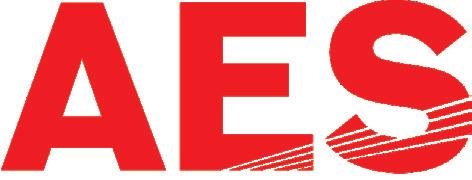
I particularly enjoyed the roundtable discussion on sustainability. New Zealand


is on the forefront of sustainability when it comes to the full scope of the winemaking process and getting the wine shipped to various markets across the world. This is a topic that is only going to become more important to the American consumer, so being able to discuss what New Zealand is doing better than almost any other country, collectively, is fantastic. I also enjoyed the Pinot Noir and Chardonnay Masterclass because these are some of the most in demand varieties for our guests. And with red Burgundy becoming more scarce and expensive, and Oregon and California Pinot Noir being
increasingly threatened by fire seasons, there is a growing need for high-end Pinot Noir from other areas. I think this presents a great opportunity for New Zealand Pinot Noir.
What’s the appetite for New Zealand wine in the US market? The New Zealand category in our New Jersey stores is and has been dominated by value-driven Sauvignon Blanc from reliably consistent brands. Consumers are very brand loyal when it comes to their New Zealand Sauvignon Blanc. I don’t see that slowing down anytime soon. But I think there is opportunity to expand that appetite to other categories as the consumer becomes more open-minded. It also takes partnering up with key retailers, like Gary’s, who take the time to tell the stories behind the wines, train employees accordingly, and have a trusted relationship with their customers when it comes to new recommendations.
NEW ZEALAND WINEGROWER I AUGUST/SEPTEMBER 2023 I 13 ALTOGETHER UNIQUE
“Right now the American consumer is more openminded than ever when it comes to selecting wines.”
Gillian Sciaretta
ALBERTI HOT CLEANERS
230 & 400 Volt 1440 RPM motor
8
5000 psi
petrol engine • 10 models from 1800 to 5000 psi
UDOR
plunger pump & gear-box TORNADO RANGE ELECTROBLAST RANGE
• UDOR ceramic plunger pump • Heavy duty 1440 RPM motor • 230 & 400 Volt • User Friendly Sales & Service Dealers throughout New Zealand • Freephone 0508 78 78 78 • www.aesblasters.co.nz H High quality products at a competitive price H
NZW’s ‘New Zealand to North America’ event
•
•
models from1600 to
• Genuine Honda
•
ceramic
WATERBLASTERS
Vintage 2023
Welcome balance of quality and quantity
SOPHIE PREECE
New Zealand’s 2023 grape harvest came in 6% lighter than the heavy hitter of the previous year, with a total yield of 501,000 tonnes, down from 532,000 in 2022.
The latest harvest represents something of a Goldilocks zone, with enough wine to meet the market and take many companies through to the 2024 vintage, says Clive Jones, Chair of New Zealand Winegrowers (NZW) and General Manager of Nautilus Estate in Marlborough. “We probably have 12 months’ supply and if we have 13 months’ supply that’s not a problem,” he says, comparing the situation to 2021, when a small harvest and stellar demand saw a shortage of New Zealand wine in key markets. That led companies to bottle and ship the big 2022 crop (44% higher than the previous year) early. “The supply chain is reasonably full now and shipping is better, so we’re probably back to a more regular ordering pattern.”
NZW Chief Executive Philip Gregan says many in the industry will welcome the drop in harvest numbers. “I don’t think anybody wanted to have another vintage the same size as last year. I think people were thinking a slightly smaller vintage would keep the demand supply balance more where it should be.” He says pipeline
Billions in booming exports
SOPHIE PREECE
filling in 2022 saw exports “early out of the blocks”, but the supply situation has now normalised, and the industry can focus on its “underlying strength and growth of sales”.

In Marlborough, vintage yields were down 5% on the bumper 2022 harvest, but the region nonetheless supplied 393,865 tonnes (81.3%) of the total 2023 vintage. Clive reports a nice balance between quality and quantity this year. “Quality was very, very strong at a base level with a nice level of highlights.” In general, the wines from 2023 are “much better than 2022”, with Pinot Noir (yielding 6.3% of the national pick) particularly strong, and Chardonnay (4.6%), Albariño, and Pinot Gris (5.4%) “outstanding”. Sauvignon Blanc, making up 78.1% of total production, is also “brilliant”, he adds. From a Nautilus perspective “there
wasn’t a bad tank in the winery”, Clive adds, comparing that to 2022 when they had a more challenging time at blending. As a result consumers will find great quality and value in even the lower tiers of wines. “Our Twin Islands blend is probably the best we’ve had for 20 years.”
Moreover, it was a Marlborough vintage many winegrowers enjoyed, after three extraordinarily difficult vintages in a row – 2020 for its Covid-19 national lockdown and rigorous rules for operating as an essential service; 2021 for its very light yields and tight labour supply; and 2022 for its record breaking crops, a vintage workforce decimated by the Omicron variant, and market clamouring for more wine.
In contrast, the region’s 2023 vintage started out with tension over inclement
A burgeoning appetite for Sauvignon Blanc in the United States is helping drive New Zealand wine sales, with exports hitting $2.4 billion in the year to May. That’s up 25% on 2022 and testament to the increasingly strong global demand for New Zealand wines, says New Zealand Winegrowers (NZW) Chief Executive Philip Gregan. “New Zealand wine, particularly Sauvignon Blanc, is going from strength to strength in the USA.”
Clive Jones, Chair of the NZW board and General Manager of Nautilus Estate in Marlborough, says a bumper 2022 vintage allowed companies to replenish empty supply lines after the extremely light 2021 harvest failed to meet a lockdown-surge in retail sales. That replenishment, which saw many New Zealand companies bottle earlier than ever last year, played a role in the 25% leap in export sales. But an upward trend in demand, led by the US market, is also a key driver. “Sauvignon is a growth category in the US and we are the premium product in this category,” Clive says. “We make a very distinctive wine and this is driving demand.”
In more established markets like the United Kingdom, New Zealand wine is holding its premium, he adds, referencing Nielson data that shows that in major markets New Zealand Sauvignon is selling at a higher price than the market and the vast majority of its competitors. “So we are driving premiumisation in the Sauvignon category internationally.”
The combination of premium price, along with surging demand in the US is “a great news story for New Zealand”, Clive says. “We are gaining market share and we are gaining market share at a premium price.” Sauvignon Blanc, which accounted for 76.5% of the 2022 vintage and 78.1% in 2023, remains the winning card, he adds. “From a diversity point of view we are having some success with other varieties, but it is hard to come out of the shadow of Sauvignon.”
14 I NEW ZEALAND WINEGROWER I AUGUST/SEPTEMBER 2023 VINTAGE SURVEY
Daren Clark, Roots Fund Scholar from Greene County Virginia, hand sorting Pinot Noir, Photo by Richard Brimer

NEW ZEALAND WINEGROWER I AUGUST/SEPTEMBER 2023 I 15 VINTAGE SURVEY
weather, then surprised many with a second summer and lingering finish, Clive says. “Every vintage has challenges, but 2023 was back to a vintage we could enjoy and a reminder of why we do it”. That was certainly not the situation for all growers, with North Island regions hammered by wet weather that culminated in Cyclone Gabrielle hitting harvest hard. But Clive notes the Marlborough harvest is vital for the ongoing health of the national industry. “The fact that Marlborough got the crop home from a New Zealand Wine Inc. perspective puts us in a good position.”

James Dicey of Dicey Wines and Grape Vision in Central Otago is excited by the potential of the 2023 vintage, which is 5% down on the region’s generous 2022 crop. He was pleased with the quality of 2022, but says this year’s fruit, with smaller berries and lower yields, was even better. Rainfall just after veraison in 2022 resulted in an uplift in berry size, while a hot finish to summer carried the harvest home. The 2023 season looked on a similar path, thanks to the La Niña weather pattern, which is painful for much of New Zealand but favourable to Central Otago growers. However, a rainfall event this year happened later, so that berries were smaller with slightly higher quality, says James. “More intensity of flavour and more focus in the flavour of the wines in both aroma and taste.”
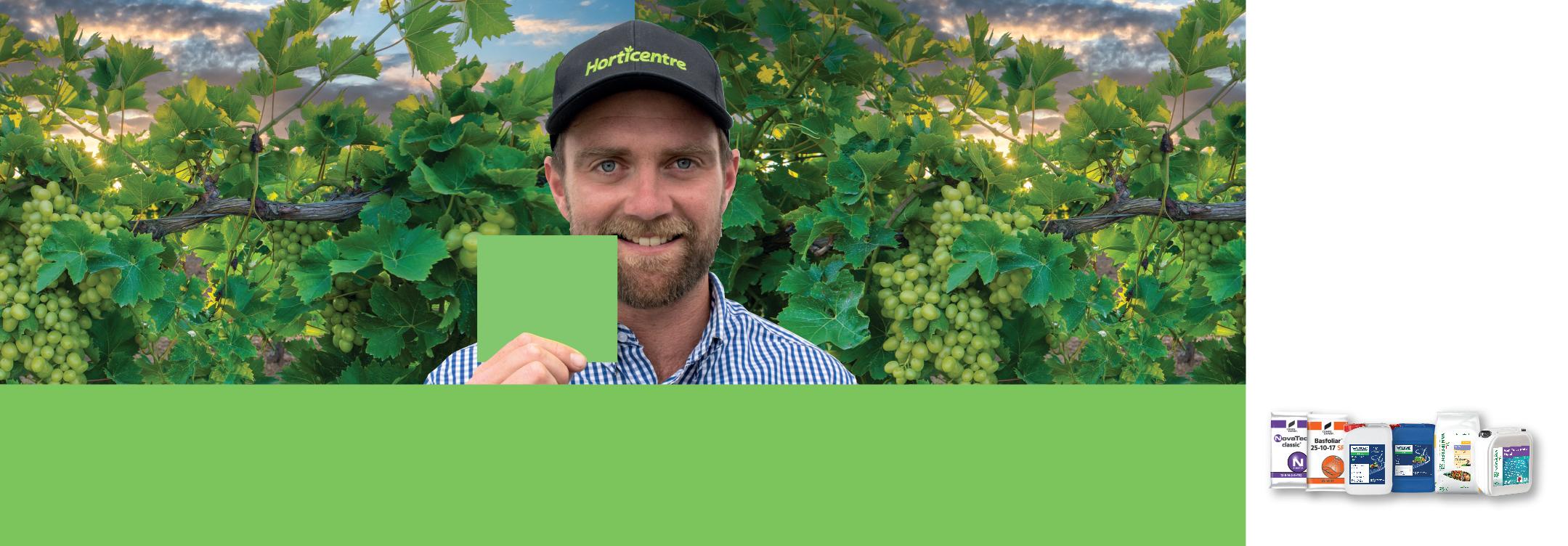
In mid-March “La Niña turned off like a big light switch”, and Central Otago plunged into spring-like conditions, with some days moving from rain in the morning to sunshine after lunch to snow flurries in the evening. James had anticipated a concentrated harvest due to the lower yields, but the shift in weather resulted in one of Central Otago’s longest harvests ever. The cool weather made for a longer
ripening period than 2022, “and we’re pretty excited about what that means”.
Hawke’s Bay recorded a 4% drop in yields for 2023, despite the impacts of the mid-harvest cyclone, which was disastrous for some. Hawke’s Bay Winegrowers Executive Officer Brent Linn says the data was a pleasant surprise, with potential for far greater losses had it not been for the late second summer that saw some of the region’s key varietals, especially later ripening reds, “presenting beautifully at vintage”. However, he notes that wine companies may feel demand pressure with the harvest decline, as surging export sales had seen many work through strong stock levels from the earlier “stellar” vintages. “Growers are looking forward to a return of an El Niño weather pattern and the opportunity to build back stocks.”
Philip says the South Island had an
excellent vintage overall. And while the North Island had a tough year, producers were largely very happy with the quality of the 2023 harvest. “Regions across the North Island were hit hard by the unprecedented wet weather throughout summer, but their incredible hard work and commitment to producing premium quality wines means that consumers will continue to enjoy the distinctive wines that they know and love.”
There is some uncertainly for companies, given inflation and tax changes in markets like the United Kingdom, “and no one knows how that will impact demand for New Zealand wines”, Philip says. But he notes the New Zealand has historically performed well in economic “ups and downs”. And demand – especially for Sauvignon Blanc – remains strong, he adds. “Particularly out of North America.”
16 I NEW ZEALAND WINEGROWER I AUGUST/SEPTEMBER 2023 VINTAGE SURVEY
Marlborough’s Awatere Valley Vintage 2023. Photo Richard Brimer
Power Farming represent a number of top-quality tractor and machinery manufacturers and provide the coverage throughout New Zealand to back-up what we sell.

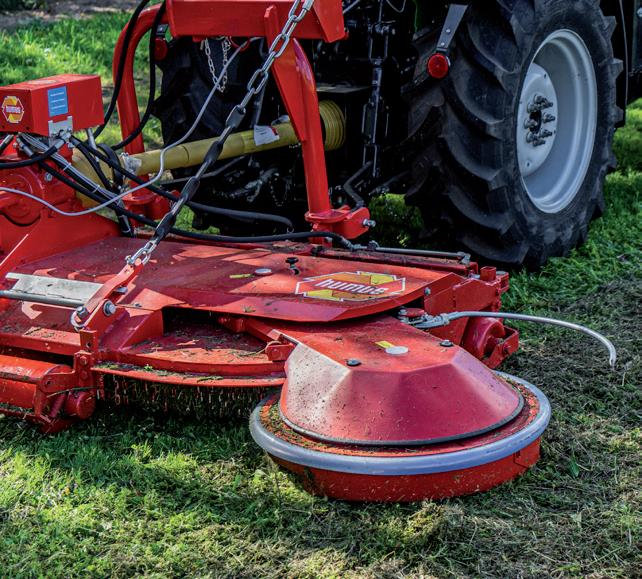

Our parts and service specialists have access to hubs situated in the North and South Islands, meaning we can deliver parts and service for most makes and models of machinery quickly, ensuring sure your equipment is kept operating at its best.
Contact your local dealer to discuss what could work for your business.
CONTACT US TO TALK ABOUT OUR VITICULTURAL AND
MANUFACTURERS:

Farming NZ Talk
us
viticulture
requirements We offer a vast range of tractors suited for viticulture. Choose from various options such as flat operator platforms and numerous horse power options in either RoPs or cabin models. Our mulchers and mowers offer the latest in technology from some of the most innovative and trusted manufacturers from around the world. WHANGAREI 09 438 9163 PUKEKOHE 0800 570 571 TAURANGA 07 543 0021 WHAKATANE 0800 77 88 99 TE AWAMUTU 07 870 2411 MORRINSVILLE 07 889 5059 ROTORUA 07 349 6528 GISBORNE 06 868 8908 HAWERA 0800 480 309 HASTINGS 06 879 9998 FEILDING 06 323 8182 MASTERTON 06 370 8240 NELSON 03 544 5723 BLENHEIM 03 573 7089 GREYMOUTH 03 768 4370 CHRISTCHURCH 03 349 5975 ASHBURTON 03 307 7153 TIMARU 03 687 4127 DUNEDIN 03 489 3489 GORE 03 208 9395 INVERCARGILL 03 215 9039 CONSTRUCTION
Power
to
about your
machinery
HORTICULTURAL

19 I The whole package Moving beyond glass 21 I Wine in a Keg Everyday Wines 22 I Wine in a Can The Uncommon 24 I Wine in a Box Dice by Dicey 26 I Wine in Cardboard Frugal
The Focus
The Whole Package
Alternative packaging for wine is an exciting global discussion, but only a handful of New Zealand wine brands are looking beyond glass. In this series, NADINE WORLEY – winemaker, Te Pūkenga wine lecturer, and founder of the Fugitive wine-in-a-keg label – explores other options, and talks to New Zealand companies leading the charge for change.
A masterclass beyond the glass
NADINE WORLEY
Glass bottles have overwhelmingly been the packaging of choice for winemakers since large-scale production started in the 17th century. The glass bottle is intertwined with the image and tradition of wine, and there are many things to love, including its strength and inherent properties, which protect wine from oxygen while still allowing it to age.
But 400 years on from that transformation, the environmental impact of single-use glass bottles is a concern, and many New Zealand wine companies have adopted low-weight bottles to reduce their carbon emissions. Meanwhile, alternative packaging formats such as bag-in-box, aluminium cans, Tetra-style packs, paper bottles, and wines on-tap from keg, provide an opportunity to reduce this footprint further. Many of these alternatives also can be adapted to smaller serving sizes, offering consumers greater choice and promoting moderate drinking.
Lifecycle assessment (LCA) studies examine the environmental impact of all stages of wine production, including vineyard, winemaking, packaging and distribution, and disposal. LCAs overwhelmingly show glass bottles are the single biggest contributor to a wine’s carbon footprint. A review of all current wine LCA studies published in the Journal
of Sustainability concluded the bottling and packaging phase contributes 40-90% of wine’s carbon emissions, depending on bottle weight and transport. The average carbon footprint of a bottle of wine can vary, but most recent studies show it sits at about 1.25kg CO2e (carbon dioxide equivalent*) and the majority of this is attributed to the glass bottle. This is due to the intensive energy and heat required for the glass melting process, in addition to the CO2 released as a result of the decomposition of carbonates during glass production.

One of the benefits of glass packaging is its infinite recyclability, and the Glass Alliance has shown these emissions can be decreased with the inclusion of recycled content. But with each 10% increase in recycled glass content, CO2 emissions are only reduced by 2%. According to the Packaging Forum, 71% of all glass in the New Zealand market is recycled, while 14% goes to roading, 6% is stockpiled, and 7% heads to landfill.
Globally, the discussion around the environmental benefits of packing alternatives for wine is gaining momentum. A United Kingdom-based group, the Wine Traders for Alternative Formats (WTAF), have a live count of the carbon footprint of single-use glass wine bottles in the
UK so far this year – at last check, it was 1,263,579,700 kgCO2e. In 2022 the group penned an open letter signed by some of the leading UK wine writers, including Jancis Robinson and Hugh Johnson, calling for a shift to alternative packaging for wine. The letter claims a switch from glass to alternative formats could save as much as 750,000,000 kgCO2e of emissions every year in the UK alone. This is the equivalent of taking 350,000 cars off the road overnight and equates to well over a third of the carbon footprint of wine consumed in the UK.
A study commissioned by the alcohol monopolies of Sweden, Finland and Norway compared the CO2 emissions of different wine packaging, and the results were pretty stark. Heavy glass bottles have by far the highest carbon impact. PET (polyethylene terephthalate) bottles and cans had less than half the carbon footprint of even the lightest glass, with bag-in-box having the lowest overall emissions per litre (see graph page 20).

NEW ZEALAND WINEGROWER I AUGUST/SEPTEMBER 2023 I 19 THE WHOLE PACKAGE
Photo on facing page. Uncommon co-founders Anna Campbell, left, and Hannah Sweeney
© Copyright 2021 Farmgard Ltd. All rights reserved. Specifications are subject to change without prior notice.
*Carbon dioxide equivalent – expressed as CO2e in these stories – is a standard unit for measuring carbon footprints.
The Berti Ecosprint has a patented rotor with 8m of nylon per spool, which can be easily extended when worn, and will tackle the harshest of weeds without damaging the vines.
CALL FARMGARD 24 HOURS 0800 FARMGARD FIND OUT MORE AT farmgard.co.nz Nationwide Dealer Service Network 35 years, Generations of Experience
A fast, commercially viable alternative to sprays which won’t damage vines.
The Wine Society (UK) released a study in May this year that explored the environmental performance of various packaging formats that could provide an alternative to single-use glass bottles. They chose six packing formats – bagin-box, beverage carton (Tetra Pak style), aluminium can, paper bottle, pouch, and recycled PET, and then reviewed their impacts on the environment, wine quality, consumer attitudes, and recyclability. They found bag-in-box and recycled PET bottles had the best potential for carbon emission savings and advantages for consumers.
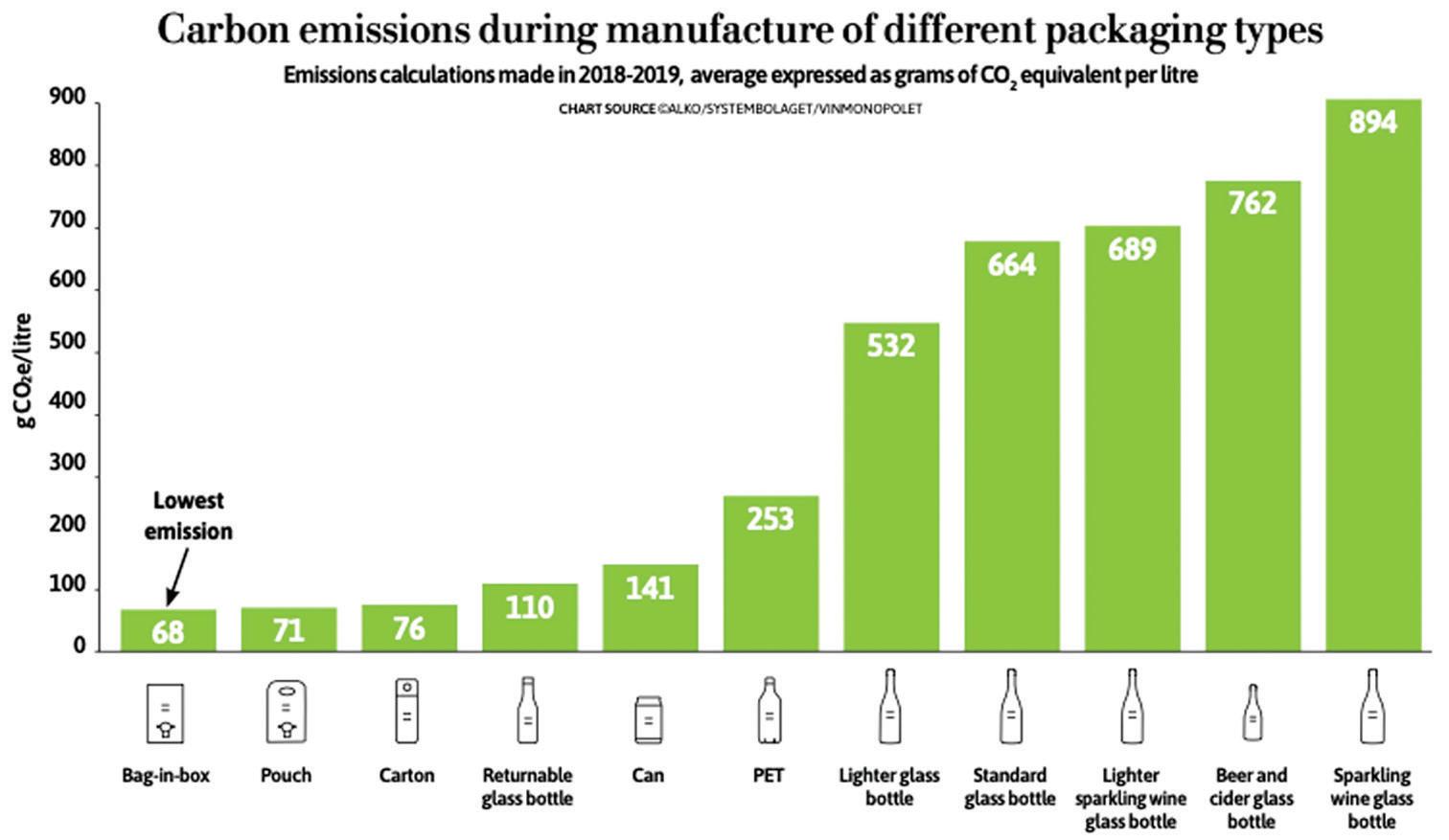
Alternative options are not the only way to reduce the carbon footprint of wine packaging. Lightweight bottles combined with shipping in bulk and bottling in market can have a significant impact.
An LCA conducted by the Australian Wine Research Institute showed using lightweight bottles (330g compared to 500g) can reduce the overall LCA impact of wine by 18%. And the New Zealand
Crushing carbon footprints
SOPHIE PREECE
Teaching wine students about the carbon footprint of wine convinced Nadine Worley to be part of leading the change. In her day job at Nelson Marlborough Institute of Technology, Te Pūkenga, Nadine talks repeatedly about the carbon cost of wine packaging – with up to 60% of the 1.28kg carbon footprint of a bottle of wine down to the production and shipping of glass. And in her side hustle at Fugitive Wines she walks the talk of alternative packaging with business partner Logie MacKenzie, a viticulturist who is equally
Winegrowers 2022 Sustainability Report states 55% of wineries are using lightweight bottles as one of their methods of packaging.
Although no non-glass packaging is
the perfect solution, the overwhelming environmental benefits, improved convenience, and increased options for serving size have now made alternative packaging a viable option.
frustrated by the 400-year-old status quo. Now they produce organic Sauvignon Blanc and Pinot Noir sold only in reusable kegs and bottles, tapping into a consumer
market open to conscientious change, Nadine says. “Every time we reuse a glass bottle or refill a keg, we can halve its carbon footprint.”

Swiss precision. Made to last.
FELCO 211 LOPPERS


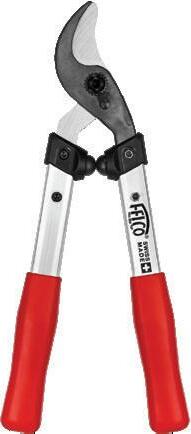


The perfect balance of power and manoeuvrability.
FELCO POWER TOOLS

Power through even the biggest jobs with ease.
Designed to act as an extension of your body, the new FELCO Power Blade series feature lightweight, ergonomic handles for comfortable pruning all day long.
20 I NEW ZEALAND WINEGROWER I AUGUST/SEPTEMBER 2023 THE WHOLE PACKAGE
Available at your local FELCO Stockist. Heiniger is the exclusive FELCO distributor and authorised service centre in NZ - contact us to find a FELCO dealer near you. (03) 349 8282 | heiniger.co.nz
Nadine Worley and Logie MacKenzie. Photo Lisa Duncan
The FELCO 211 range feature lightweight aluminium handles for comfortable cutting and curved cutting heads to pull in and easily slice through branches.
NEW
Wine on Tap –Everyday Wine
NADINE WORLEY
Packaging wine in kegs and then dispensing through taps is becoming a popular option for bars and restaurants in New Zealand and overseas. Wine is filled into either reusable stainless-steel kegs or single-use kegs, such as the key-keg system. The kegs are then connected to a refrigerated wine dispensing system, which allows the wine to be served on demand through a tap, just like beer. Wines are dispensed under pressure using an inert gas (usually nitrogen) which also protects the wine from oxidation. Wine in kegs minimises waste, both in wine and packaging, and ensures a wine served by the glass is not oxidised, which is a big advantage, especially for onpremise retailers. There also are significant environmental benefits of reusing kegs; a lifecycle analysis (LCA) from the University of California showed a stainless-steel keg reused 100 times had a carbon footprint 95% lower than single-use glass bottles.
Dan Gillett is leading the way in New Zealand with wine on tap through his Wine Diamonds distribution business and Everyday Wine retail store. The journey into wine on tap started when Dan, thenowner of Scotch Wine Bar in Marlborough, started looking for a way to serve natural wines (with no added sulphite) by the glass, without having them oxidise or lose quality once the bottle was opened. “I thought beer in kegs doesn’t oxidise, so why not look at it from a wine perspective?” He dug a bit deeper into wine in kegs, and in 2018 started with a trial of a preservative-free Sauvignon Blanc on tap. “We did a trial run of about 100 kegs, and it went well; the wine was delicious, and it held perfectly in keg; it
just worked on every level”.
One of the early challenges was the lowquality perception of wines on tap. “There was a perception that wine on tap was just cheap and crap. So, I thought, what if I actually prove to good producers that you can put a wine on tap, and it would be as delicious – if not better – than the bottled product if it was poured by the glass? I managed to get a couple of really good producers on board with the concept, and it grew from there.” While there will always be customers who love the ritual of pulling the cork on the bottle and having it on the table, “I have always fought really hard to have really good wine on tap”, he says.
Wine Diamonds now has about 40 different wines available on tap covering all styles, from sparkling to Rosé and reds, from New Zealand to Australia, France, Spain and Italy. They own and manage more than 200 taps in bars and restaurants throughout New Zealand. During the past few years, they have brought the whole system in-house and now own all their stainless-steel kegs, which they pick up and deliver, wash and refill at various wineries around the country. Logistically, Dan says this is easier to manage than bottled wine. “When you move one keg, it is the same as 27 bottles of wine. Kegs can ship around the country without freight issues – couriers can’t drop a keg and smash it to bits which is quite handy too.”
Another big plus for wine on tap is the
LIKE A FINE WINE, OUR STAINLESS STEEL TANKS ARE CRAFTED WITH PRECISION, CARE AND EXPERTISE. With a legacy spanning decades, DTS is a trusted supplier of vats and tanks to New Zealand’s food and beverage industry.
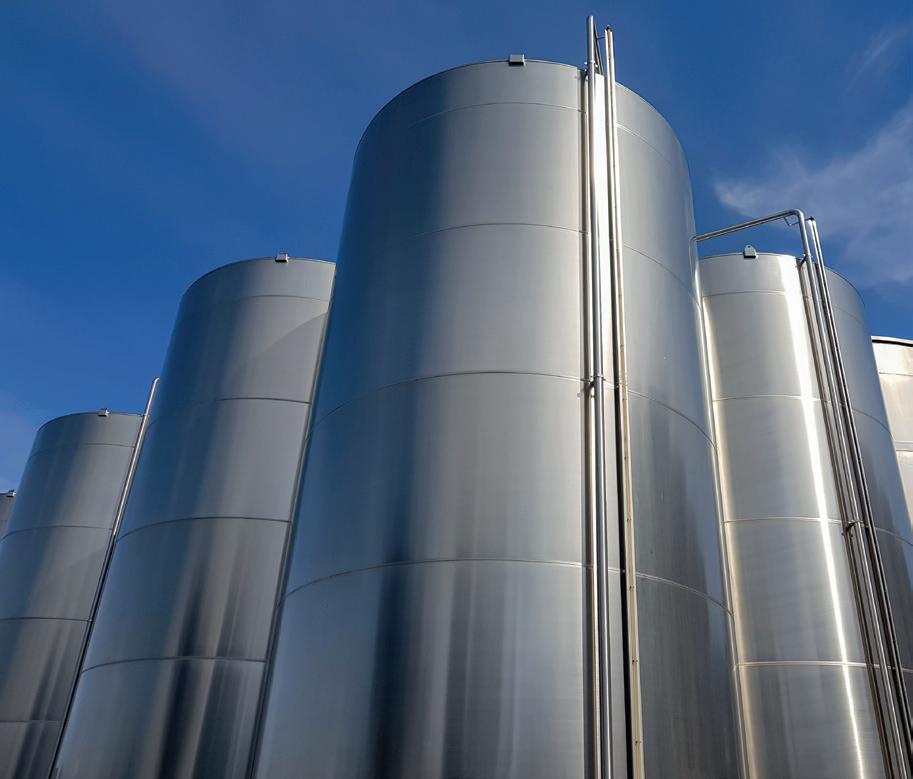

Our expert engineering team can deliver bespoke cooling and heating systems, tailored precisely to your requirements. Call DTS for a no-obligation chat about your next tank.
environmental benefits and zero waste. Dan says this has been a huge driver for the Everyday Wine retail store. They provide wine in reusable swing-top bottles, and customers come in and refill their wine from the rotating selection of wines available on tap. They have a core customer base of “people who are environmentally conscious and really want to reduce their waste and not make such a dent in the environment”, he says. “One keg is equivalent to three cases of wine and removes all the waste associated with that –bottles, labels, caps, cartons and dividers.”
NEW ZEALAND WINEGROWER I AUGUST/SEPTEMBER 2023 I 21 THE WHOLE PACKAGE
“I have always fought really hard to have really good wine on tap.”
0800 500 387 | WWW.DTS.CO.NZ
Dan Gillett
PH:
Wine in a can – The Uncommon
NADINE WORLEY
Wine in cans is in no way a new concept. The first canned wines were released in the United States in the 1930s, and since then, various iterations of canned wine products have appeared and disappeared from our shelves. It now looks like canned wine is here to stay, with the format seeing increasing popularity, especially in the US, but also the United Kingdom and Australia.
In 2021 the global canned wine market was worth $USD235.7m and is estimated to surpass $USD570m by 2028. According to a report by ‘Research and Markets’ out of Australia, canned wine in Australia is expected to show annual growth of 5-10% over the next five years. The report showed this growth has been fuelled mainly by millennials and Gen Xers.
In the early days, it was the convenience, quick chilling and individual serving size of canned wine that gave it a boost. But recently, it is the environmental advantages of canned wine that are fuelling much of the growth. The carbon footprint per litre (CO2e/L) of wine in a can is 70% less than in lightweight glass bottles. According to the Packaging Council of New Zealand, just like glass, aluminium is 100% recyclable, but unlike glass, recycling aluminium requires only 5% of the energy and produces only 5% of the CO2 emissions compared with primary production.
However, canned wine still faces several barriers, including quality perceptions by consumers and trade, shelf-life limitations, and resistance in traditional wine markets. One of the early challenges to canned wine was concerns over quality, with some wines plagued with sulphide aroma issues. A research project at the Australian Wine Research Institute (AWRI) has been looking at understanding and mitigating the development of reductive characters in canned wine.
So far, the study has shown high levels of copper and chloride in a wine can increase the chance of pitting in the internal surface coating of the can. If this protective barrier is corroded, there is potential for aluminium transfer into the wine. This aluminium can then react with sulphur dioxide (SO2) in the wine to form hydrogen sulfide (H2S) in a pathway which doesn’t exist in glass bottle wines. The study highlighted the need for selecting wines suitable for canning and understanding and mitigating the main risk
factors – wine pH, along with Copper, SO2 and Chloride concentrations.
One company that has launched wine in can both in the UK and New Zealand markets is The Uncommon. While living in the UK, Hannah Sweeney worked with The Uncommon Wine of England – a startup wine brand putting local UK sparkling wines (mainly Pinot Noir and Bacchus) in cans. In 2021 she returned to New Zealand and saw a gap in the market. “I noticed the trend of craft beer and RTDs in cans, but being a wine lover, I felt a little left out”. She joined forces with the UK team and with her co-founder Anna Campbell, set about to create The Uncommon Wine of New Zealand. Currently, they have a single vineyard Sauvignon Blanc and a Pinot Noir Rosé in can.
While the team at The Uncommon saw the US market embracing canned wine since the early ‘noughties’, they found the stigma attached to wine in cans in UK and New Zealand a bit harder to shake. In 2018, when they first launched in the UK “they were laughed out of many rooms”, Hannah says. “It’s pretty, but our premium customers won’t drink wine out of a can.” They have slowly but surely seen a change. “We’ve witnessed first-hand the shift in consumer perception and the market evolve in the UK, and we’re confident we will see the same in New Zealand.”

She believes this change in perception is driven primarily by three factors: improvements in quality, increased awareness in sustainability, and changing
consumer lifestyles. “Just as we’ve already witnessed with the craft beer, RTD, and canned cocktail movement – so the shift is happening. For some reason, wine still clings to unnecessary tradition.”
Their key market leans female, but Hannah says they are linked by interest and affinity rather than demographic. She says they are interested in nature, local products, and sustainability, but have a surprisingly broad age range, from 25-60. Hannah has seen more people wanting to make a sustainable choice. “79% of CO2 emissions could be cut from switching a 75cl glass bottle to three 250ml aluminium cans. The can also chills fast, is lighter to transport, and is more easily and endlessly recyclable.”
She doesn’t see the can replacing the wine bottle and says there will always be occasions where the bottle will reign supreme. But she sees cans sitting alongside bottles and offering consumers choice, especially younger drinkers. “It goes where no glass bottle has (successfully) gone before – al fresco gatherings, picnics in the park, beach strolls, hiking, boating, camping, etc. and appeals to the younger more mobile consumer of wine. One the global wine trade is desperately trying to attract.”
And what about the quality concerns?
“Excellent wine not only survives but thrives in cans,” Hannah says. “We have a double lining to ensure no liquid touches the aluminium. The quality of the wine itself is no different to what you would find in a glass bottle.”
22 I NEW ZEALAND WINEGROWER I AUGUST/SEPTEMBER 2023 THE WHOLE PACKAGE
ProWein report on adoption of alternative packaging
Wine merchants expect consumers to adopt alternative packaging, and especially wine in bag-inbox containers and aluminium cans. That’s one of the findings of the ProWein Business Report 2022, which polled nearly 2,500 merchants and producers from 16 different countries on the adoption and planned launch of six different alternative packaging formats. “The aim was also to better understand the drivers of, and obstacles to their further market penetration,” says the report.
ProWein found that in “innovative countries”, almost every merchant intends to list wine in alternative packaging over the next two years. “Innovators are experienced in improving adoption rates by intense communication with users and by small mark-ups for alternative packaging.”
In the ProWein Business Reports 2019 and 2020 more than 80% of those polled said the wine industry was increasingly focusing on the sustainability of production. “In excess of 70% called for a reduced carbon footprint of wine.” Given that the manufacture and transportation of glass accounts for a “lion’s share” of wine’s carbon emissions, “the sector needs to put some thought into alternative packaging”, the report says. “By using suitable alternatives to glass, which have a low weight and that can ideally also be recycled, wine can be produced and transported more sustainably.”
The report’s authors asked wine merchants, importers, distributors, restaurateurs and hoteliers which alternative wine packaging would be easily accepted by consumers in their opinion. More than one in two merchants expect consumers to adopt bag-in-box as wine packaging since this has been an established format in many countries for many years. “This is followed a long way behind by aluminium cans, paper-based bottles (e.g. Frugal bottle), PET bottles and kegs at just under 20% of expected adoption. In most countries these packaging formats are hardly available for wine and, hence, rather unknown to consumers.”
Read the report at prowein.com/en/Media_News/Press
THE ECO TRELLIS® ADVANTAGE
ECO TRELLIS® posts have been thoroughly tested in vineyards for more than 14 years and are very strong and durable.
In contrast CCA treated wooden vineyards posts leach contaminants into ground water and are very hard to dispose of. They’re heavy to handle, damage easily and often bend and break under pressure in the vineyard.
A recent new style of vineyard post is untested, made from alternative product sources and may not be resilient to local conditions. These posts could be performing poorly in vineyards.

NEW ZEALAND WINEGROWER I AUGUST/SEPTEMBER 2023 I 23 THE WHOLE PACKAGE
FOR FURTHER INFORMATION
TUBE
sales@ecotrellis.com ®
ecotrellis.com FREEPHONE 0508
EMAIL
ECO TRELLIS WOODEN POSTS NEW STYLE POSTS Strong and durable Yes Partially Unknown Environmentally friendly Yes No Unknown Proven in the vineyard Yes Yes Unknown History of research and testing in-field Yes Yes Unknown Lightweight and easy to install Yes Heavy Very heavy Fully recyclable Yes No Unknown Compatible with KLIMA pruning machine Yes No No Warranty provided Yes No Unknown
Bag-in-box – Dicey
NADINE WORLEY
For many years the humble bag-in-box has suffered an image problem in New Zealand, often associated with lower quality, non-descript kinds of wines. But boxed wine, AKA cask wine and goon bag, is making a comeback, with its environmental credentials driving growth. Bag-in-box (BIB) has one of the lowest carbon footprints of all the current alternative packaging formats, with its carbon emissions (CO2e/L) being a massive 87% less than lightweight glass.
This format is essentially a plastic pouch with a tap, fitted inside a cardboard box. While it has been a mainstay of the wine industry since it was first released in Australia by Angove’s in the 1960s – and praised for its convenience and easy portion control – the quality and price point traditionally sat at the lower end.
But this is not the case everywhere in the world, with Europe (especially Sweden, Norway, and Finland) embracing boxed wine. Within these Scandinavian countries, 50% of all wine sold is in BIB format, covering a wide range of quality and price points. This includes some New Zealand producers which don’t offer a BIB in other
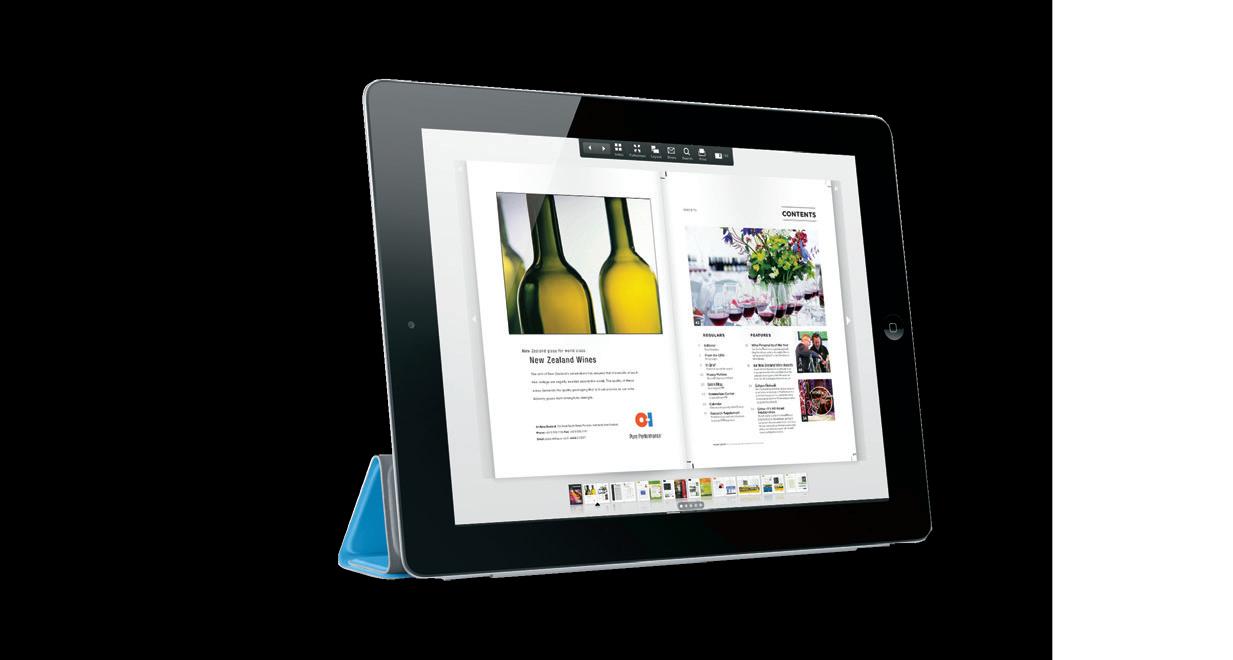
markets.
Now, as momentum for lower emissions packaging grows, New Zealand is boxing some premium wines, with James and Matt Dicey leading the way with Dice by Dicey, a 2-litre box of Central Otago Pinot Noir, retailing at $80.
The brothers behind Dicey Wines noticed that Europe was miles ahead with alternative packaging. Describing a conversation they were having in late 2019
NOW READ IT ONLINE


about how they could do what they were doing “but better”, Matt thought it was obvious they were “missing a piece here”. It took two years to launch Dice, with plenty of challenges along the way, starting with getting a handle on the energy use and recyclability of wine packaging, he says. “You really needed to look … for us it’s been a big journey of discovery”.
They discovered that none of the glass from Central Otago gets recycled. “It
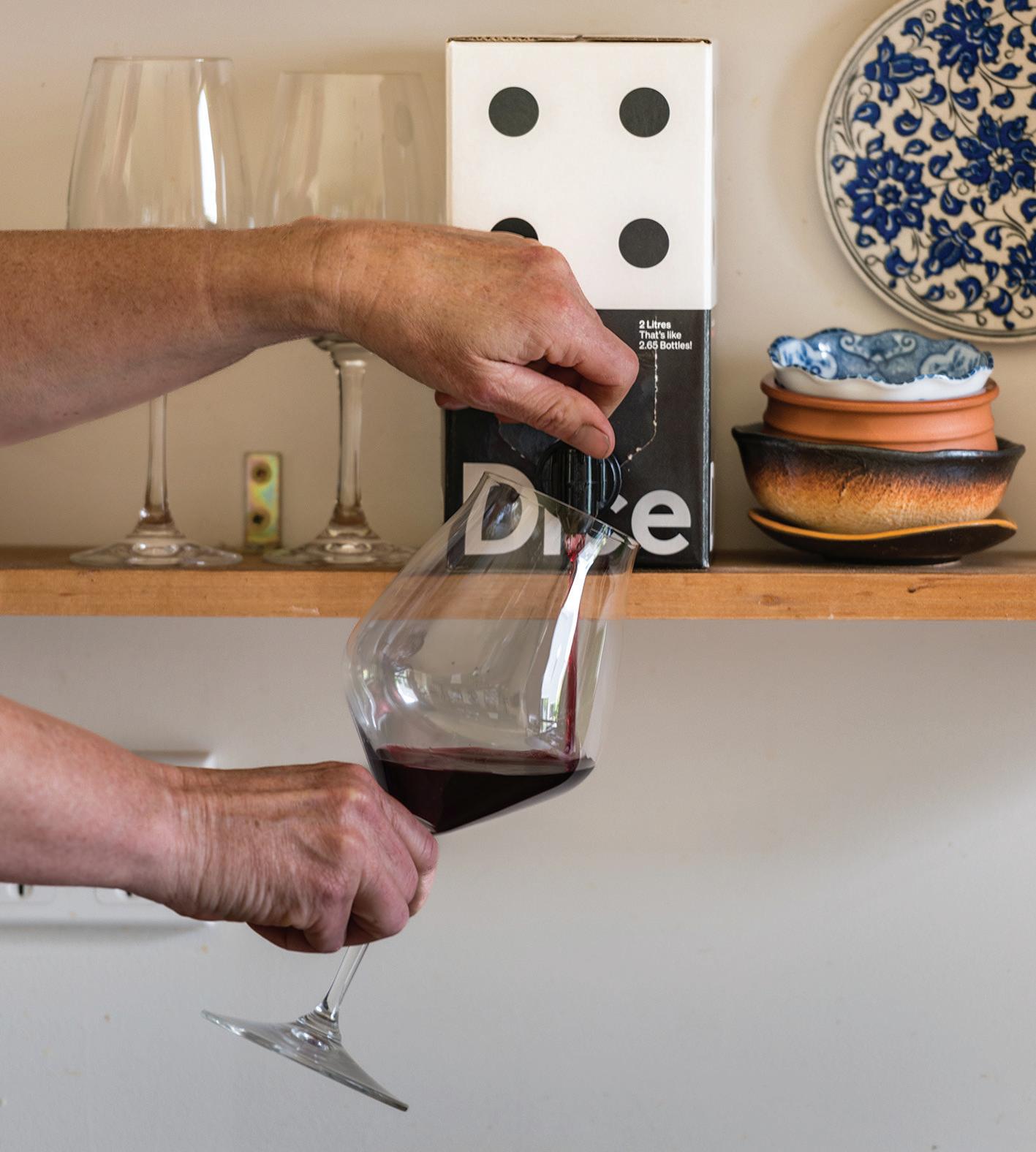
24 I NEW ZEALAND WINEGROWER I AUGUST/SEPTEMBER 2023 THE WHOLE PACKAGE
“As great as glass is, when you look at it, it is too much of our energy within that bottle of wine.”
www.nzwinegrower.co.nz GENERAL NEWS OPINION PEOPLE PROFILES REGIONAL UPDATES AND MUCH MORE
Matt Dicey
Reading the magazine online has never been easier.
is too energy intensive and expensive to truck back to Auckland, so it all gets crushed and re-used in roading – which is a massive waste of energy,” he says. When they dug into their energy use, they found that half of it was down to the production and transport of glass bottles, meaning a change in packaging would be a major and immediate impact on their footprint. “As great as glass is, when you look at it, it is too much of our energy within that bottle of wine. The way to change that was to put a premium product into it (BIB) and being in Central Otago for us that was Pinot.”
“The first thing was to source some fruit which was relatively easy; much harder was how do we actually bag our wines”, Matt says. After looking at commercial packers, they ended up importing their own semiautomatic bagging system and then went about sourcing the inner bags locally. “We found out New Zealand was actually at the forefront of bag film manufacture in the 80’s and 90’s. And there were a couple of really innovative people that led that early film development here in New Zealand”.
Recyclability was an important focus

for Dicey. Although unable to source a fully recyclable inner for their first run, they have now sourced what is known as a ‘recycle ready bag’. This has a monomaterial tap, where the tap and the bag are made of the same plastic, making it fully recyclable as one piece.

The challenges haven’t just been in

the physical packaging. Matt says the consumer is ready for change, but the image in New Zealand of BIB as cheap lowend wine has been purveyed right through the retail sector. “The retail gatekeepers have probably been the hardest people to get through.” When they get out and chat to accounts, they always seem to have the same memories of cask wine as ‘rubbish’
that they snuck into concerts and drank at parties before blowing up the bag as a pillow, he says. “But as soon as they taste the Pinot they get through a lot of those pre-conceived notions. Like everything, it is about the level of engagement with the retailer.” They initially saw sales in on-premise grow quickly as a solution to by-the-glass. “It stays fresh for a month, with no wastage … and when people see it behind a bar, it really generates some conversation.”
Dicey are planning to release a Rosé and a white wine alongside their Pinot Noir but Matt acknowledges they are only a small part of the market. “This is not us trying to create a category. Success for us would be other entrants coming in.” They have seen a lot of interest from other New Zealand wine producers in Central Otago and around the country, and are hopeful others will jump in and start to put quality wine in the boxed format. “We are never going to change it on our own. It is everybody telling that story and getting the messaging coming through. There are all sorts of alternative packaging formats, and I think all of it is breaking down those stereotypes.”

NEW ZEALAND WINEGROWER I AUGUST/SEPTEMBER 2023 I 25 THE WHOLE PACKAGE
first
bag our
The
thing was to source some fruit which was relatively easy; much harder was how do we actually
wines.”
Part Time over 14 Weekends Includes WSET Level 2 & 3 in Wines, Level 2 Spirits & Wine Marketing modules. Student loans available, view our website for details. Rated excellent on Trustpilot www.foodandwine.co.nz Viaduct, Auckland Certificate in Professional Wine Knowledge, Level 5 Quarter Page Portrait - May 2023.indd 1 23/05/23 4:58 PM Enhance your terroir and vintage with a custom blend of natural fertiliser and nutrients, pelletised for impeccable accuracy. To improve your finish, start by calling us on 0508 678 464 or your local rep. by CP Lime Perfectly balance your soil
Matt Dicey
Paper bottlesFrugal
NADINE WORLEY
One of the latest alternative packaging formats to emerge is the ‘paper bottle’, with a carbon footprint that’s four times less than a lightweight glass bottle made in the United Kingdom. The Frugal Bottle starts life as two flat pieces of recycled and chemical-free paperboard which are then formed around a traditional Bordeaux bottle mould with a food grade pouch, which is the same material used in bag-inbox wines.
Malcolm Waugh, Chief Executive of UKbased Frugalpac, says the bottle comes in at just 83 grams, which is five times lighter than a standard 440g glass bottle and four times lighter than a 345g lightweight alternative, “making it easier to carry and lighter to transport”.
Frugal Bottle was released in 2020 and is now available in New Zealand, engendering “an enormous amount of interest”, starting with New Zealand gin start-up Mothers Ruined, which recently launched four new gins in the bottle. “Frugalpac also has enquiries to order seven million Frugal Bottles a year from New Zealand wine producers.” They are working with Punch Bowl Packaging, which is considering an investment in the Frugal Bottle Assembly Machine so the bottles can be made in New Zealand. Malcolm says having locally produced bottles will cut the bottle’s carbon footprint even further and allow wine producers to use local print and paper
Cradle to Grave
An independent life cycle analysis looked at the ‘cradle to grave’ life cycle of all bottles, including mineral extraction, manufacture, transportation, distribution, filling and recycling or incineration. Intertek tested the Frugal Bottle alongside

suppliers. “We will soon be able to provide a full end-to-end service in New Zealand from bottle production to filling, capping and packing.” The food grade pouch is a polyethylene metallised polyester laminate, the same material used in bag-in-box wines. Launching a new format bottle amidst the Covid-19 pandemic did result in some “hesitancy” from traditional wine producers, Malcolm says. But in pre-launch polling 63% of wine drinkers said they would buy wine in a paper bottle, “so we knew the demand was there”. They now
bottles made from glass and PET plastic and found:
• The Frugal Bottle has the lowest carbon footprint with 91.9g CO2e – 84% lower than a 440g imported glass bottle (558.2g CO2e) and 34% lower than a bottle made from 100% recycled plastic
have more than 30 brands around the world using the Frugal Bottle for wines, spirits and olive oils, and at the 2023 ProWein wine fair in Germany, where eight wine and spirit brands were using paper bottles, journalists called it “increasingly ubiquitous”. “It’s clear that the drinks industry has been wanting to make the move to more sustainable and lightweight packaging,” Malcolm says. “We’re getting inundated with enquiries now because we’re offering them to join our paper bottle revolution.”
(138.6 g CO2e)
• The Frugal Bottle’s water footprint is at least four times lower than glass. It takes 2.5 litres of water to make a lightweight 345g glass bottle made in the UK but only 0.6 litres to make a Frugal Bottle
26 I NEW ZEALAND WINEGROWER I AUGUST/SEPTEMBER 2023 THE WHOLE PACKAGE
“It’s clear that the drinks industry has been wanting to make the move to more sustainable and lightweight packaging.”
Malcolm Waugh
Malcolm Waugh, CEO at Frugalpac
HML32 SHEDS ITS SKIN FOR A NEW IMPROVED FORMULATION
INTRODUCING
NEW FORMULATION TO GIVE AN IMPROVED FATTY ACID, POTASSIUM SOAP.
Better handling, mixing and compatibility in the tank.
No pre-mixing required
Increased spreading on leaf surfaces

Easy to handle, pour, and stable.
Consistently good viscosity

Tank mixed with either Nordox or Norshield
Organic certification

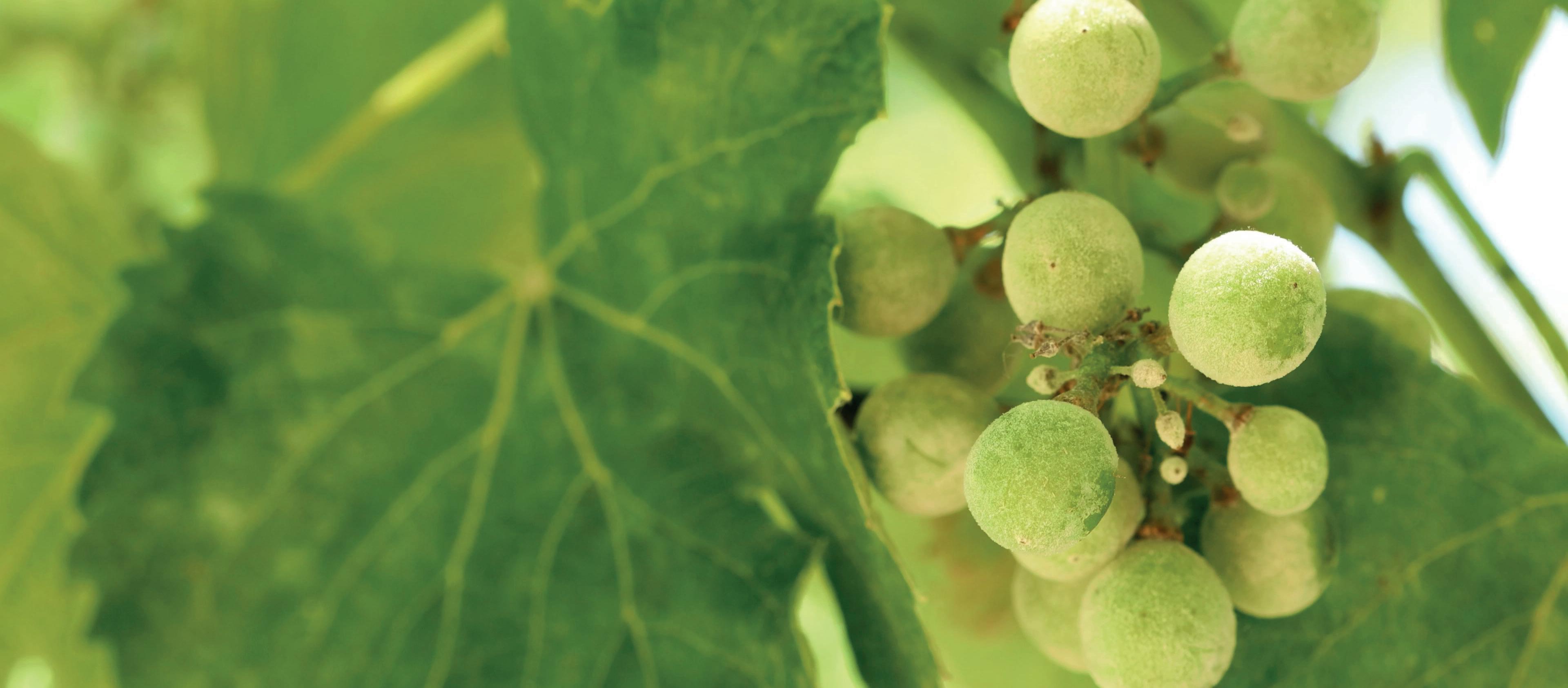
www.grochem.com

Tetra Pak
NADINE WORLEY
We are all familiar with Tetra Pak cartons for our soy milk and orange juice, but Boris Munster, Managing Director for Tetra Pak Oceania, believes cartons are an environmentally friendly and durable alternative packaging option for the wine industry too. Many international wine brands already using Tetra Pak cartons for different styles of wine, from “Cabernet Sauvignon to Riesling and Sauvignon Blanc – and everything in between”, he says. They recently showcased some of these wines Winetopia and were impressed by the response from consumers. “If the engagement we received during Winetopia is anything to go by,
consumers are ready and willing to embrace such a product.”
Boris explains Tetra Paks are essentially a carton made from paperboard, with a thin layer of plastic
the format, but Boris says they have had discussions with local wine producers who have shown interest in the carton. “Decisions could be made on a productby-product basis, and wine in carton can complement traditional wine packaging.”
and a layer of aluminium (eight times thinner than a human hair), which is fitted with a screw cap lid. No New Zealand wineries are currently using
Like many of the alternative packaging formats, environmental impacts are driving interest from the wine industry. Tetra Pak has carried out several life cycle assessment studies and found “a carton has a carbon footprint that is 12 times lower than a glass bottle”. When it comes to transport it is 17 times lighter than a glass bottle, Boris says. “Distributing wine in cartons requires around 50% fewer trucks on the road”. Cartons can be recycled in New Zealand by saveBOARD in Hamilton, who produce low carbon building materials from recycled packaging.

28 I NEW ZEALAND WINEGROWER I AUGUST/SEPTEMBER 2023 THE WHOLE PACKAGE
“If the engagement we received during Winetopia is anything to go by, consumers are ready and willing to embrace such a product.” Boris Munster
Reusing glass –Green Bottle
SOPHIE PREECE
Reusing wine bottles results in a “staggering” 90% less emissions than using single use new glass, made partly with recycled glass, says Green Bottle Project founder Neil Pollett. “We want to see a balance between recycling and reuse; not a total dominance of recycling.”
imported all the machinery it needs, says Neil. “Once in operation our first factory will be able to process up to 20 million bottles per annum from collection in supermarkets and other outlets; then washing, removing the labels and inspecting the bottles for the smallest of defects or foreign bodies.”

However, initial interest from the wine industry has been “somewhat disappointing”, due to a “wait and see approach”, Neil adds, putting that down to a resistance to change.
Green Bottle Project intends to collect, wash and sterilise glass bottles for reuse and resale, working with craft and commercial breweries, niche milk producers, and wine companies.


The company recently received funding from the Energy Efficiency and Conservation Authority and has now


It will be easy for wineries to adopt, with the same bottles and capsules currently used, while adjustments to label base stock will ensure they can be washed off, he says. “Labels can also be composted as part of the process and all aluminium closures can be recycled once cut off the bottles prewashing.”

Dr Edwin Massey, General Manager of Sustainability for New Zealand Winegrowers, says one of the complications of reusing bottles in New Zealand is the quantity of wine exported, with the return of bottles from abroad an untenable option. greenbottle.co.nz
The full version of this story ran in April 2023 Winegrower magazine, available at nzwine.com
NEW ZEALAND WINEGROWER I AUGUST/SEPTEMBER 2023 I 29 THE WHOLE PACKAGE
“We want to see a balance between recycling and reuse; not a total dominance of recycling.”
www.vintechpacific.co.nz 06 863 0024 | 021 783 236 MOBILE SERVICES WINEMAKING PRODUCTS INFRASTRUCTURE HUBS TECHNOLOGY SALES AUCKLAND | GISBORNE | HAWKE’S BAY | MARLBOROUGH | CENTRAL OTAGO
Neil Pollett
The Science

31 I NZSVO Workshop Spotlight on Chardonnay 33 I BRIght Ideas Tuned Vines 34 I Organic Conference From soil to community
NZSVO Workshop
From struck match aromas to “vexing” green characters, and from expert palates to crowded marketplaces, the science, viticulture, crafting, and consumer impressions of New Zealand Chardonnay is under the spotlight.

The New Zealand Society for Viticulture and Oenology (NZSVO) is running a jampacked Technical Workshop on 5 October, as part of the two-day Aotearoa New Zealand Chardonnay Symposium in Hawke’s Bay.
Viticulturist Dr David Jordan, who is on the NZSVO workshop committee, says learnings from the international and New Zealand-based speakers will be enhanced by the high level of expertise in the audience, which is likely to include some of the country’s most experienced Chardonnay viticulturists and winemakers.
“I love the fact that Chardonnay requires both a close understanding of site and patience to allow it to speak of place.”
that demonstrate those notes are poured for the audience. That transition from science to glass is about bringing the research “to life”, David says. “It marries the science with the wine in the bottle and ultimately in the glass.”
in telling our site-specific stories”. The best examples age “beautifully, elevating New Zealand wine’s message to the world”, he adds. “I love the fact that Chardonnay requires both a close understanding of site and patience to allow it to speak of place.”
Emma Jenkins MW will give an overview of the history of the variety in New Zealand, including developments and global perceptions, David says. “Many international commentators have said, ‘your Sauvignon Blanc is great, but don’t lose sight of how wonderful your Chardonnays are’ … Emma will help bring that into focus.”
The science behind the concept of struck match character is next on the agenda, with Dr Tracy Sherbert from the Australian Wine Research Institute speaking about sulphide elements that manifest in some modern-day Chardonnay styles. Rebecca Deed, a wine science lecturer at University of Auckland, will address the same subject with a biological/yeast slant before wines
From scientists to practitioners, the next speaker will be Steve Flamsteed, until recently the Chief Winemaker at Giant Steps, who is “hugely respected” in Australia for his winemaking, as well as his “major influence” on new winemakers coming through the company, David says. Steve will be paired with Craggy Range Winemaker Julian Grounds, who was mentored by Steve early in his career. “They are looking at a topic that vexes us in a production sense. The green ripe/unripe characters that come through in some of the Chardonnays we make in New Zealand,” David says. “We’re trying to get to the bottom of its origins. Is it because of our growing climate, or is it our longtime focus on Mendoza as a clone, which tends to have mixed ripeness in the bunches … or is it a function of our winemaking style in recent times?”
The lineup continues with three pairings from New Zealand wine companies, starting with Church Road winemaker Chris Scott and viticulturist Claire Pinker, who make a range of Chardonnays, from entry level to globally acclaimed. They’re followed by Greystone winemaker Dom Maxwell and viticulturist Mike Saunders, giving a North Canterbury and organic perspective after their 2021 Chardonnay took Wine of the Show at the Aotearoa Organic Wine Awards, as well as three trophies at the International Wine Challenge 2023. Dom says Chardonnay clearly resembles its place and handling, “and therefore is beneficial
Brian Bicknell of Mahi Wine will bring Marlborough insights to the NZSVO workshop, discussing his experience and interest in site specific Chardonnay. “A real key is temperature and with cooler mean temperatures through summer, but a long ripening period, the variety really suits a number of regions in New Zealand.” When it comes to Marlborough, an open canopy and balanced crops results in consistently great wines, “especially on the lower vigour soils in cooler pockets”, he says.
However, the current return for growers makes Sauvignon Blanc more attractive financially, so the region is losing vineyards as older blocks are being replanted to Sauvignon. New Zealand Winegrowers data shows the 3,202 hectares of Chardonnay planted across the country in 2013 (9% of the total hectarage) had dropped to 3.187ha in 2022 (about 5% of the pick). “It is thought that about 20% goes to sparkling base, and in Marlborough the Chardonnay pick accounts for just 2.5% of total intake,” Brian says. He believes more blocks will be planted, “but predominantly smaller, quality-focused parcels owned by wine fanatics”.
After Brian’s presentation, Neudorf’s Todd Stevens and Rosie Finn will speak from a consumer perspective, looking at how New Zealand’s approach to Chardonnay sits in a global market. The team from Martinborough Vineyards – winemaker Paul Mason and viticulturist David Shepherd –Photo left. Elephant Hill
NEW ZEALAND WINEGROWER I AUGUST/SEPTEMBER 2023 I 31 THE SCIENCE
Dom Maxwell at Greystone PREECE
SOPHIE
Chardonnay, from vine to market
Dom Maxwell
then continue the market focus and discuss the evolution of Chardonnay. As with all the speaker segments, this will be followed by wine examples that “illuminate” their presentations, David says.




Wrapping the NZSVO Technical Workshop in the two-day Chardonnay Symposium has been a great opportunity, he adds, welcoming the opportunity to work with Hawke’s Bay Winegrowers to facilitate a comprehensive programme that moves from vines and wines to the science and market. “The synergies are fantastic.”
Chardonnay Symposium

The Aotearoa New Zealand Chardonnay Symposium will be held in Te Matau-aMāui Hawke’s Bay on 5 and 6 October. Following a technical workshop on day one, day two will give an international perspective, including from wine writer Christina Pickard, who will shed light on the American market, and Elizabeth Kelly MW giving a British wine buyer’s view of the competitive retail market. hawkesbaywine.co.nz/symposium
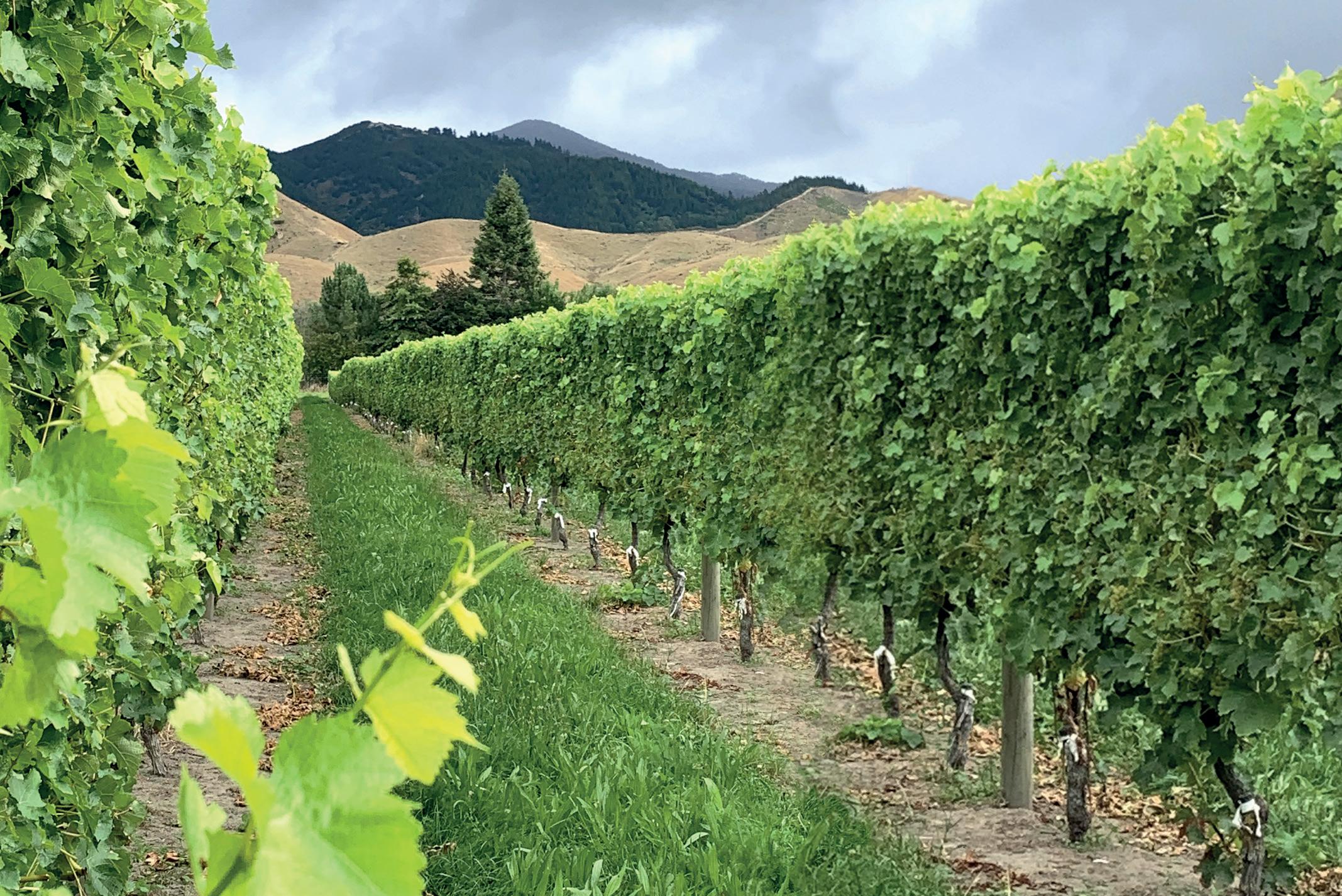

Better Biology Better Wine
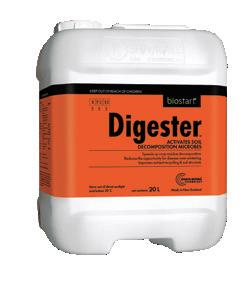
32 I NEW ZEALAND WINEGROWER I AUGUST/SEPTEMBER 2023 THE SCIENCE
Brian Bicknell with his son Max. Photo Jim Tannock
*Asusedin2021AccoladeWinestrial for provenyieldincreaseandbettertastingwine.
matter fast
foliar health and resilience in times of environmental stress Available from leading horticultural suppliers For strong vines, consistent yields and better tasting wines*apply: 0800 116 229 biostart.co.nz
Mycorrcin – to boost soil microbes that increase root growth and nutrient uptake Digester – to stimulate decomposition microbes to recycle organic
Foliacin – to improve
BRIght ideas
The Tuned Vines project
SARAH
ROWLEY ADAMS
Ever wonder exactly how the environment in Central Otago makes Pinot Noir taste different to that grown in Martinborough, even though the vines are the same before they’re planted? And while we’re thinking about it … if all cells in a plant have the same DNA, how do some form leaves, some roots, and others berries?

A big part of the answer is ‘epigenetics’: signals from within the plant and from the environment can change which of the tens of thousands of genes in a cell are turned on at any time.
Tuned Vines is a two-year research project run by the Bragato Research Institute (BRI) Grapevine Improvement team. The project aims to demonstrate ways to manage grapevines, by turning specific genes ‘on

Since its creation in 1960, Tonnellerie Mercier has grown into one of the leading French cooperage companies. Its production facility, located in Barbezierx (Charente-France), between Bordeaux and Cognac.

HACCP certified, Tonnellerie Mercier takes a serious approach to traceability by ensuring the supply of French oak to the cooperate is completely seamless. The log-splitting workshop, located a few kilometres from the facility, provides 100% of the raw material needed for production. Since 1960, TonnellerieMercier has become a master in the art of traditional toasting. Slow toasting to the core, at a controlled temperature, is characteristic of TonnellerieMercier, giving your wines volume on the mid-palate and length of the finish.
or off’, using a technique that would not be considered genetic modification.
Firstly, the Grapevine Improvement team is working on identifying epigenetic markers of environmental stress in grapevines – such as which genes react when the grapevine is in drought conditions or very cold weather. Secondly, they aim to prove the concept of using small RNA molecules to ‘tune’ plant responses – making the vine react in a certain way. This is done by adding the molecule to the vine either as a root dip or by spraying the leaves.
The potential outcomes from this project could help vineyards adapt to the changing

The Dune Toast completes the range of traditional Mercier toasts with a unique method of combining a controlled toasting time and the use of a dedicated brazier with an air circulation system for a gentele and very lightly marked toast. It gives the wine suppleness, complexity and elegance as well as minerality and respect for its terrior
climate. Some of the hypothetical ways that this knowledge could be used include, priming grapevines to increase their hardiness ahead of a drought, or delaying sugar ripening of the grapes if temperatures were sweltering.
In addition to providing knowledge relevant to the later stages of the Sauvignon Blanc 2.0 programme, the aim of this project is to create a credible base of knowledge to be progressed with collaborators outside BRI from mid-2023.
Sarah Rowley Adams is BRI Communications Manager. This story first ran at bri.co.nz/news
After much positive feedback from 2022 and 2023, we are proud to be offering Tonnellerie Mercier on 2024. Contact us now for prices and availability.

info@pros.co.nz
Ph 03-577 9000
NEW ZEALAND WINEGROWER I AUGUST/SEPTEMBER 2023 I 33 THE SCIENCE
Palliser Estate
Pacific Rim Oenology Services • 4 Bristol Street, Riverlands, Blenheim NZ 7274 • W: www.pros.co.nz • Ph 03-577 9000
More than just a lab
CAPACITIES AVAILABLE 225L / 228L / 300L / 500L / 600L
Growing Community
Organic & Biodynamic Winegrowing Conference
The Organic & Biodynamic Winegrowing Conference travelled from moon to mycorrhizae, in an event that married traditional wisdom with cutting edge science.

The conference, held in Blenheim over three days in June, involved 25 speakers, including scientists, winemakers, viticulturists and a Master Sommelier, canvassing everything from the health of soils, microbes and plants to the outcomes for wines, climate and market. The conference also included speakers dedicated to community, indigenous knowledge, and generational connections to place, including Elaine Chukan Brown, who emphasised the responsibility to her Unangan-Inupiaq ancestors in Alaska, and to many future generations to come. Dr Jessica Hutchings from Te Waka Kai Ora, the Māori Organics Authority, discussed food sovereignty, indigenous knowledge, and environmental wellbeing in New Zealand, and invited winegrowers to join the Hua Parakore Māori organics movement.
Organic Winegrowers New Zealand (OWNZ) executive committee member and conference co-chair Bart Arnst says those themes are pertinent to New Zealand’s relatively young wine industry, with an intergenerational perspective asking owners to look beyond their current investment, at what the land needs for future success.
Enhancing the soil and mitigating climate change were key messages of both social and science discussions, including James Dicey presenting on his biochar trials in Central Otago, reinforced by Dr Vinay Pagay from the University of Adelaide, who shared research on the implementation and effects of biochar in organic vineyards. Dr Andrew Smith from the Rodale Institute discussed regenerative organic agriculture and its impact on soil carbon
and sequestration, while Dr Hicham Ferhout from Agronutrition in France looked at rhizobacteria and endomycorrhizae and their role in plant and soil health.
Committee co-chair Nick Pett, Seresin Estate Winemaker, says the ability to connect and share with people at the heart of the industry was a highlight of the event for him, after a four-year conference hiatus due to Covid-19. “It felt like it had been such a long time since we were able to have everyone all together and have that short of energy and collaboration,” he says, delighted to have found the audience open to every speaker, from scientific and technical presentations to more community-focussed discussions. “I think that was my standout moment – the buzz and energy of everyone after each session. Everyone was super enthusiastic.”
Seresin Estate has been certified organic
Horticentre Charitable Trust
for around two decades, but Nick says there are always areas to improve, and he came away excited about changes for the future, including work on the vineyard system around fungi, mycorrhizae, regenerative management, and the integration of sheep. He’ll also be taking a look at the company’s wider impact, and how it can improve its footprint. “You look at what is happening in the world and we have to do something to help.” That includes increasing carbon sequestration in soils, and considering bottle weights and shipping, he says. “Looking at the big picture. That’s an area I am excited to be working on in the next stage of Seresin’s journey.”
Meanwhile the organising committee – packed with “great energy” – is already thinking about continuing the momentum, he says. “We’re ready to lock in the date for the next one.”
The New Zealand Horticentre Charitable Trust awarded $10,000 to Organic Winegrowers New Zealand to bring eight vineyard growers to attend the Organic & Biodynamic Winegrowing Conference. Event organiser Naomi Galvin says cost is a major barrier for some delegates, and especially for smaller growers in distanced regions. “We wanted to see representation from all regions across New Zealand attend the conference, so it was fantastic.” Representatives from Auckland, Hawke’s Bay, Gisborne, Wairarapa, Marlborough, Nelson, North Canterbury, and Central Otago were selected to attend the conference. “The goal was for the recipients to go back to their peers to share what they learnt,” Naomi says. “This technical knowledge transfer opportunity supports our nation’s viticulturists to grow and thrive in an environment that is constantly changing.”
34 I NEW ZEALAND WINEGROWER I AUGUST/SEPTEMBER 2023 THE SCIENCE
Dr Andrew Smith from the Rodale Institute discusses regenerative organic agriculture and the soil carbon solution.
Photo Lisa Duncan
SOPHIE PREECE
Strong. Simple. Smart.
Spread from the back.
2-for-1! With no change-over time. Band & pile from the front.
Science Snippet
Modifying the microclimate
Detailed chemical analysis of Pinot Noir grapes grown in controlled microclimates suggests higher temperatures during ripening can influence metabolites in potentially positive and negative ways.
Dr Romy Moukarzel, of Lincoln University, is part of a research team conducting the first study of how temperature changes during ripening affect individual amino acids and phenolics in Pinot Noir grapes.

Romy says modifying the microclimate when the grapes ripened has allowed them to explore the impacts of higher temperatures on the accumulation of primary and secondary metabolites, providing insights into expected impacts on Pinot Noir from climate changes. Romy says the main goal of the research has been to investigate how such temperature changes in controlled environments impacted Pinot noir grape yield and quality. A complex number of environmental and biological factors determine the concentration of metabolites in grapes and “we are just starting to unravel these interactions in the context of climate change”.
Higher temperatures increased amino acids, “indicating potential changes to the characteristics of Pinot Noir, since amino acid profiles may be closely linked to a wine’s aroma”, Romy says. In some cases, this could be positive as “having high specific amino acids at early stages of fermentation can produce wines with good complexity and mouthfeel”.

On the flip-side, any change in amino acid composition could influence yeast growth and fermentation and ultimately impact wine quality, she adds. Increased temperatures were also shown to have a negative effect on anthocyanins. These influence wine colour and the change “could be detrimental to perceived wine quality in warming climates”.
Romy says that the warmer conditions did not affect the yield of the grapes or cause water loss, as the grapevines were irrigated, meaning water was not a limiting factor. “Future experiments are needed to assess amino acid accumulations at high temperatures in combination with water stress.”


The study has been carried out at Lincoln University as part of a Ministry of Business, Innovation and Employment funded programme led by the Bragato Research Institute. The Lincoln team includes Romy, Dr Amber Parker, Dr Olaf Schelezki and Professor Brian Jordan.
From fertiliser to gypsum, compost & even mulch. Simple, accurate & very very versatile. Rates and row widths are simply keyed in then you are away!
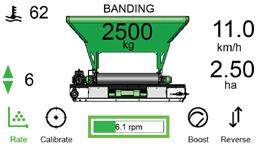



NEW ZEALAND WINEGROWER I AUGUST/SEPTEMBER 2023 I 35 THE SCIENCE
Dr Romy Moukarzel
SAM VINEYARD SPREADER
NZMade Sinceforever.
Proudly
SAM 07 847 8492
buy contact your local dealer www.sammachinery.co.nz
SCAN WITH PHONE CAMERA FOR MORE INFO
CALL
To
GAME CHANGER
The People

38 I The Profile Tony Bish 40 I Winemaker Win Natalie Christensen 42 I Women in Wine Dr Jo Cribb 44 I OIV Chief Dr John Barker 46 I Philip Gregan True Believer
The Balance
Jeremy McKenzie racing into vintage
Creating an excellent Chardonnay has plenty in common with competing in an endurance adventure race, says winemaker Jeremy McKenzie. He should know, because as Vintage 2023 loomed and Isabel Estate’s vines hit veraison, Jeremy set off on the Coast to Coast, tackling 243 kilometres of running, biking and kayaking in the individual Longest Day event. “The bones of anything that needs to be at the pointy end – whether it’s racing or trying to make top class Chardonnay –is the huge amount of planning that goes into it,” Jeremy says in his 20th year of winemaking and 15th year of adventure and multisport racing. Meanwhile, both require a strong team for best results, he adds. “There are plenty of people involved and you can’t do it all yourself.”
Jeremy, whose Isabel Estate Marlborough Chardonnay 2020 won Champion Wine of the Show at the inaugural National Wine Awards of Aotearoa New Zealand last year – where he was named Winemaker of the Show – has found a good balance between his twin passions of winemaking and outdoor adventure. That includes two Ironman Events, a plethora of half Ironman races, three massive multiday Godzone Events, and several Coast to Coasts, including coming 6th in the Longest Day events in 2011 and 2022, and a team event a couple of years ago, which he and two friends won. This year’s race was a chance to do some training with his 16-year-old son Finn, who came 5th in the two-day open men’s event.
Jeremy’s own 2023 race was stymied by a pulled hamstring on the Goat Pass section of a 30.5km mountain run. He slipped back from his 11th placing, but completed the arduous course in just under 14 hours, taking 36th place. Then it was straight back to prepare for vintage, excited by the potential of Chardonnay from Isabel’s relatively old vines, including the 35-yearold Mendoza he knows are “just fantastic for making high end Chardonnay”. The age enhances the expression of site, while also progressing a natural devigoration, he says. “You haven’t got a teenager who’s throwing
out lots and lots of bunches. You have a very settled vine with deep roots into the soil, throwing out consistent quality year in, year out.”
Isabel Estate has been making “amazing” Chardonnay since the 1990s, adds Jeremy. “We’re so lucky here to have such great vine material.” He’s also working with 548 clone Chardonnay, “which is very youthful at the moment, but showing hallmarks of what could come in future years.”
“stellar” vintage.
Jeremy’s winemaking career began at Allan Scott Wines, but it was at Villa Maria that he started thinking seriously about Chardonnay, working with fruit from the company’s Taylors Pass vineyard, along with Wairau blocks. “That sort of set the scene for the love of Chardonnay, and a style which I thought would do well going forward in Marlborough.” Since then he’s worked in Burgundy and the Yarra Valley, “where great Chardonnay is made too”, and has steadily built the “backbone of knowledge” that he calls on today.
Those “building blocks” are key to the wine he makes, as is the careful management of vineyards in a challenging season like 2023, during which inclement weather required vigilance. “You can’t make a silk purse out of a sow’s ear with Chardonnay,” he says, comparing it to the far more robust and aromatic Sauvignon Blanc. “Chardonnay doesn’t have the same resilience – you have to really take care of it.” Rainfall can see bunches of Chardonnay “get pretty ugly” very quickly, and back in the winery good clean fruit is vital to an excellent product, he says. “The lens is on it with Chardonnay.” Much of Isabel Estate’s Chardonnay vineyard is organic or in conversion, which adds to the need for care in the lead up to harvest, particularly with powdery pressure, Jeremy says.
But despite the gloomy spring and summer heralding a tough 2023 vintage, they were blessed with an amazing run of dry weather, “allowing a smooth harvest and ability to pick on point with great flavour and acidity,” he says, calling the resulting wines “fantastic” across the board. When it comes to Chardonnay, the building blocks are there for another
There’s “epic Chardonnay” made throughout New Zealand, including from those who seldom, if ever, enter awards, such as Kumeu River, Neudorf and Dog Point Vineyards. Those companies and other passionate producers have worked with the variety for many years, earning a strong reputation and helping catapult New Zealand Chardonnay into the limelight, he adds, noting a “coming of age” for the variety. “That’s what I am hoping we can do at Isabel Estate too.”
A lot of people think there’s a lot of glamour associated with the wine industry, “and it is a great industry for sure”, says Jeremy. But it is also a lot of work, “and it depends how much you put in to how much you get out as well.”
Queue the comparisons between maker and racer, with vintage hours and pressure akin to a big adventure event. While Jeremy continues to push the quality of the company’s wines, he’s sure to be pushing himself on rugged trails and rampant rivers, including preparing with Finn for the 2024 Coast to Coast. Hard on the heels of that event, and on the cusp of vintage 2024, he’ll likely be back at Godzone, on in Marlborough next year, tackling a gruelling course of more than 600km in a team of four.
The training required is good for his wellbeing but also his winemaking, Jeremy says. “A lot of thinking goes on when you’re sitting on a bike for five hours training for those sorts of things.”
NEW ZEALAND WINEGROWER I AUGUST/SEPTEMBER 2023 I 37
Jeremy McKenzie. Photo Mark Grammer
SOPHIE PREECE
“Chardonnay doesn’t have the same resilience – you have to really take care of it.”
Jeremy McKenzie
The Profile

THOMSON Tony Bish
Tony Bish is about to leave for a busman’s holiday in Portugal, Spain, and the sundrenched Azores when we talk about his rise to Chardonnista, Hawke’s Bay’s tough 2023 vintage, and an accidental career in wine. “There were only about five choices of what to do when I left school and I chose law and immediately regretted it. The story follows that I was in Gisborne on a beach, out of money and needed a job, when a couple of guys suggested I work vintage, to which I replied, ‘what’s vintage?’”
and I thought ‘horrors’ and didn’t want to go there.”
The rest is history. He worked at Corbans in Gisborne in 1981, then Vidal in Hawke’s Bay for three years, and continued making wine in both the North and South Islands while he studied winemaking by correspondence via Charles Sturt University in Australia. “I wanted to keep working in the industry and at that stage I was 24 years old and didn’t really want to be a fulltime student. Six years of correspondence was a long journey but I liked wine by then,” he says. “It was either that or the freezing works
Tony was pretty green when he cofounded Sacred Hill in Hawke’s Bay in 1986, but more than made up for lost time, working vintages in the South Island, and also at Brown Brothers in Australia. In 2014 he established his independent label Tony Bish Wines, with the introduction of Fat & Sassy Chardonnay, dedicated to the variety that was “always top in my heart”. Three years later, he left Sacred Hill and focussed on the eponymous label and its growing stable of Chardonnays. “There are certain things that happen in your life that stay in the back of your mind and then they come out at some time. For me, one of those things was a trip to Domaine Laroche in Chablis, which is a region that’s been making Chardonnay since the 12th century. It blew my mind that they could be so passionate and so fired up about one variety after multi generations. That focus really stood out to me and inspired me. Europe is all about that. Burgundy is all about Pinot Noir and
READ IT
Chardonnay. It’s all about being focussed and not being fruit salad. And Hawke’s Bay is a great place for Chardonnay, so it was a natural fit.”

Tony and his late wife Karryn converted the disused National Tobacco Building, which had been empty for 12 years. The decision to be monovarietal in winemaking also offered the benefit of innovation. “We could easily get into concrete eggs and oak eggs because we were only making Chardonnay and we didn’t have to fund red fermenters. That enabled us to go down some interesting pathways, which has been a great benefit to us in getting recognised.”
The most difficult and most rewarding aspect of starting Tony Bish Wines was leaving a comfortable salary to create his own brand. “Having the courage of your own convictions is scary but it also brings the biggest rewards,” Tony says. “It is the best thing I ever did.”

In a typical year he makes five Chardonnays: Fat & Sassy, Heartwood, Golden Egg, Skeetfield and Zen. And there

38 I NEW ZEALAND WINEGROWER I AUGUST/SEPTEMBER 2023 THE PEOPLE
Tony Bish in the challenging 2023 vintage. Photo Richard Brimer
JOELLE
“Having the courage of your own convictions is scary but it also brings the biggest rewards.”
www.nzwinegrower.co.nz GENERAL NEWS OPINION PEOPLE PROFILES REGIONAL UPDATES AND MUCH MORE... NOW
ONLINE Reading the magazine online has never been easier.
Tony Bish
are plans to add more. “I love the fact that there are so many different stylistic expressions you can make from Chardonnay, from Chablis styles to quite rich full-bodied wines and a lot in between, so that’s the joy of the variety for me. Its complexity in the mouth and its balance add to that. I just love Chardonnay and we have new ideas for how we’re going to produce new Chardonnays going forward.”
When he looks back at the past four decades in the New Zealand wine industry, Tony sees the premiumisation of the industry as its biggest achievement. “We have gone from Müller-Thurgau and Baco 22a, to the world stage with premium varietals; it has been phenomenal and quite the journey.” The dominance of Marlborough Sauvignon Blanc has played a really important part in that “most amazing ascendance”, Tony says. “For a while, I half lived in Marlborough and half in Hawke’s Bay, and although it’s not part of my story now, it is really pivotal for all of us and as an industry.”
One of the keys to the premiumisation was phylloxera in the 1980s and the Government initiative to subsidise a

vine pull, which reset the entire industry. “We got rid of all those shit varieties and hybrids and put in put in Sauvignon Blanc, Chardonnay, and Merlot, and we have never looked back. Although it was very difficult for the industry at the time, it was a blessing in disguise.”
When it comes to the 2023 vintage in Hawke’s Bay, beset by wet weather and the destructive Cyclone Gabrielle, Tony had a gut feeling it was coming. “The 2011 and 2012 growing season was very difficult. I lost all my Chardonnay in 2012 and I had this horrible feeling that we were in that cycle of never-ending easterlies so it was no great surprise to me. But it was very violent when it came.”
While his winery and home were unscathed, the cyclone saw a significantly reduction in his expected harvest, with plans for a 200-tonne vintage cut down
Desert Island Wishlist
to 32 tonnes, a lot of which was mercy picking. “We tried to help growers by getting something, so we handpicked our way through some pretty messy looking blocks and got some great fruit through extreme effort,” Tony says. “But any other year we would have just walked away.” He had plenty of volunteers, which helped cap costs, along with help from two of his four children – Oscar and Genevieve – who work in the business.
The next step is to broaden the Chardonnay range. Tony has identified top quality vineyards which he wants to respect by creating single vineyard Chardonnays, as in Burgundy. “You can only do it when you’ve got the right parcels of fruit, so that’s what we’re going to do.”
Are these sites all in Hawke’s Bay? “At this stage. Talk to me in a few years and that might be different.”
Wine: Agrapart 2013 Blanc de Blanc Champagne
Meal: Five course banquet starting with oysters then pork terrine on fresh ciabatta… Album or Podcast: Pink Floyd: Wish You Were Here Book or Magazine: Captain Corelli’s Mandolin, by Louis de Bernières
DIRECT PITCH
NEW ZEALAND WINEGROWER I AUGUST/SEPTEMBER 2023 I 39 THE PEOPLE
For details and to purchase, visit fermentis.com or get our App Wine_Ad_E2U_direct-pitch_275x208mm_VA.indd 1 22/07/2022 15:22
! Fermentis E2U™ yeasts are so efficient and secure that you can pitch them directly. You save time, gain comfort and act green, consuming less water and energy. If you prefer, you can choose to rehydrate them beforehand: we guarantee the same final results.
World Wine Win


Awatere winemaker wins international accolade

Accepting the coveted White Winemaker of the Year trophy at the International Wine Challenge was undoubtedly exciting for Natalie Christensen. “But what hit me the most was when I went outside and had so many message from the team and friends and family and colleagues from around the world,” she says. “That’s when it sunk in.”
The Chief Winemaker at Yealands Estate in the Awatere Valley was awarded the accolade in London in early July, while her colleagues watched a 5am live feed from their Awatere Valley winery, cooking up a celebratory dawn barbeque with head torches. That was “super touching” says Natalie. “The support back home blew me away.”
Natalie says the win – the first for a New Zealander since Matt Thomson took the trophy in 2008, and 24 years after Jeff Clarke was awarded the title – was humbling. “The IWC is hugely competitive, and I was up against some incredible winemakers from wineries that are hundreds of years old. Yealands is so young in comparison.”
IWC Co-Chair Oz Clarke – one of the world’s leading wine experts – says the prestigious award recognised Natalie’s

“excellent winemaking” as she expands Yealands’ range. “She has an incredible technical ability and is totally in tune with how to produce wines that give an intense sense of place.” It was wonderful to see the White Winemaker of the Year award go to a woman, Oz adds. “This noteworthy accomplishment not only celebrates Natalie’s exceptional talent and expertise but also lays the foundation for increased recognition and expanded opportunities for female winemakers around the world.”
As well as the individual winemaker trophy, Yealands won the New Zealand Sauvignon Blanc Trophy for the Yealands Estate Single Block S1 Sauvignon Blanc 2022, along with 12 medals, with one for every wine entered. That shows “the breadth of our

winemaking ability outside of our flagship Sauvignon”, Natalie says. “Marlborough is well known for its Sauvignon Blanc, but to have a range of varietals performing so well in shows is really meaningful.”
The 2023 vintage was Natalie’s 10th at Yealands Estate, having joined the company after 18 months working Rias Baixas in Galicia, northeast Spain. And she’s relished the experience of working for one of Marlborough’s biggest companies, with its Seaview Vineyard stretching along the Pacific coastline. “I have worked at smaller places and you are quite confined by what you have got and what you are given and have to make,” she says, comparing that experience to handling an “eclectic” mix at Yealands. “You can really play around with blending and make exactly what you want. So I think there’s freedom and creativity and complexity.”
In the 2023 vintage she worked with 13 different varieties in a range of levels, splendidly spoilt for choice. Sauvignon Blanc is a huge part of the Yealands offering, but her “favourite baby” is Albariño, which she grew to love while living in Spain, where she worked with fruit grown in coastal

40 I NEW ZEALAND WINEGROWER I AUGUST/SEPTEMBER 2023 THE PEOPLE
Natalie Christensen
SOPHIE PREECE
“I want to put my energy and time into working with New Zealand wine and supporting the industry.”
Sales: Jeremy Watts 021 446 225 | jeremy@agrivit.co.nz Service: Les Boyte 027 572 8787 | les@agrivit.co.nz Parts: Warrick Meiklejohn 03 572 8787 |warrick@agrivit.co.nz 29 High Street, Renwick 7204, Marlborough | 03 572 8787 | info@agrivit.co.nz | www.agrivit.co.nz Bio Dynamic product line designed for fast under vine management • Working speed up to 12 km/h • Single and double sided
Natalie Christensen
areas, comparable to Yealands’ Seaview Vineyard. “The hallmark we get out here is a subtle saltiness through the palate which is definitely a classic characteristic of Albariño from Rias Baixas,” Natalie says. “There are lots of things about Albariño I think are super awesome,” she adds, talking of the naturally high acidity of the fruit, along with thick skins and relative disease resistance. “I feel as though, now we are getting the tail end of tropical cyclones, potentially it is a variety that could ride the wave of a bit of climate action.” Sauvignon Blanc remains a safe bet in the short term, with its sustained international popularity. “But I think Albariño is something that could potentially grow and something that could add and support the Sauvignon wave from Marlborough.”
Natalie joined the wine industry 17 years ago, bringing with her experience as a classically trained double bass player, a graduate degree in music, and a master’s degree in psychology. When she jettisoned a job in human resources and took up a stopgap vintage at Saint Clair Family Estate in Marlborough, she was hooked. Natalie went on to study wine at the Eastern Institute of Technology in Hawke’s
Bay, before taking huge strides in the wine world, including being named most influential women in wine in the world by the Drinks Business Magazine (UK) in 2018.


Natalie’s love of the industry is far from limited to her work at Yealands, as a longtime mentor for New Zealand Women in Wine, a member of the New Zealand Society for Viticulture and Oenology, and part of the team behind the Pinot Boot Camp held at Saint Arnaud each year, which transformed into a Chardonnay
Boot Camp in 2022. They will repeat that focus this year, “because there’s so much to explore with Chardonnay”, she says. “That’s one of my favourite groups to be on. That’s fun.”
Any opportunity she gets to work with people in the industry, “I am all about it”, she adds. That’s one of the reasons she came back from Spain. “It was cool being over there. It’s amazing, but … I want to put my energy and time into working with New Zealand wine and supporting the industry.”
Amp-up your spray application

Du-Wett® delivers superior spreading using less water. That saves time, labour, and fuel. And because Du-Wett optimises efficacy, you get the most out of every cent you spend on your spray programme.

NEW ZEALAND WINEGROWER I AUGUST/SEPTEMBER 2023 I 41 THE PEOPLE
coverage, efficiencies and savings
Maximise
Talk to your local merchant to find out more. Approved pursuant to the HSNO Act 1996, Approval Code HSR002503 Exempt from ACVM. Du-Wett is a registered trademark. UPL-LTD.COM
Women in Wine
A passion for wine and governance
In 2022 Dr Jo Cribb celebrated a significant birthday with the Sauvignon Blanc her husband Mike made in the bathroom, using grapes from their Martinborough vineyard. “The lesson was that we are going to leave winemaking to those who know what they are doing and have the equipment,” she says with a laugh, recalling the moment they realised spilt must was fermenting in the floorboards. “We will always pay homage to the expertise of a winemaker.”
Her own expertise is in governance, strategy and diversity, and Jo was recently appointed as an independent director on the board of New Zealand Winegrowers, bringing a wealth of experience to the table. Jo relishes the strategic aspect of governance, with the intellectual challenge of taking an organisation’s knowledge, “and charting a way forward”. She’s also practical, with a “desire for impact”, noting that the most amazing vision for the future of an industry is worthless if it cannot be operationalised to “meet the needs of today and tomorrow”.
That future-focussed mindset drove her previous career in strategic policy, research, and leadership roles, including as Chief Executive of the Ministry for Women, Deputy Children’s Commissioner, and leader of the Commissioner’s Expert Advisory Group on Solutions to Child Poverty. Jo’s Doctorate in Public Policy investigated the contracting relationship between governments and NGOs, and she now works to increase the impact and profile of the NGO sector. She has authored books, won awards – including the 2021 Women in Governance Community Award – and works with companies and organisations
to increase diversity and inclusion and develop better boards. “The only way a board is really going to be effective is if it draws on many perspectives,” she says. “I guess I have seen good and bad over many years so that diversity piece is incredibly important to me. I think it’s essential for a high performing board.” In 2021 she co-founded MindTheGap, challenging pay disparity in New Zealand, and her columns in Newsroom skewer ethnic and gender bias, and offer insight into where power lies and how change can be wrought.
Meanwhile, Jo has a side hustle in wine, with her Instagram page Winesauvy dedicated to showcasing 300 bargains under $30, while banishing wine snobbery. Her new weekend wine column in Stuff kicked off on the same topic, because there are plenty of people intimidated by wine and how others will perceive their choices. “Wine is there to be enjoyed and whatever you like is the perfect choice for you. I am passionate about that. There are so many great choices at all different price points.”
Jo’s wine appreciation began after her father invested a small amount in the vineyard aspirations of a friend, so that the family had bottles of St Helena Estate wine on the table in their Christchurch home. That was the 1980s, when mainstream

culture in Canterbury was “very much flagons of beer”, says Jo.
In their 20s, she and Mike did blind tastings and wine appreciation at the local polytechnic, and built a cellar of wine –which they efficiently consumed before setting off for travels. Wine has been a “delicious” part of her life, Jo says, calling her current work towards her WSET diploma, “intense and hard, but you have to put your money where your mouth is”. Meanwhile, their two harvests as vineyard owners, awake to agricultural risks, have taught Jo and Mike a great deal more about the wine they drink. “Now we are amazed that any grapes get into the bottle.”
They live in Wellington, but plan to move to their vineyard when their last child has flown the coop, “to be grounded by our grapes”, Jo says, happy to be bringing her governance skills to an industry she cares deeply about. “They are woven together and hopefully I can be of some value.”
And while they’re not likely to pick fruit from the edge of the vineyard for another bathroom vintage, a still bought in the first Covid-19 lockdown does keep them in good gin supply. The base alcohol is made of sugar and tomato paste, which you can always get your hands on, Jo explains. “It’s one of those enduring good hobbies
42 I NEW ZEALAND WINEGROWER I AUGUST/SEPTEMBER 2023 THE PEOPLE
Dr Jo Cribb
SOPHIE PREECE
“The only way a board is really going to be effective is if it draws on many perspectives.”
Jo Cribb.



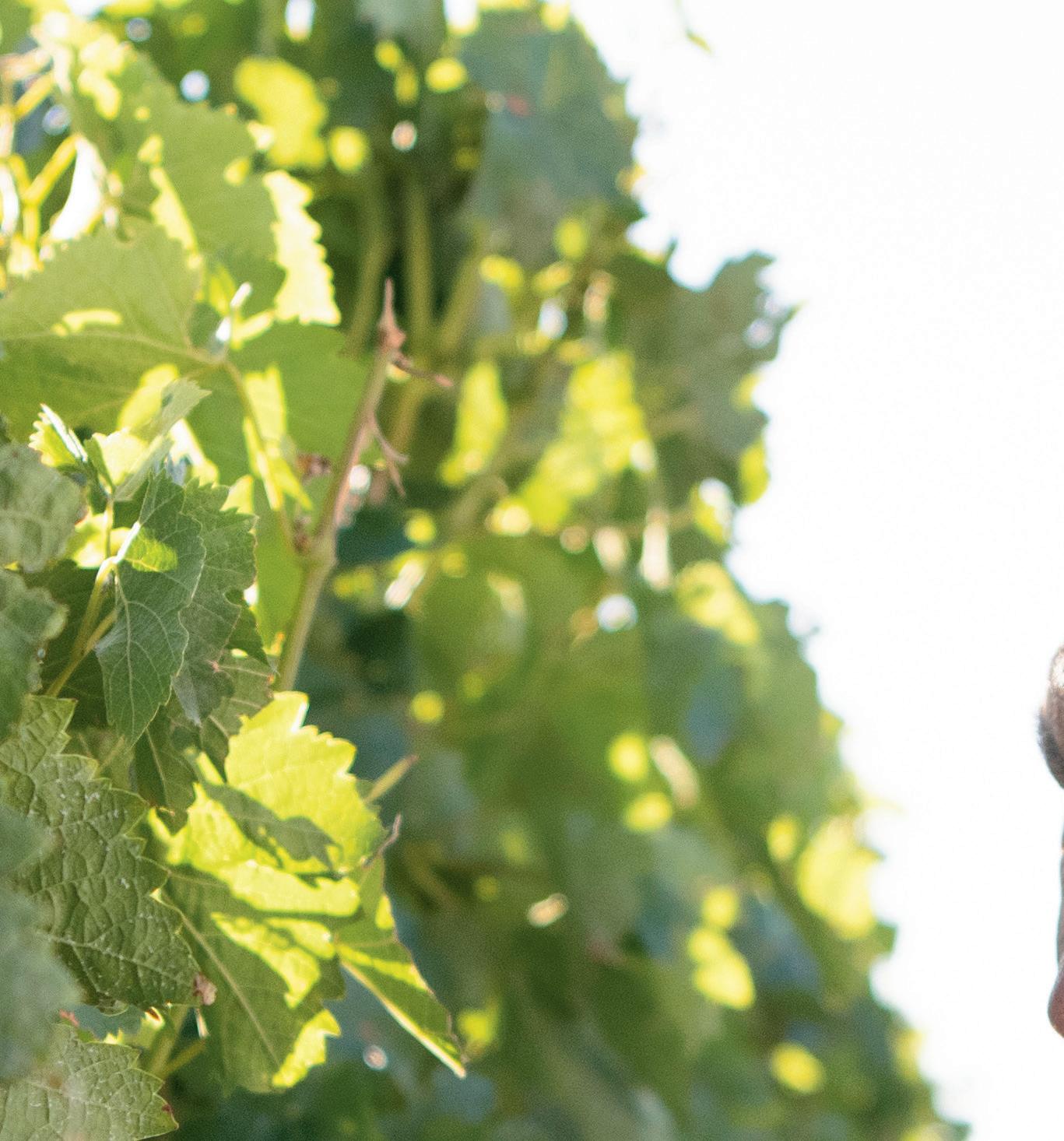
Talk to your local reseller or visit crop-solutions.basf.co.nz Vineyard solutions for your best season yet ALWAYS READ AND FOLLOW LABEL DIRECTIONS © Copyright BASF 2023 ® Registered trademark of BASF. 213842 0523
Dr John Barker
The newly elected Director General of the Organisation of Vine and Wine takes up his role on 1 January 2024, 100 years after the organisation began. We ask Dr John Barker about a career that has married his love of law and of wine, and about the significance of having a New Zealander at the helm of the OIV.
What was your first memorable wine experience?
My father was a wine lover and often took the kids along with him when he visited the vineyards in Henderson and Kumeu to buy wine. So I have memories of the likes of Collards and Lincoln Vineyards on Lincoln Road from long before I was of an age to drink wine. But I think the first real “wow” wine I tried was a vintage Veuve Clicquot champagne that my parents had been given. I can’t remember the taste but it was one of those wines that instantly makes you break into a smile.
Did working in a wine shop while studying for law influence your career?
Yes certainly. I got my first job in a wine shop at the same time as I started university. That was in 1987, which was a very exciting and dynamic time for the New Zealand wine industry and it really caught my interest. So law and wine were always side by side and I feel very lucky that I was able to build a career that combined the two interests.
What led you to choose your research topic for your PhD‘Different Worlds: Law and the Changing Geographies of Wine in France and New Zealand’?
I had been working as a wine lawyer in Melbourne when I got a call out of the blue asking if I would be interested in joining a research project on the wine sector that was being put together by geography Professor Warren Moran at the University of Auckland. They were looking for someone to do a PhD in wine regulation as a part of the project. Although it meant putting my
legal career on hold, I made the decision to come back to New Zealand to take up the offer because the interface of law and the wine industry was a subject that had a deep interest for me. I was really fascinated to understand the way that law shapes the industry and how and why it differs in different places.
Being part of a bigger research project based in the social sciences and in practical field work taught me a great deal. We spent months driving around the country interviewing pioneering growers and winemakers. Then I went to France to do research in Burgundy and to interview industry and regulators there. These experiences allowed me to look beyond the narrow problem-focused perspective of a lawyer to understand the wider complexities of the industry. It was also during my research that I visited the OIV for the first time - so clearly that was an influence!
How have you advocated for the wine sector?
I have been lucky to be involved with New Zealand wine at a time when the industry has emerged from a small and internally focused producer to becoming the world’s sixth largest wine exporter by value. Having the right legal framework in place has been a part of that. While at New Zealand Winegrowers (as General Counsel and General Manager Advocacy from 2004 to 2014) I led the implementation of the Wine Act 2003 and the Geographical Indications (Wine and Spirits) Registration Act 2006, which are the two most important pieces of legislation for our sector.
For me it was just as important to make sure that the law was accessible and understandable to wineries. When the Wine Act was coming into force, I advocated for an industry-led Wine Standards Management Plan Code of Practice. At the time, this was the first industry-led code of this nature, but it is now standard practice across the food sector. The International Winemaking Practices Guide and Labelling Guide were also my babies – although they have come a long way from the few pages of the original versions.
In the OIV, the task has always been to facilitate innovation and trade while protecting the integrity of wine. This can sometimes be a delicate balance. For example in 2012, together with Professor Monika Christmann of Germany, I presided over the oftendifficult discussions that allowed for dealcoholised and partially de-alcoholised wine to be recognised in the OIV. These categories are now finally being introduced into EU law based on the OIV recommendations.
What does your election as Director General symbolise for New Zealand?
It is a very clear acknowledgement of the respect and credibility that the New Zealand wine sector has built up over the years. I was elected with more than 97% of the eligible vote and I will be the first person from outside of the three biggest wine countries – France, Italy and Spain – to hold this position in 100 years of the OIV’s existence. That sort of worldwide

44 I NEW ZEALAND WINEGROWER I AUGUST/SEPTEMBER 2023 THE PEOPLE
Dr John Barker
support would not be possible if the OIV member countries did not recognise New Zealand as a serious player with an important stake in the global wine sector.
And what does it mean for the global organisation, based in the heart of old world wine?
The election sends a strong message that the OIV is a global organisation serving a global sector. For me, the characterisation of old world and new world is not very helpful. Fundamentally I believe that wine countries have far more in common than they have differences – especially today when we all face global challenges like climate change.
Having said that, coming from a comparatively young and small Southern hemisphere wine country I am sure that I will bring a new perspective to the OIV. The New Zealand wine industry has always aimed high and it has chosen to take a leadership role on issues like sustainability. The New Zealand wine industry has been successful in no small part because it has been able to recognise where its common interests lie and to coordinate around those interests. Ambition, integrity, cooperation, kaitiakitanga – these are all New Zealand values that I will take with me into the role.
What are the key roles of the OIV?

The OIV is sometimes called the ‘UN of wine’. It brings together governments and experts from most of the major producers and consumers of wine (and other products of the vine) to analyse and make recommendations on all scientific and technical aspects of the sector.
The OIV makes recommendations
about viticulture, winemaking practices, labelling and definitions, health and safety that are taken up in the laws and regulations of many countries. It also works together with other international organisations that make rules and recommendations affecting wine. So it is extremely important for the global production and trading environment for wine.

society. The sector is also grappling with the implications of artificial intelligence and the digital economy. These are all areas where the OIV can make a difference by providing evidence-based recommendations and guidance to its members and the sector. One of the key elements of my election platform was for the OIV to take a stronger leadership position on these topics.
How much support did you receive from within and beyond the wine sector in the lead up to your election?
The OIV also publishes information, guidance and statistics that are vital for our understanding of the vine and wine sector. For example, every year the OIV gathers and publishes the authoritative data on how much wine is produced, traded and consumed around the world.
And what do you see as the most pressing challenges for wine producers around the world? Over the course of my campaign I have visited many of the OIV member countries and spoken to both government and industry about the challenges that they are facing. Consistently the greatest areas of concern for the sector in the longterm are climate change and sustainability, and questions around wine, health and
Running a campaign to head an international intergovernmental organisation is a massive job. I was very lucky to have an incredible campaign team behind me. New Zealand Winegrowers provided financial and strategic support, for which I am extremely grateful. Since the OIV is a government organisation, it is necessary to persuade the governments of the member countries to vote. The New Zealand Government – particularly through the Ministry of Foreign Affairs and Trade and the Ministry of Primary Industries – has done a huge amount of heavy lifting there and I have the greatest admiration and appreciation for their extraordinary work.
When will you move to Dijon?
The role will start on 1 January 2024. This is an important time because 2024 is the centenary of the OIV and it will be a busy year of celebrations. Among other things, it will be the International Year of Vine and Wine, the new headquarters at the renovated Hôtel Bouchu d’Estorno will be inaugurated, and an International Congress and a Ministerial Conference will be held.
NEW ZEALAND WINEGROWER I AUGUST/SEPTEMBER 2023 I 45 THE PEOPLE
“Consistently the greatest areas of concern for the sector in the longterm are climate change and sustainability, and questions around wine, health and society.”
vine
Superzyme and Rootella will ensure health and longevity. YOURAVAILABLEAT LOCALAG-RETAIL STORE • Increase survival rate of new plantings and longevity of existing plants • Mitigate water, drought and pathogen stress Improve plant health and production Increase growth - earlier wire down • Increase nutrient uptake for fertiliser savings • Improving soil structure through humic compounds produced • BONUS - improved carbon storage in soil for decreased CO2 WWW.RD2.CO.NZ / INFO@RD2.CO.NZ / 09 372 9155 SCAN TO DOWNLOAD PLANTING PROTOCOL SHEET
Dr John Barker
Increase
survival with Mycorrhizal fungi.
Superzyme and Rootella are our high potency biologicals that work together providing protection for new and mature vines.
True Believer
In July 1983 New Zealand’s wine industry could be characterised by “Müller Thurgau and more Müller Thurgau”, and an oversupply plaguing the domestic market. But it was also full of potential, says New Zealand Winegrowers (NZW) Chief Executive Philip Gregan, 40 years after he became Research Officer at the Wine Institute of New Zealand. “There were a whole lot of challenges, but you could see there were fantastic people … who fundamentally believed that New Zealand wine could be something really significant to New Zealand. And they worked very hard to make that happen.”
He’d grown up in West Auckland, where his father would visit local wineries, including Collard’s, Windy Hill, Corban’s, and Babich. “Lincoln Road was a place of wineries. Now it’s a place of fast-food joints.” Philip went on to gain a master’s degree in geography at University of Auckland, where he was working on a research project when a job advert intrigued him, and he joined Terry Dunleavy (“a one-man tour de force”) at the Wine Institute.
Back then New Zealand had 92 wineries and 6,000 planted hectares – 25% of which were lost to the government-funded vine pull in 1986. Fast forward 40 years and New Zealand has 41,860ha of producing vineyard, $2.4 billion in exports for the year ending May 2023, and “increasingly strong global demand for our wines”.
Those stellar statistics are down to a simple combination, Philip says. “New Zealand is a remarkable place for growing grapes and making wine. Then there are some truly remarkable people. You join the two things and ‘voila’ some pretty exciting things can happen. That’s why I do it.
His work included analysing the aspirations and plans of individual producers and building a picture of the industry and where it could go. And by the 1990s – with Philip now Chief Executive – it was “beyond doubt” that the future of the industry was “to be a significant force in the international wine business”, he says. “A whole lot of fundamentals were put in place and learned during that time; it was to some extent trying to work out how big the potential was.” One survey indicated a fivefold lift in export value – from $20million to $100m – between 1992 and 2000 “and it actually occurred”.
NZW was formed in 2002, merging the Wine Institute and New Zealand Grape Growers Council. Philip recalls Montana’s head Peter Hubscher saying, “if we cannot get together when times are good in the industry, it will be too late when times are bad”. The tough times certainly came later that decade, care of the global financial crisis and a wine glut, and validated the change, with growers and wineries “all in this together”, Philip says.
It also stood the industry in good stead through Covid-19, when NZW went in to bat for members, working tirelessly with government to ensure the 2020 harvest could go ahead as an essential service in a national lockdown. The pandemic challenges were myriad, including a labour force stifled by border closures, and the role of NZW in working with government agencies was vital. They also worked hard to ensure industry members kept well in line with Covid restrictions, to protect the industry at large.
“It was a reminder of the role we play in the industry and that we need to perform really,
really well,” Philip says. “If you don’t do it well there can be some profoundly poor implications.”
Steve Green, who was Deputy Chair then Chair of the NZW board from 2007 to 2017, says Philip was key to the success of a strategic review of the organisation in 2011, which changed its board, structure, and operations. “He was also very instrumental in the development of Geographical Indications in New Zealand, which was a huge change … it gave us a structure the regional organisations could build on and develop.” Both of those “fundamental” moments in the industry’s development required a change in legislation, and Philip was key in lobbying Government to achieve that, Steve says, noting the Chief Executive’s ability to build relationships with ministers and their teams, to the advantage of the wine industry. “We are talking everywhere from Customs to Trade to Primary Industries to Justice.”

Philip spends much of his time singing the praises of others in the industry but when pressed says he hopes he’s brought belief and commitment to his role, while working to understand the aspirations of the industry. “And listen to people and try to relate to them about their individual hopes and dreams and problems.”
While history is key, where we are going to is more important, Philip says. “We must always have our eye on what the next 10, 20, 30 years bring. And I fundamentally believe that’s a really exciting future for New Zealand wine. You have to believe in your heart and your mind that we can do something special. And I believe.”
46 I NEW ZEALAND WINEGROWER I AUGUST/SEPTEMBER 2023 THE PEOPLE
Philip Gregan
SOPHIE PREECE
Philip Gregan’s 40 years of wine
“That’s why I do it. Because I believe.”
Philip Gregan
Our research and development team work closely with nature to create versatile, bio-based and biodegradable products using waste by-products that allow them to be absorbed and metabolised by living organisms. From vine clips and ties to plant protectors and pots, PolyNatural® products are ideal options for the horticulture and viticulture industries. We’re leading the way for a more sustainable future—will you join us?
hello@polynatural.nz
polynatural.nz
At PolyNatural® we believe nature is a taonga (treasure) that needs to be protected for future generations to come.
Accidental Pioneer
50 years in Marlborough wine

Allan Scott took a punt on a new job in August 1973, joining 90 bewildered workers in the dry and dusty Brancott Valley. A few months later few of the team remained, toiling to plant Montana’s first Marlborough vineyard, with little idea of what they were doing or why. “Having to carve out a whole new life I didn’t know about was probably one of the best decisions I made,” says the recipient of the 2022 Wine Marlborough Lifetime Achievement Award 50 years on.
then. Not bad for a boy who’d attended one school in a rural town near Hawarden in North Canterbury, then learned a whole lot more working alongside his stockman father and in shearing sheds, gleaning insights into people and their interactions.
In that time, Allan’s life story has run in parallel to the extraordinary development of Marlborough wine, punctuated by the hurdles and highlights of a transformative industry. It’s a story of good luck, good instincts, strategic risks and a lot of hard work, starting with knocking down fences and digging posts on Montana’s first 400-hectare development, amidst “a great deal of uncertainty”.
Allan’s stubborn work ethic and enquiring mind stood him in good stead, and Jim Hamilton, sent by Montana to manage the development, became something of a mentor. “I thrived off his experience and knowledge and developed a much keener interest for the future,” Allan says. By the time the Fairhall block was being developed later that year, Allan was supervisor, on a wildly different path to the stock work, shearing and truck driving he’d done until
When Allan and his wife Cathy left the tiny town to move to Blenheim in 1972, aged in their mid-20s, “everyone said ‘you’ll be back. You won’t go far’,” he recalls. When we speak he has just returned from an international sales trip with his son Josh, visiting some of the 29 markets Allan Scott Family Winemakers is now sold in. So it turns out he went very far indeed. That’s thanks to auspicious timing, an appetite for opportunity, “and taking the chances that are a hallmark of my life”, he says. “You take a punt and think, ‘oh that’ll work’.” Meanwhile, there’s been a hell of a lot of work, says Josh, who bought the family company with his sister Sara Stocker two years ago, with the duo having managed the business for the past four years. “Both mum and dad worked so bloody hard all their life. Not only for us, but also helping Marlborough establish itself as one of the most well-known regions for wine in the world.”
Despite his stockman career path, viticulture work “suddenly gelled” for Allan, who’d spent his childhood planting the gully behind his family home, delighted with the ability to grow trees. By 1975, he and Cathy were planting their own Müller-Thurgau vineyard on Old Renwick Road, among the first 10 Montana winegrowers and industry pioneers, three of whom worked for the company.
In 1985, the Scotts planted Sauvignon Blanc on Jacksons Road, growing fruit, raising a young family, and working day jobs
to pay the bills. By then Allan was working at Corbans, where another stroke of good timing saw him visiting Auckland when the company’s winemaker was looking to avoid a meeting with an Australian wanting some grapes. Allan agreed to take the meeting with David Hohnen instead, and went on to organise the purchase of Marlborough land that would soon become Cloudy Bay. “That was a wee bit life-changing,” says Allan, who negotiated for a slice of the property, across the road from the Scott’s own vineyard, where he and Cathy would build their beautiful home.
In 1990 they forged their label, with Allan somewhat reluctantly agreeing to use his own name. Three decades on, he says Cathy was right to push for the eponymous label, but is still embarrassed when he is asked for his name when ordering a coffee. If the meeting with David in 1984 was a memorable “coincidence”, then the chance encounter with their first UK importer a decade later was another, says Allan. In the early 1990s a Lay & Wheeler rep was staying at The Shack at Cloudy Bay, and paused at the Allan Scott wine shop while out on a run. The Scott’s eldest daughter Victoria, in her late teens at the time, came running out to the vineyard to say, “there’s a man here who wants to take our wine to the UK”, recalls Allan, who’s remained friends with the dropin runner ever since. “Relationships are the key thing,” he adds, noting that the recent trip with Josh was in part, “passing on the baton” for some of the fast friendships forged over the years.
Allan says his kids grew up with the business and have it in their blood, comparing that to his own experiences with his dad on their farm, mesmerised
48 I NEW ZEALAND WINEGROWER I AUGUST/SEPTEMBER 2023 THE PEOPLE
Allan Scott. Photo Jim Tannock
SOPHIE PREECE
“Both mum and dad worked so bloody hard all their life. Not only for us, but also helping Marlborough establish itself as one of the most well-known regions for wine in the world.”
Josh Scott
by his work. ”You learned things and it became a natural instinct. You could pick a good sheep or pick a good cow or pig or whatever. And Josh and Sara have that same natural inherited instinct.”
“It’s been a 40-year apprenticeship for Sara and me,” says Josh, who took his first sales trip with his dad when he was 16, “learning about the sales and relationship side”. Part of that equation is never burning bridges, says Allan. “You just never known when it will come back and haunt you… There might be something you really need and you can’t go back because you’ve burnt a bridge – and it’s hard to eat humble pie.” He sees the Lifetime Achievement Award as recognition of the people who have worked alongside him, including workmates, mentors, advisors and family, and “especially Cathy, Victoria, Josh and Sara, who have been unfailing support through thick and thin”. Looking back at that “punt” in 1973 and the subsequent stellar success story of both Allan Scott and Marlborough wine, it’s hard to imagine his alternative path as a farmer, which he says would likely have been on a high-country station. “That would have been a disaster”.
This story first ran in Winepress Magazine.



Fifty Years, Fifty Stories
Wine journalist Tessa Nicholson has spent more than 25 years writing about Marlborough’s wine industry, crafting countless stories about the people, places, innovations and challenges that have made the region famous. Now, to mark 50 years since Montana planted the first commercial vines in Marlborough, she has written a book to share the travails and triumphs of the industry. Fifty Years, Fifty Stories; Marlborough the region that turned the wine world upside down, covers everything from those first plantings to the impacts of Covid nearly half a century later, including profiles of some of the region’s pluckiest pioneers. Tessa says the past 50 years of stellar success has been driven by those pioneers, including audacious entrepreneurs, resilient growers and curious scientists, all part of a collegial community happy to share its knowledge and innovations. It’s also been driven by the pure good fortune of having a geography, geology and climate that grows incredible wines, including attention grabbing Sauvignon Blanc that propelled Marlborough onto the global wine stage.
It all starts with healthy soil.

100% natural, BioGro certified Supplies readily available source of calcium and sulphate sulphur to support soil health and plant growth.
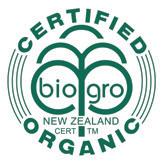



For more information scan the QR code or go to gypsum.co.nz






NEW ZEALAND WINEGROWER I AUGUST/SEPTEMBER 2023 I 49 THE PEOPLE
Frank Yukich placing a silver coin in the hole as the traditional token of good fortune for the new vine.
Available at:
Marlborough Heritage Trust - Marlborough Archives
Bob’s blog

MR GRUMPY
Feedback
A big, warm, heartfelt thanks to everyone who responds to an article I have written. I react well to praise of course but even the harshest criticism is welcome; once I have cleared up the broken glass and apologised for my language to anyone within earshot, I take on board constructive criticism and try to do better. I wrote a magazine wine column for several years without getting any
response from a single reader. I started to imagine that no one read my column apart from my greatest critic (my wife, Marion). It was like shouting into a vacuum. When it got too much for me and I gave up the column, 35 readers wrote to me to say how much they had enjoyed my scribbles. Several had kept every single column I’d written. I was deeply touched by the response.

No praise is worse than false praise. I am occasionally introduced to a wine enthusiast at a party who will gush, “Bob Campbell, great to meet you; I love your work; never buy a wine without checking your tasting notes; I’ve got every book you have written.” I am then forced to admit, “I have never written a book, you must be thinking of Michael Cooper”.

50 I NEW ZEALAND WINEGROWER I AUGUST/SEPTEMBER 2023 BOB CAMPBELL
Coravin launches new device
Wine technology company Coravin has just launched a clever device that will allow wineries, distributors, retailers and wine schools to transfer wine from bottles, tanks or barrels into 100ml sample bottles, which they claim will preserve wine for at least 10 months.
“Until now, there has not been a scalable automated product that creates single-serve formats and maintains the quality of the wine inside for months, as
opposed to weeks,” says Greg Lambrecht, Coravin founder and inventor. The Coravin Vinitas machine can fill 90 sample bottles in an hour without contact with air using food grade inert gas, avoiding the need to ship full size bottle samples.
Coravin claims that shipping up to seven 100ml sample bottles will reduce the shipper’s carbon footprint and drop freight costs by more than 85%.
The sample bottles are made of 100% recyclable glass and capping material, but cannot be re-used. Coravin Vinitas is not yet available in New Zealand but has recently been released in the United Kingdom where, according to Harpers, the filling machine is available for rental at around £750 a month, with the cost of £1 per sample-size bottle, making the system cost-effective for expensive wines.
I encourage students in my wine classes to ask questions. Most can be answered on the spot. Occasionally I have to do a little research, in which case I learn something as well, which is a bonus. At a recent course I was asked where the word ‘plonk’ came from. Was it perhaps the noise that a bottle makes when it is plonked down on a wooden table? I had no idea but the Oxford Companion
to Wine (Fourth Edition) had the answer: Plonk is a derogatory term for rough wine of dubious quality. The sort of wine you would only drink if that was all there was. This term of Australian slang, which is also widely used in New Zealand, has been naturalised in Britain.
“During the First World War the French vin blanc with its un-English nasal vowels
Where did “plonk” come from? BRAUN ALPHA 2000
was adapted in various fantastic ways from “Von Blink”, which sounded like a German Officer, to plinketty plonk which suggested the twanging of a banjo. This was shortened to ‘plonk’, which coincidentally was also British soldiers slang for mud.” Despite its etymology, plonk need not be white and if the word suggests any kind of wine in particular it is cheap, red and servied at a party.
Congratulations to Baron Edmonde de Rothschild Heritage and Cloudy Bay NZ for there recent purchase of the Braun VPA units. Their tractors are now working in Central Otago and Marlborough respectively. There are currently have a number of VPA kits on the way from Germany and these will be available for purchase from late September. The VPA units reduce operator fatigue, increase overall efficiency and allow multiple tasks to be done in one pass.

Phone Adrian 021-456 936
Designed to enable you to achieve the ideal mowing width for your vineyard, the Braun Alpha 2000 variable width mowers are available in 7 size ranges, from 1.11.4m to the largest 1.9-2.5m model. The mowers are also designed to take a range of accessories including Stem Cleaning units for bud removal and tidying growth around the vines as well as Fingerweeders to work the soil under the vines. These units are the highest quality German built mower with a proven design.
Orders are being taken now for our next shipment due in September 2023. Previous orders sold out quickly.
For further information please contact our dealers:
MARLBOROUGH, NORTH CANTERBURY,
AUSTRALIA and rest of NZ, Byrnebuilt Engineering Ltd, Adrian Byrne 021 456 936


NELSON, TRS ,Craig Hovenden 021 895 592, or Daryl Hall 021 438 159
HASTINGS, TRS, Bennet Williams 021 438 215
MASTERTON, TFM, Cyril Butler 027 294 5010
CENTRAL OTAGO, JJs, Kevin Winder 027 242 1300.
Large shipment of cultivation gear, Crimp rollers and mowers are due in late September 2023

NEW ZEALAND WINEGROWER I AUGUST/SEPTEMBER 2023 I 51
VARIABLE WIDTH MOWERS VPA Semi Autonomous Tractor 9 Pak Lim’s Road Renwick, Marlborough w: byrnebuiltengineering.co.nz e: byrnebuilt@xtra.co.nz
out more: www.braun-maschinenbau.com
Find
NEXT SHIPMENT DUE IN SEPTEMBER
Made in Germany

XXXXXXXXX 53 I Freshwater Farm Plans Getting prepared 56 I Young Viticulturists Regional Finalists 62 I Insurance Update Changing climate 66 I Point of View Climate action in wine 68 I Biosecurity Update Future focus The Places
Photo Urlar Wines
Freshwater Farm Plans
With new national regulations regarding freshwater farm plans, grape growers need to start thinking about recognising, measuring and mitigating their vineyard’s impact on freshwater. New Zealand Winegrowers General Manager Sustainability Edwin Massey shared insights on the new rules at Grape Days events around the country last month. Here he dives into some of the detail.
What are the plans and who do they impact?
The current government has the goal to stop further degradation of our freshwater ecosystems, make material improvements, and reverse past damage to bring our waterways to a healthy state within a generation. The Government sees freshwater farm plans as a key tool in driving improvements to freshwater quality across New Zealand. Each plan will set out how the farm owner will reduce the impact of agriculture on freshwater.

Isn’t viticulture a low-risk activity to freshwater quality?
Both central government and regional councils are aware that viticulture is a lowrisk activity for freshwater ecosystems. The Government has been clear that it believes regulating all primary sector land users above specified thresholds is needed to meet the goals of the 2020 Essential Freshwater Package. All vineyards over five hectares will need a freshwater farm plan. If your vineyard is smaller than 5ha you will not require a freshwater farm plan. There are similar thresholds set for a range of different farm sizes across the entire New Zealand primary sector (for example horticulture, dairy, and sheep and beef farms). The Government has developed a one-size-fitsall solution, rather than a solution based on risks of specific farming activity.
Why is this not part of my SWNZ certification?
The regulations are a piece of secondary legislation which put into effect rules specified in the Resource Management Amendment Act 2020. Part 9A of the Act specifies a prescriptive approach to farm planning that effectively prevents an industry programme like Sustainable Winegrowing New Zealand (SWNZ) from certifying members’ plans. Part 9A requires a two-step approval process where each site will be visited on-site twice, first by a certifier and then by an auditor with specific timeframes to present information to regional councils after each step. The rules specify that the certifier and the auditor can’t be the same
person or organisation.
The rules make it almost impossible for SWNZ, where certification takes place remotely after on-site audit verification, to accommodate this two-step approval process. Furthermore, it would mean that SWNZ would need to run duplicate systems, one for freshwater (requiring significant additional resources), and one for the other five programme focus areas.
What’s the time frame?
The regulations will be turned on at different times in different regions. The regulations have already been turned on in the Waikato and Southland regions (there are no vineyards over 5ha in either of these regions). The Government expects the regulations to be turned on in all regions by the end of 2025, covering over 35,000 farms and more than 1,300 vineyards. Once the regulations have been switched on in your region you will have 18 months to engage with a certifier and complete your freshwater farm plan.
What risks does my plan need to manage?
Freshwater farm plans seek to manage the impact of farming activities on the freshwater environment. Regional councils will use existing information to help identify key challenges for freshwater quality across different catchments in their region. This information will form a ‘catchment context’ that will help to inform the planning process. Catchment context, and the key risks to freshwater quality, will vary across New Zealand. Freshwater farm plans will then detail how farmers will adjust their practices to mitigate these risks.
My vineyard is small without surface waterways. Do I still need a plan?
All vineyards with more than 5ha of producing area will need a freshwater farm plan. If your vineyard is smaller than that, you will not require a freshwater farm plan.
NEW ZEALAND WINEGROWER I AUGUST/SEPTEMBER 2023 I 53 THE PLACES
Photo facing page, Urlar
Grove Mill.
What about a vineyard on a mixed-use property?
If your vineyard is part of a broader farm system (i.e., viticulture is not the sole land use) it is likely that your whole farm (not just the vineyard) will need a freshwater farm plan.
Who will certify and audit my plan?
At this stage it is unclear who will certify and audit freshwater farm plans in any region. The regulations effectively create a market for individuals with the right qualifications and experience to fill the certifier and auditor role. Each certifier and auditor must be approved by the relevant regional council in different regions.
How much will it cost me to develop a plan and get it certified and audited?
At this stage it is unknown how much the freshwater farm planning process will cost on an annual basis. The Ministry for Environment (MFE) has highlighted


vary depending on the range of risks that the plan seeks to manage, the more complicated the plan, the greater the costs. Information released by MFE during consultation in early 2022 highlighted that it could be between $3,000 and $15,000 per property for certification. MFE have also acknowledged that many vineyard properties are relatively low risk, hence they expect these properties, in general, to be lower cost.
What’s next?
We are disappointed that SWNZ can’t play a more comprehensive role initially. However, we understand that government officials are interested in exploring how
Where can I find support?
industry assurance programmes like SWNZ can play a more comprehensive role in helping members meet their regulatory requirements. We will be actively engaged with government on this issue in coming months.
In addition, we have been working with government agencies such as the Ministry for Primary Industries and MFE on a project called ‘Supercharging SWNZ’, which aims to identify how to adjust the programme to assist members to meet the new regulatory requirements. The first phase of this project is almost complete, and we are working to secure funding to assist implementation.
The Ministry for Environment (MFE) is the lead government agency on the freshwater farm plan initiative. They are working to develop industry specific guidance material. NZW is working closely with MFE and will share information with members as soon as its available. Other key sources of information include:
• nzwine.com/members/sustainability

• environment.govt.nz/acts-and-regulations/freshwater-implementation-guidance
• mpi.govt.nz/dmsdocument/46075/direct

THE PLACES
Designed
strength. Built
Distribution Centres: Whangarei, Hamilton, Levin, Taupo, Christchurch, Gore 0800 347 259 greenwoodinfo.co.nz GRW0008 Calf Sheds Implement Sheds Gable Sheds
for
to last.



A new level of Botrytis and Powdery Mildew control, with one-drum simplicity. MIRAVIS® Prime fungicide combines the power of ADEPIDYN® technology, with proven fludioxonil to deliver: Scan for more information, visit www.syngenta.co.nz or talk to your local distributor. For export wine PHIs consult your winery or refer to the latest New Zealand Winegrowers Vineyard Spray Schedule. ®MIRAVIS Prime and ADEPIDYN are registered trademarks of a Syngenta Group Company. Registered pursuant to the ACVM Act 1997, No. P9724. Always read the label completely before use. © Syngenta 2001 AD120523
protects for longer • Powerful and long-lasting control of botrytis and powdery mildew in grapes; • Two modes of action for botrytis resistance management; • Excellent rainfastness.
Actively
Young Viticulturist
In the lead up to the Young Viticulturist of the Year National Final 2023, we meet the regional finalists.

Auckland Young Viticulturist of the Year Tai Nelson, 24 Vineyard Manager at Soljans Estate Winery
Describe a great day at work in less than 15 words. Coffee, morning emails, tasting with the winemaker, then the afternoon in the vines.
What makes your region special?
Our region is small but great. Auckland and Northland encompass a comparatively large area at the top of the country with a huge number of small boutique wineries. There is such a great variety of micro-climates, varieties and winemaking techniques that each wine is grown and crafted to its ultimate expression. Because of that, we produce some genuinely world-class wines that fly under the radar.
Tell us a little about the theme of your speech.
One of the greatest issues for the New
Hawke’s Bay Young Viticulturist of the Year
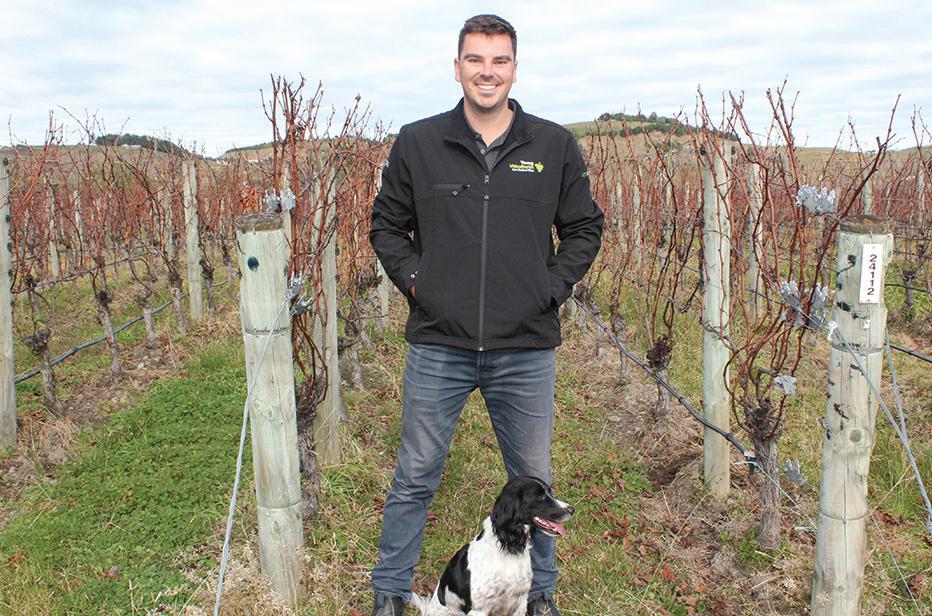
Nick Putt, 27 Hawke’s Bay Vineyard Manager at Craggy Range
Describe a great day at work in less than 15 words. Working with great people to produce top quality grapes and wine.
What makes your region special?
Hawke’s Bay is diverse in every sense – soil, climate, grape varieties, people – and this helps us to make a range of interesting and industry leading wines. The region has a mix of large growers and small boutique wine brands which provide exciting experiences and a cool wine community. This community is made up of some wise heads but also some sharp young people ready to make their mark and produce sustainable wine.
Tell us a little about the theme of your speech.
My speech was about the Austrian wine poisoning scandal, which saw the country’s exports drop 95% as a result. This
Zealand wine industry is climate change. Higher global temperatures and increasingly erratic weather patterns are making it more difficult to make decisions and predictions in viticulture accurately. Temperature increases are changing what we know about phenological development and bringing the season earlier, while we have more extreme events than ever before. We are being forced to adapt reactively, and while the industry has a carbon-neutral goal for 2050, we should be aiming to be carbon negative by then, if not sooner.
What are the most exciting developments in viticulture?
For me, it’s really exciting to see old practices developed over hundreds of years being reintroduced with the accuracy of modern science and technology behind them. The increase in practising regenerative viticulture alone shows that growers are recapturing the connection to the land that is essential to working with it. What is also exciting is new research currently underway for different rootstocks
in New Zealand soils. We have relied for a long time on research from other countries and, while the results are generally good, having locally relevant research will help the industry so much in the years to come.
highlights the importance of reputation and how scandals can quickly decimate an industry.
What are the most exciting developments in viticulture? Integration of technology is something which can help our industry hugely, at a
time when inputs are expensive. Currently there are many different systems out there which are now integrating vineyard specific updates. These will help to maximise the use of water and agrichemicals to target high risk periods and vines which are at higher risk.
56 I NEW ZEALAND WINEGROWER I AUGUST/SEPTEMBER 2023 THE PLACES
Tai Nelson, photo by Amber Soljan
Nick Putt
INNOVATION BRINGS US CLOSER

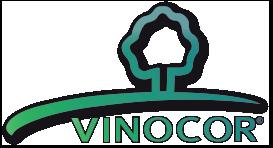


NATURE
With
Origine
TO
each Origine by Diam solution, winemakers can master the ideal oxygen level and optimal bottle aging duration depending on their wine profile and wine history. With all the Diam guarantees, this bio-based cork range enables winemakers to best meet their consumers everchanging needs and environmental issues.
by Diam, the power of choice
By: Vinocor, the exclusive partner for DIAM closures in Oceania. NEW ZEALAND Ph. +64 2157 5380 Email. andrew.twiname@vinocor.co.nz Web. vinocor.co.nz AUSTRALIA Ph. +61 8 8392 9999 Email. info@vinocor.com.au Web. vinocor.com.au Member of
Distributed
Central Otago Young Viticulturist of the Year 2023 Nina
 Downer, 24 Vineyard Supervisor at Felton Road
Downer, 24 Vineyard Supervisor at Felton Road
Describe a great day at work in less than 15 words
Someone has shouted smoko, I’m in the tractor listening to Brian FM and nothing goes wrong.
What makes your region special?
The people, a tight knit community of people who are open and friendly and always willing to share their time and knowledge with others. The fact that 25% of our region is under organic certification.
Tell us about your speech.
My speech topic was: The Year is 2050 and climate change has meant Pinot Noir is no longer viable to grow in Central Otago, advocate Gamay as our new champion varietal. Throughout the speech, I highlighted the fact that Gamay is a versatile variety that is suited to every wine demographic, from your cheaper everyday bottle to natural wine, to a complex red
INDUSTRY NEWS
wine with great aging potential that rivals red Burgundy. How the grape is suited to both cool and moderate climates holding onto acids better than Pinot Noir in warmer vintages. Also, a controversial comment was made about the average price of Central Otago Gamay being more expensive than the average price of Central Otago Pinot Noir found in the Cromwell Super Liquor at that time, and that therefore Gamay is already better than Pinot, got the desired reaction from a room full of Central Otago Pinot growers.
What are the most exciting developments in viticulture?
New technologies that are now emerging that will help us as an industry to become more efficient in all aspects, from data collection and analysis to technology that shows real time disease presence in the vineyard, are exciting developments that will make our goals easier to achieve. As growers are beginning to fully embrace the fact that we are going to need to make some changes to meet industry goals to be carbon neutral by 2050, people are now being more environmentally conscious in their business decisions.
Nina Downer
MARKETING UPDATES PROFILES ARCHIVES


LATEST RESEARCH REGIONAL UPDATES
58 I NEW ZEALAND WINEGROWER I AUGUST/SEPTEMBER 2023 THE PLACES
www.nzwinegrower.co.nz
Wairarapa Young Viticulturist of the Year

Annika Salenjus, 24 Vineyard Cadet at Craggy Range
Describe a great day at work in less than 15 words. The best days at work are the ones where the sun is shining and you get to learn something new!
What makes your region special?
The Wairarapa is a small region and the industry here is very close knit as a result. Being new to the area, everyone has been so welcoming and wonderful and made me feel so at home right off the bat.
Tell us about your speech.

My speech was on how the industry can best cope with the increasingly volatile seasons New Zealand has been experiencing in recent years, and specifically whether we should be looking to new management practices or planting new varieties. My stance was that there are benefits to both, and both are important tools for mitigating damage year to year, but focusing on combating climate change itself through regenerative agriculture practices is paramount for the long term.
What are the most exciting developments in viticulture?

For me the most exciting developments in viticulture are those that assist with data collection and tools that allow us to operate with much more precision at the vine level.
South Island Finalist
The South Island regional competition had not been held when this edition went to print. The finalist will be profiled in the next edition, following the National Final August 30. nzwine.com/en/events/young-vit
IT WOULD BE STINK IF THESE GOT INTO NEW ZEALAND
The brown marmorated stink bug is a pest that infests homes, ruins gardens, stinks when crushed, and is almost impossible to get rid of. It could also destroy our fruit and vegetable industries. It’s not in New Zealand yet, and we want to keep it that way. So if you see one, don’t kill it. Catch it, take a photo, and call us on 0800 80 99 66.



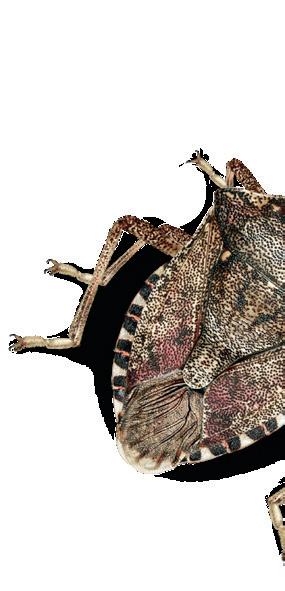

For more information (including how to identify the bug) visit biosecurity.govt.nz/stinkbug

NEW ZEALAND WINEGROWER I AUGUST/SEPTEMBER 2023 I 59 THE PLACES MPB0160 Stink Bugs not shown actual size. (Actual size approx. 1.7cm long)
Look for black & white banding on the antennae Look for black & white banding on the sides of the abdomen
Annika Salenjus
Marlborough Young Viticulturist of the Year

Zac Howell, 28, Technical graduate at Indevin. (Currently on secondment in a project coordinator role with the Vineyard Transformation Team.)
Describe a great day at work in less than 15 words.
It’s a Friday, and the sun is shining.
What makes your region special?
It’s hard to go past the place, and the people that make the winegrowing community here what it is. But one of the things I love about Marlborough is that thanks to scale, and a really successful business model with our Sauvignon Blanc, we’re often at the forefront of research and implementing new technologies, which can be really exciting.
Tell us about your speech.
I spoke to the gender pay gap in the New Zealand viticulture industry. Unfortunately, three minutes isn’t a very long time to get into any real detail on such a complex issue, but I think I managed to convey the
importance of fact checking, fairness, and the impacts this issue can have on overall sustainability.
What are the most exciting developments in viticulture?
The most exciting developments are really in the technology sector; the New Zealand viticulture industry has a rich history of innovation. Given the challenges the primary sector is facing with respect to workforce availability and the inherent tightening of environmental sustainability regulations, I think this is something we will see continue to ramp up in the coming years.

60 I NEW ZEALAND WINEGROWER I AUGUST/SEPTEMBER 2023 THE PLACES
Zac Howell
“We’re often at the forefront of research and implementing new technologies, which can be really exciting.”
WHY SPRAY WITH A BA VINE SPRAYER
For over 30 years BA’s Vine sprayers have been the choice for New Zealand’s leading corporate vineyards, contractors and vineyard owners alike.

Available now with BA’s second generation tangential cross flow heads, the industry standard in spray technology, just got better.
The Vine Sprayers tangential fan heads provide excellent turbulence within the canopy to maximise coverage.
Each head is fitted with nine individual nozzles to enable full canopy or bunch line spraying. Simplicity of spray head adjustment (nozzles on or off), ease of application rate setup (12 presets) with the ARAG Bravo 350 Auto Rate Control makes this the market’s simplest sprayer to set up while achieving maximum spray coverage.
Visit the new BA Pumps & Sprayers website to find out more about our range of vineyard sprayers and Collard vine maintenance equipment - bapumpsandsprayers.co.nz

0800 833 538 | www.bapumpsandsprayers.co.nz SUPERIOR COVERAGE WITH BA’S TANGENTIAL FAN BA VINE SPRAYER Simple to setup to maximise coverage Hot dipped galvanised and robust chassis construction for maximum corrosion resistance Bertolini Poly pump for maximum chemical resistance BA tangential fan technology for maximum leaf coverage.
Proudly NZ Made for over 30 years
Insurance Update
The cost and claims of climate change
Climate change presents a wholly different and more persistent challenge for the insurance sector and its customers than the recent pandemic, supply chain issues and inflation. This is not a temporary issue affecting sections of society, but rather one where a constant and concerted effort to adapt and modify how we do things is of paramount importance.
New Zealand has had a steady rise in climate-related insurance claims during the past 10 years. For the five years 2013 to 2017, the average cost of climate claims was $150 million. For 2018 to 2022, $276 million.

The past two years, 2021 and 2022, have come in at $324 million and $350 million respectively.
These rises have had to be factored into how our local insurers run their businesses, not just from premium setting and underwriting controls but also in increasing
James Vineyard Aerator
The Aerator is also used for root pruning which will produce new feeder roots and better production.


and realigning their teams and skillsets to help customers through more frequent and severe weather events.

Our local insurers and their reinsurance partners overseas have been well aware of climate-driven events across the globe –Hurricane Ian, to the major European floods,
MAJOR AGRICULTURAL EQUIPMENT
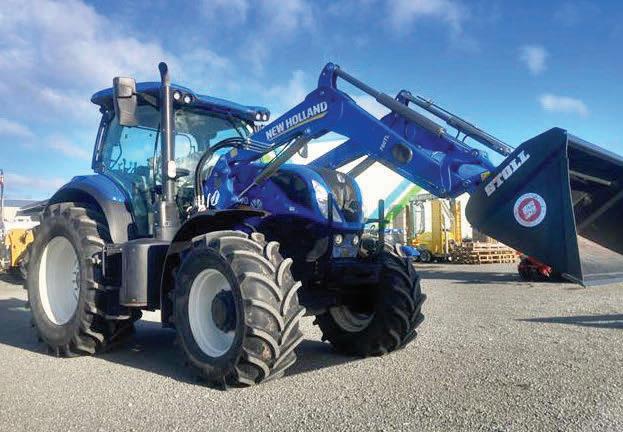

STARTS: FRI 25 AUG AT 2PM ENDS: THU 31 AUG FROM 7PM

Junction Road, Hornby South, Christchurch North
South
62 I NEW ZEALAND WINEGROWER I AUGUST/SEPTEMBER 2023 THE PLACES
In the wake of Cyclone Gabrielle. Photo Richard Brimer
DAN
SZEGOTA
Removes soil compaction and lets oxygen into the soil which helps release locked up fertiliser. Aeration also helps with drainage.
SOIL AERATION SPECIALISTS Maitland RD5, Gore Ph/Fax: 03 207 1837 Mobile: 027 628 5695
Scan here for more information
Island Inspections: Mon 28 - Thu 31 between 9am - 4pm Location: 652 Halswell
Island Inspections: Mon 28 - Thu 31 between 9am - 4pm Locations: 11
Pl,
Auckland and
NOTE: This is an Online BidNow Auction conducted on the Manheim website only. You must be a member to bid online. Register by visiting manheim.co.nz A buyer’s premium will be added to the purchase of each lot sold. Sale is GST inclusive. Visit www.manheim.co.nz for more information Bennett St, Palmerston North Bryan McNeilly M: +64 273 580 432 E: Bryan.Mcneilly@coxautoinc.com
Athy
Wiri
23D
ONLINE BIDNOW AUCTION
to the devastating floods and bushfires that have affected Australia in recent years. Each of the North Island’s recent events in isolation would have been, by far, the largest extreme weather event recorded in New Zealand. Insurers will be pumping more than $1 billion back into communities affected by the first event and likely as much – if not more – for Cyclone Gabrielle.
As insurance costs are claims driven, each insurer will now determine its own level of comfort for the immediate future and for many this will mean a reduction in risk appetite and offering capacity for certain risks. This in turn pushes up the premiums of those insurers that remain. Even before the recent events, insurers were seeking to reduce their exposure to natural catastrophes – weather related or not. The implications of this are significant and greater care when undertaking due diligence is needed to ascertain insurability of property and risks.
Premiums themselves will of course increase in the short term but, as the final cost of these events will take years to crystallise, these increases will likely continue for a number of years until the cost is accounted for. In addition to
premium rises, wholesale changes within the industry will take place. Flood may be considered an optional add on (as it already is in Australia), rather than automatically included as it is now.
about which insurers they choose to underwrite.
Insurers now have a greater collective duty to support their customers in mitigating environmental risk as part of general risk management and are very well placed to do so, benefitting communities as a whole. But the immediate concern is more generic, in that people need rapid answers about whether it is safe for some to return home or to have their homes rebuilt in the same places where they were so recently destroyed. The resilience of infrastructure is an urgent, and very expensive, question.
Properties will be risk assessed on a more granular level rather than region by region, with environmental risks such as cliff tops and waterfront properties being underwritten accordingly. The recent events have also been large enough to trigger the insurers’ catastrophe reinsurance cover, meaning reinsurers will be more selective
We can only cope better with this shift to more frequent and extreme weather events by building resilience into everything, which then supports insurers to keep insurance cover in place and relatively affordable. Unlike the pandemic and its flow on supply chain and inflation issues, this is not something that can be ridden out and eventually return to a form of normality.
What is clear is that insurance is only part of a much larger equation.
Dan Szegota is an Executive Broker at ICIB and leads the ICIB Gold Medal Vintage winery scheme.
ECLAT COLLECTION
GIVE PUNCH TO YOUR PUNT!
The Bordelaise Eclat range offers 6 different punts (Moon Rising, Star Shining, Fusion, Galaxy, Falling Star and Constellation) designed to reveal sparkle and radiance of the Saverglass Extra White flint and to show off the subtle and refined colours of white and rosé wines. Eclat Constellation is also available in BVS 30H60 screw finish.
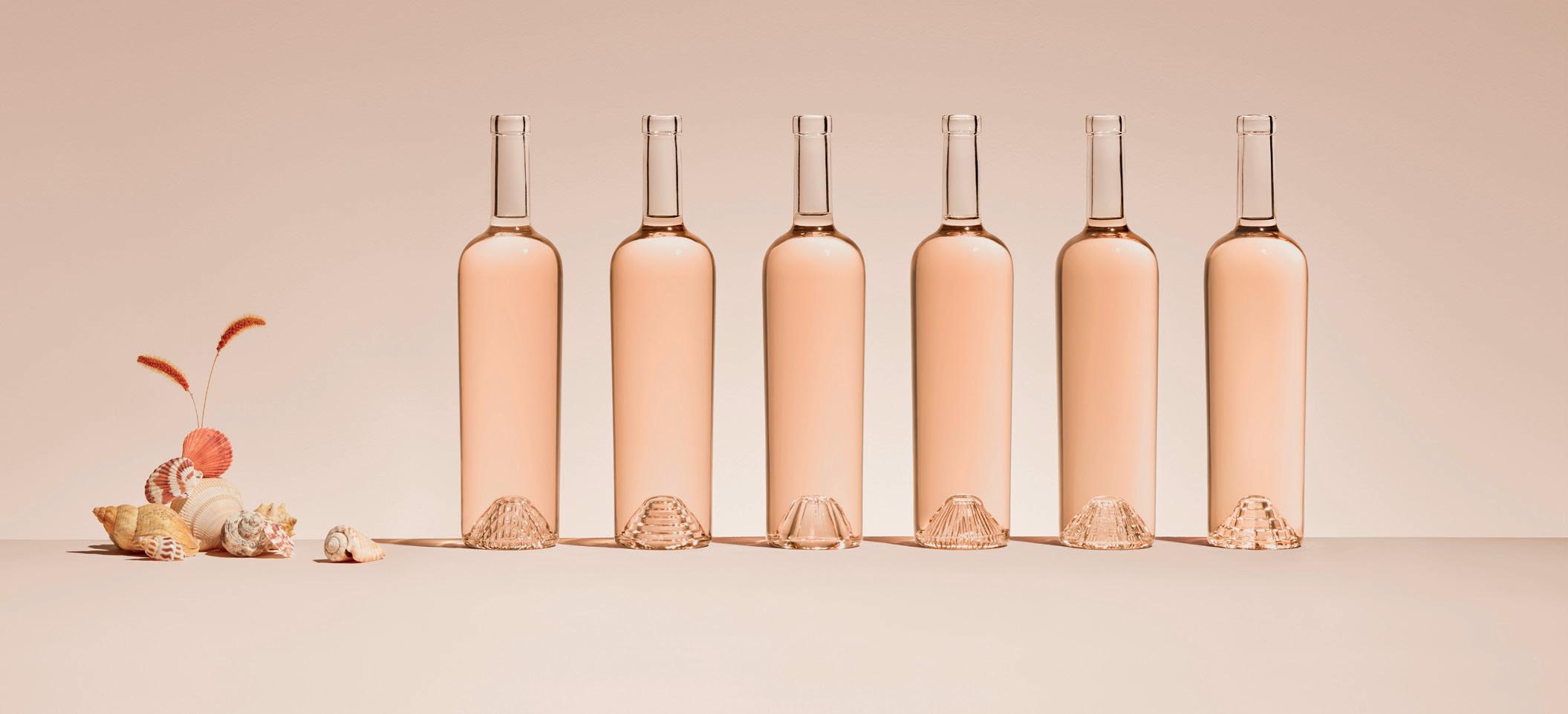
NEW ZEALAND WINEGROWER I AUGUST/SEPTEMBER 2023 I 63 THE PLACES
Saverglass (NZ) Limited | www.saverglass.com Haute Couture Glass | Tel +64 9 522 2990
“As insurance costs are claims driven, each insurer will now determine its own level of comfort for the immediate future, and for many this will mean a reduction in risk appetite.” Dan Szegota
Point of View
Emission reductions
Rainfall gauges broke records all over Hawke’s Bay in 2022, including a staggering 4273.5mm for the year at Mt Manuoha. And that was before Cyclone Gabrielle unleashed her fury on the region in February 2023. Over the course of 10 years in Hawke’s Bay, I have had the privilege of working with many vineyards under some capacity, whether it was as a contractor or part of the winemaking team. Such extreme weather events and their impacts, like the heartbreaking decisions some growers had to make about abandoning their crops, were once a mere prediction; a grim vision of a possible future. Today, they are a stark reality; a manifestation of the escalating issue of climate change.
Emission Reduction Plan, Carbon Neutral Government Programme, and sector specific commitments and other programmes, is leading the charge towards a brighter future. The aim is to become climate neutral by 2050 and keep global warming within safe limits. It’s time we acted on this urgent call.
Measure to manage
practices in the winery. All could make a significant difference. But it’s not just about what we do in the vineyards. We can also opt for net carbon zero suppliers to lessen our impact.
We need to understand that climate change isn’t an event in the future, it’s happening right now. I feel acutely aware of the challenges and frustrations, but who’s to blame?
Over the past several years, the Intergovernmental Panel on Climate Change (IPCC) has published more than six reports, all of which state that human activities, principally through emissions of greenhouse gases (GHGs), have unequivocally caused global warming. To put that in a language we can all understand, our activities – including producing GHGs – are warming the planet. New Zealand has made commitments to keep global warming below 1.5C, and to do so we need to reduce these emissions fast.
Aotearoa New Zealand, with its Climate Change Commission, the Zero Carbon Act, the release of the first
The New Zealand wine industry has already stepped up. From the New Zealand Winegrowers (NZW) Annual Report, and my interaction with growers and producers, many of the Sustainable Winegrowing New Zealand (SWNZ) certified wineries have a relative grasp of their carbon emissions. We are also making strides in managing emissions from fuel use (Scope 1 emissions) and exploring alternative technologies that can replace our reliance on fossil fuels. There are some challenges in addressing fuel use, but there is increasing research and development in finding alternates. The low emission technology shown at Fieldays this year was very encouraging to see. I learnt from many in the supply chain that there is ongoing research carried out in developing automated electric options, which may not completely replace a tractor for now, but would substitute in for some tasks like under vine weed management.
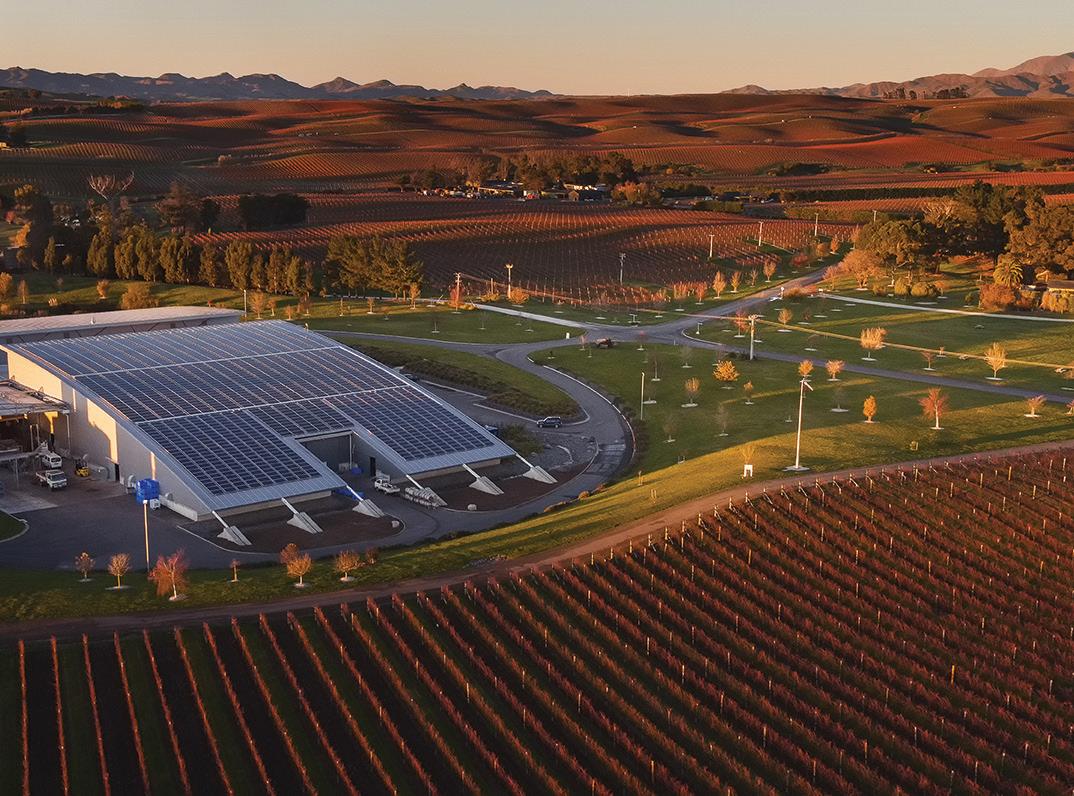
Low hanging fruit
There are reduction opportunities ripe for the picking. Simply reconsidering our agrichemical inputs, fine tuning application rates, maintaining equipment upkeep in the vineyard, to revisiting our cleaning chemicals, or rethinking water management
Emission reduction options in Scope 2 (purchased energy) have come a long way, even in the last few years that I have been doing GHG accounting and reporting. New Zealand’s electric grid is mostly renewable, and there is an increased number of options available, from moving to net carbon zero suppliers, to the purchase of Renewable Energy Certificates and on-site renewable electricity generation using solar or wind.
Many wineries have switched to ammonia (R717) refrigerants with zero global warming potential. This means a drop in GHG liabilities, which are mandatory to be reported in the GHG inventory when seeking carbon certification. Even minute changes, like preventing accidental leaks from fuel tanks and refrigeration plants, can aggregate into substantial emission reductions over time.
Go wide for a bigger impact
We must not forget about Scope 3 emissions, which arise from our value chain, service providers, and consumers. Under the GHG Protocol, we are encouraged to use supplier specific emissions factors wherever possible. Improving data quality is the first step towards reducing these emissions. After all, we can only manage what we accurately measure. Engaging with your suppliers can also help them make necessary investments and operational decisions to decarbonise.
Science-based targets are another key
64 I NEW ZEALAND WINEGROWER I AUGUST/SEPTEMBER 2023
UTTAM FLORAY
“ripe for the picking”
“It’s not just about what we do in the vineyards. We can also opt for net carbon zero suppliers to lessen our impact.”
Uttam Floray
Yealands Estate
piece of the puzzle. The wine industry has committed to the goal of being net carbon zero before 2050. But waiting until the last moment won’t suffice. A steady, ongoing reduction plan can help us track our performance year after year and ensure we stay on course. Sciencebased targets are key to this, as they help companies set ambitious reduction targets in line with the latest climate science to meet the goals of the Paris Agreement: limiting global warming to well below 2C pre-industrial levels and pursuing efforts to limit warming to 1.5C.
As the climate changes, it has also threatened the terroir, the unique combination of factors including the soil, region, and people that give a wine its character. With shifting climates come new challenges in grape ripeness, disease pressure, and canopy management. Vine diseases are migrating down the latitude, necessitating increased use of agrichemicals in some cases to cope with it. In an interview with The Guardian, John Hancock concurs that the timing of grape harvest in New Zealand has shifted as the climate has changed.

However, adversity breeds innovation. The changing climate has opened opportunities to explore new terroir, experiment with different varietals, and innovate our winemaking styles.
The journey to a greener future is long and challenging, but achievable if we take bold steps, tell compelling stories, and actively encourage every part of our industry to join in the fight against climate change. The future we want to see is within our grasp. Let’s reach out and take it.
Walking the Talk (lightly)
Several New Zealand wine companies are Toitū carbonzero –Yealands, Delegat, Indevin, Lawson’s Dry Hills, Astrolabe and Greystone – as are some of the industry’s biggest suppliers, including Riversun Nursery, Farmlands, and WineWorks. Meanwhile, New Zealand Winegrowers is Toitū carbon reduce certified, and has committed to the goal of the New Zealand wine industry being net carbon zero before 2050.
New Zealand’s Vintage Winery Engineers
We know wine.
Sauvignon, Chardonnay, Albariño… well, while we do love a good drop, what we really mean is that we have decades of wine industry experience and know the industry and processes inside out.
This understanding enables us to offer insights and create seamless solutions that make a real difference for even the most complex projects.
Learn more about our winery engineering services and experience.


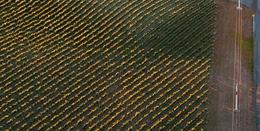

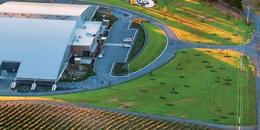
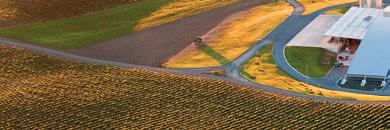



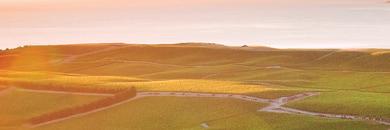


Marlborough Canterbury Hawke’s Bay Otago
kotahistudio.co.nz/winery
NEW ZEALAND WINEGROWER I AUGUST/SEPTEMBER 2023 I 65
Uttam Floray
Wine Weather

What’s been going on?
JAMES MORRISON
After three years of La Niña, a change is finally upon us. The rain-drenched areas of Gisborne and Hawke’s Bay should be in for some relief from the cloud and wet as El Niño should bring a different synoptic pattern to our weather. But there may be new challenges in spring as the westerlies return to pound parts of Aotearoa. A quick refresher for El Niño is that the increase in west to southwest winds means that the fronts and weather systems that move in from the west can race through at quite a pace. Eastern regions, where many of our grapes are grown, could be buffeted by strong winds and are also at risk of frost under clearing skies as the flow turns southwest.

El Niño and climate change: Social media and news sites all over the world have been inundated with posts and stories around the current state of the world’s oceans and the temperature anomaly that is occurring. Arctic and Antarctic sea ice and intense heat domes are other topics that commentators are regularly pointing out.
Over hundreds of years, scientists have established patterns between our air and sea and the natural environment. We have learned more and more about our climate drivers and how they affect the day-to-day weather. The issue that is now arising is that changes to sea temperature, sea ice, and
ground cover are accelerating changes to our climate. In the high latitudes and areas that have a fragile ecosystem the effects are profound and very noticeable. For example, the Antarctic sea ice record is currently at its lowest ever point for this time of year. Snow and ice cover in the arctic has depleted and this changes the albedo of these regions. The albedo is the ability of a surface to reflect or absorb energy. Snow and ice are particularly good at reflecting large amounts of energy back into space and so in recent history the poles have remained frozen all year round. Now we have accelerated warming and large areas of land and water are becoming snow and ice-free for longer. This means we have compounding problems where the exposed ground or water will absorb more energy from the sun and become warmer faster. The slow release of this energy means that these areas will stay warmer for longer.
All of this is adding energy to our climate and increases the global sea and land temperature. El Niño is usually the bringer of above average temperatures to the northern hemisphere and drier and normal weather for Southeast Asia. This has the potential to spill over into New Zealand, and severe droughts have occurred in El Niño years. The other effect that El Niño has on the weather of New Zealand is that it can bring cooler conditions and strong winds. We have one of the few climates where temperatures can be colder under El Niño. It often increases the risk of frost in spring for eastern regions as the alps and ranges shelter the east coast from the westerlies that roar out of the Southern Ocean. No two El Niños are the same and it will be the other climate drivers such as the Southern Annular Mode that will influence how our spring will play out.
66 I NEW ZEALAND WINEGROWER I AUGUST/SEPTEMBER 2023
Mulch and Mow in One Pass!
Outlook for August and September: Gisborne/Hawke’s Bay
Mean temperatures are likely to remain near or above average through August and September and this continues the trend of the first half of 2023. The difference is that daytime maximums are likely to be milder thanks to an increased westerly flow. Nighttime minimums are likely to become cooler and near average for late winter/early spring. Warm Sea temperatures may continue to make rain bearing events more active for a time however these are expected to become less frequent and rainfall totals should be close to average. Sunshine hours should start to lift in the second half of 2023 and replace the gloom of the preceding seven months.
Wairarapa
Wairarapa should remain above average as far as mean temperatures are concerned. The diurnal range should increase as days become milder but nights become cooler. The regions should also start to become drier but southerly changes are still going to pack some punch. The lower North Island is likely to become windier through August and September as El Niño ramps up, so the risk of gale force winds about Wairarapa increases this year.
Nelson
Temperatures remain warmer than average. There may be an increase in frost through late winter and the first half of spring as the upper South Island can be well sheltered under a southwest flow. Rainfall totals are likely to be near average with rain events likely to be from fronts approaching on a strong northwest flow. As the frequency of westerly quarter winds increases there is likely to be more wind for the Nelson region through early spring.
Marlborough/North Canterbury
A warmer and drier couple of months is on the cards for the east coast of the South Island, but like most other regions, cooler nighttime temperatures are expected for early spring. There is an increased risk of frost across Marlborough and North Canterbury, especially on the back of fast-moving southwest changes. Like Nelson, these regions are well sheltered from the southwest and we have already seen in July how cold conditions can become under a southwest flow. Rainfall totals are likely to be near or even a little below average. Watch for the wind as well with the possibility of northwest gales this spring.
Central

Otago
With a latitude that is adjacent to the Southern Ocean, Central Otago could be in for a busy time as far as weather events go. Active frontal systems may push reasonable amounts of rain well into the lower South Island and strong northwest winds are likely to be more dominant than they have been over the past five years. Mean temperatures should remain above average but there will still be a risk of frost under building anticyclonic conditions. Timing will be critical this year though as westerly winds under El Niño tend to push through fronts at a real pace and high pressure does not get much of a chance to bring settled conditions.
James Morrison runs Weatherstation Frost Forecasting: weatherstation.net.nz
Dripline Recycling Programme
Sustainably
posts for use in vineyards and farms

NEW ZEALAND WINEGROWER I AUGUST/SEPTEMBER 2023 I 67
“We have one of the few climates where temperatures can be colder under El Niño.”
James Morrison
recycle your end-of-life dripline into
Purchase Rivulis industry leading dripline for your replacement programme and receive a pre-paid voucher* to recycle any brand of dripline at Future Post’s facility in Blenheim. * Conditions apply. Please ask your local irrigation reseller for further details. To find your local dealer contact Water Supply Products: Auckland: 09-916 0094 Christchurch: 03-348 1293 wsp@watersupply.co.nz www.watersupply.co.nz
Biosecurity Challenges for New Zealand’s Future


Gazing into the Crystal Ball
Biosecurity stakeholders are becoming increasingly concerned about how well our biosecurity system will stand up to challenges such as climate change, future trade patterns, changing population dynamics and agrichemical availability. A recent study by a group of New Zealand researchers in the Better Border Biosecurity (B3) collaboration examined a suite of ‘global megatrends’ and how these might impact on New Zealand’s biosecurity system in the future. Here we highlight just some of the megatrends identified as likely to impact on plant sector biosecurity in New Zealand.
Agrichemical availability
Globally, demand for pesticides for food production continues to increase. At the same time, there is pressure to remove broad-spectrum pesticides from use and replace them with greener, more targeted chemistry. Loss of agrichemical controls and scarcity of product may allow pest
populations to increase overseas, and arrive in greater numbers at New Zealand’s border. New Zealand itself is a small market for agrichemical suppliers, and it can be difficult to get new products registered for use here; therefore there is a risk that existing chemicals are withdrawn from use without suitable replacements, limiting our ability to deal with pest outbreaks onshore.
Climate warming
According to the Ministry for the Environment, as local climates change in response to rising CO2 levels, New Zealand is expected to get warmer, with the east becoming drier while the west becomes wetter. As a result of global climate change, pest distributions will shift overseas. Within New Zealand it is predicted that pest species already present will increase in population and cause more damage. New invasive pest
READ IT ONLINE


species will also find the warmer conditions more suitable and become more likely to establish and spread. Combined with this, land-use change (as some crops become more difficult to farm and climate becomes more suitable for others) may contribute to the arrival of new invasive species as new crop types and new varieties of existing crops are sought from overseas.
Global trade patterns
Global trade has been increasing for decades, with data showing it has more than doubled every 20 years since the mid-1900s. As the effects of climate change are felt regionally and impact supply and demand, it is expected that trade patterns, commodities and routes will all shift. This in turn will expose New Zealand to new biological threats. As trade continues to increase, biological invasions are expected to occur
68 I NEW ZEALAND WINEGROWER I AUGUST/SEPTEMBER 2023 THE PLACES
Te Motu
www.nzwinegrower.co.nz GENERAL NEWS OPINION PEOPLE PROFILES REGIONAL UPDATES AND MUCH MORE NOW
Reading the magazine online has never been easier.
SOPHIE BADLAND
more frequently, meaning more resource will need to be allocated to biosecurity response and management.
Population mobility
Similar to trade patterns, data shows the number of international travellers coming into New Zealand has been increasing over a long period of time. Prior to the Covid-19 pandemic, almost 4 million tourists were arriving annually via air travel or cruise ships. Increasing numbers of travellers bring increased risk of hitchhiker pests arriving in New Zealand. Hitchhiker pests generally are not associated with any particular commodity and are therefore notoriously difficult to predict and manage. The brown marmorated stink bug (BMSB) is a hitchhiking pest and is at the top of the Most Unwanted list for the New Zealand wine industry.
Sea and air currents
Recent oceanographic studies show there has been a substantial acceleration of global mean ocean circulation since the early 1990s, increasing the speed of ocean currents in several areas. In New Zealand, NIWA predicts stronger westerly
winds will occur across the Tasman sea throughout winter, particularly affecting the lower North and South Islands. Wind and water natural dispersal pathways for pest incursions are particularly hard to manage, with models struggling to account for the number of factors that can influence where pests might eventually come to rest, and surveillance needing to occur over large areas to provide early warning of an incursion. Wind events can also result in simultaneous incursions in multiple regions. In 2022, the fall armyworm, predominantly a pest of maize crops, arrived in New Zealand and has since spread to several regions. It is thought it arrived via a wind event, likely blown over from Australia.
Urbanisation
Globally the number of people living in urban centres (as opposed to rurally) has been steadily increasing, with the United Nations predicting more than two thirds of the world’s population will be urban by 2050. In New Zealand this is already higher, with 86% of people living in urban areas (though many work rurally). Urban populations tend to be less
aware of biosecurity risks than their rural counterparts, and often do not experience firsthand the consequences of biosecurity incursions. This makes maintaining social licence to respond to new incursions in urban areas more difficult.



Where to from here?
The B3 report highlights a raft of challenges facing New Zealand’s biosecurity system as we look to the future, most of them related in some way to climate change and population growth. The report suggests four priority areas for future research, to help us better understand and navigate these challenges – future pests and threats, changing pest pressure on the border, vulnerablity of host plants and ecosystems, and evolving biosecurity management tools. There is a real need for biosecurity research specific to the New Zealand context, as our experience of climate change and other future trends will undoubtedly differ from that of other countries.

Read the full B3 report –Global Change and New Zealand Biosecurity – at b3nz.org.nz/globalchange-and-new-zealand-biosecurityreport/.


NEW ZEALAND WINEGROWER I AUGUST/SEPTEMBER 2023 I 69 THE PLACES
OF BAYLEYS SALES PEOPLE 2019-2023
TOP 5% BAYLEYS MARLBOROUGH SALESPERSON 2019-2023
Advocacy on matters of vital importance to the industry
Larissa Trownson
ANNUAL MEMBERS’ MEETING
The New Zealand Winegrowers (NZW) Annual Members’ Meeting will be held on Thursday 31 August at 3pm. For the first time ever, the meeting will be fully hybrid (NZW has engaged an external provider to assist with this). This means members can attend:
• in person, at the Shakespeare room at Toitoi Hawke’s Bay Arts and Events Centre, 109 Hastings Street South, Eastbourne Corner, Hastings; or • online, by registering in advance at: https://us02web.zoom.us/webinar/ register/WN_a_Efqf6jQzivo22_NZ1pOQ (this link has also been sent directly to members). If you have not received an email after registering, please check your junk or spam folder. Alternatively, contact advocacy@nzwine.com for assistance.
All members present, whether in person or online, will be able to take part in the quorum, ask questions (by chat or video) and vote. Members who are unable to attend the meeting may also appoint a proxy to attend and vote on their behalf. More information on the meeting, including how to appoint a proxy, can be found on NZW’s webpage: nzwine.com/
Levy Rates for 2023/24
members/about-us/governance/annualmembers-meeting-2023 (or just search ‘Annual Members Meeting’).
If you have any questions, please contact the NZW Advocacy team at advocacy@nzwine.com.
On 29 June 2023, the New Zealand Winegrowers Board set the following levy rates for the year 1 July 2023 to 30 June 2024. These have risen by 5%, which is in line with the proposal sent to members in May.

Wine levy
The levy rate to apply to sales of grape wine is 2.89 cents plus GST per litre.
Grape levy
The levy rate on winegrapes from vintage 2024 is set at the rate of 0.866% as follows:
(a) If sold by or on behalf of the grower, 0.866% of the farm-gate price plus GST;
(b) If exported by or on behalf of the grower, 0.866% of the free on-board value plus GST;
(c) If made into grape juice or grape juice concentrate, 0.866% of the notional value plus GST.
In the case of (c), the notional price for the year 2024 vintage has been set as 75% quartile for the region and variety concerned as determined from the 2023 vintage as listed in the last published version of the NZW grape price data for that vintage. If you have any questions about this, please contact Hannah Stanton-Kerr at hannah@nzwine.com or (09) 306 5528.
These rates are set by NZW pursuant to clause 9(1) of the Wine (Grape Wine Levy) Order 2022 and clause 11(1) of the Commodity Levies (Winegrapes) Order 2022. If you have any questions, please contact the NZW Advocacy team at advocacy@nzwine.com.
XXXXXXXXX 70 I NEW ZEALAND WINEGROWER I AUGUST/SEPTEMBER 2023 XXXXXXXXXOn your
behalf
Escarpment
THE ONE AND ONLY.
The Fendt 200 V/F/P Vario comes standard with FendtONE –the latest and greatest in onboard technology.


FendtONE Onboard Technology:
Unique interconnection of up to 2 integrated screens World first freely programmable armrest with 2-way, multi-function joystick Enables individualisation of entire working environment
The Fendt 200 V/F/P Vario delivers the power and performance you need to drive your business now and in the future.
www.fendt.com/au It’s bold - It’s Fendt.
Nuts and bolts
Mark Daniel’s updates on machinery and technology
BioScout Taking the guesswork out of
fungal diseases
Lewis Collins was working on spore trapping as part of his microbiology studies when he thought about the challenge of analysing airborne diseases. By the time useful data was received, it was typically too late to avoid an outbreak within a crop.
With his mechatronic engineering cap on, Lewis had a vision of automating the process so that growers could get a real-time understanding of the minuscule pathogens in their environment. BioScout is a high-tech solution that takes the guesswork out of detecting fungal crop diseases, such as Alternaria fruit rot or downy mildew, allowing a better focus on other vineyard tasks.
Typically, growers rely on intuition and symptomatic indicators to manage disease in production crops, often resulting in spraying too much, too often and at the wrong time. BioScout is said to allow growers to see the ‘unseeable’ and react to a disease presence weeks before it impacts yields, whilst also reducing preventive sprays by understanding the general disease risk. Three installations near Blenheim are currently in their first season of use in New Zealand.
The BioScout Platform is fully autonomous and can operate for many years on end without human intervention. Alongside a world-first airborne disease tracking ability, they are equipped with a comprehensive suite of environmental sensors, including monitoring weather conditions and live spore counts. This allows the system to provide the complete picture of disease risk at field-level resolution, typically up to two weeks before symptoms become apparent in the crop.
In operation, air is drawn into the units causing particles to adhere to a sticky strip. These particles ae constantly photographed using automated microscopy. From here, an AI function compares the photos with a
constantly expanding database of pathogen images. This allows the system to track the spread of fungal diseases in vineyards, providing growers and agronomists with real-time, location and disease specific data. As a rule of thumb, one BioScout device would be able to offer informative data for 20 to 100 hectares, although unit density would depend on topography and target diseases, decided by a site survey.
Spore numbers are taken daily and relayed to growers via custom dashboard software, in conjunction with standard weather data (temperature, humidity, rainfall, wind speed and direction). Customers can filter data based on individual units, target diseases and timeframes to help make informed

decisions on disease management.
The full BioScout dashboard can be viewed on a laptop, displaying a map of an individual property, showing the location of the devices, all current pathogen warnings and weather information. The company suggests that having a better understanding of how critical environmental conditions affect your disease risk, allows growers to apply fungicides exactly when needed for maximum effectiveness and an improved return on investment. At the same time, it also offers peace of mind by removing the ‘unknown factor’, while also improving confidence in reducing fungicide use and offering the choice of switching to more biological solutions.
Electric pruning shears increase efficiency
Pellenc’s latest generation of pruning shears are said to make it faster and safer to prune vines, fruit-bearing, ornamental, or forest trees. Built to last, the body, ball screws, and nuts are all made from high-strength materials, while routine maintenance servicing has been stretched out to once every 400 hours of use
Pellenc claims that irrespective of diameter or hardness of the vine to be cut, the high-performance cutting head ensures effective, clean pruning, with machines available with 35 mm (model C35) or 45mm diameter capacities in the Model C35 and C45 respectively.
Featuring the latest generation, brushless geared motor, power is provided by the 150, 150P or 250 battery options, offering outputs of 865, 1730 and 1730 watts respectively, with the 150P option only weighing the same as the 150 at 845 grams compared to the 250 unit at 1680g. Standard charging to 100% is around 8 hours, although 1A and 2A charging systems can reduce this to 4.5 or 3.5 hours respectively. The company suggests that irrespective of battery choice, each should allow a full day’s work.
The new PELLENC-patented Activ’Security safety feature stops the blade instantly if it encounters the user’s hand. hydralada.com
72 I NEW ZEALAND WINEGROWER I AUGUST/SEPTEMBER 2023 XXXXXXXXX MACHINERY UPDATES
Compact seeder makes for light work between the vines

Grass cover in vineyards is an ideal method of erosion control, particularly on slopes, as well as offering grazing for sheep during the winter period. The Giltrap-Duncan Vineyard Seeder, offered in 1.8 or 1.5m working widths, is the ideal solution for drilling such crops. With an overall width of just 1835mm and a length of 1610mm, the machines feature a linkage mounted hitch that ensures they are able to achieve the tight turns into the space between rows.
A dual box/hopper, each of 209 litres capacity, allows the use of seed and fertiliser, with easy access for filling via a rear-mounted foot board. Using a gravityfeed, the hoppers feature stainless-steel agitator shafts, that feed a mechanically driven peg tooth roller system that regulates seed and fertiliser rates via a mechanical gearbox. At the machine’s lateral extremities, robust guarding protects the gearbox, side handles and setting mechanism from becoming entangled in the vines.
Set up to deliver a 180mm row spacing, the 1.8m seeder features 10 rows, with the drilling element configured with double discs to cut into the hard, dry and often stony conditions found in a vineyard. This layout offers the ability to establish a cover crop in a single pass without any pre-cultivation. Although able to perform without press wheels, Giltrap Sales Manager, Matt Moodie notes, “most users specify the press wheel option, as it ensures good soil to seed contact for a quicker germination, particularly in drier
conditions”.
Weighing in at 873kg, the 1.8m seeder is easily handled and powered by a tractor of 50 or 60hp, while purchasers are also able to customise the seeder to suit individual conditions.
Users specifying the electric drive system also benefit from being able to use the Duncan app, which allows operators to set machines with previous settings, and to carry out calibration checks from a portable hand-held device or tablet. giltrapag.co.nz

As world leaders in biosensor technology, our reputation is built on precision.
That’s why you can trust the Sentia™ handheld wine analyzer to reliably measure:


• acetic acid (NEW)
• titratable acidity (NEW)
• fructose and glucose
• free SO2
• malic acid
Test results in minutes, wherever and whenever you need them.
Protective case, lanyard and stylus optional extras.
NEW ZEALAND WINEGROWER I AUGUST/SEPTEMBER 2023 I 73 NUTS AND BOLTS
Contact 04 390 3577 or info@grapeworks.co.nz
The most convenient wine analysis tool available.
Research Supplement
A regular feature to inform and update the wine industry on research projects being undertaken for their benefit. Newly approved projects when available are briefly summarised. Ongoing projects have longer articles that describe progress and what has been achieved so far. When completed, each project report will be shared in full detail in the Research Library on nzwine.com.
Current research projects
Bragato Research Institute conducts research in-house or collaborates with research organisations throughout New Zealand. The main research providers for each project are listed.

Viticulture
Pinot Noir Programme
University of Auckland, Plant & Food Research, Lincoln University
Improving remedial surgery practices to increase vineyard longevity
Linnaeus, SARDI
Long spur pruning as an alternative to cane pruning for Sauvignon blanc
Bragato Research Institute
Weevils in New Zealand vineyards
Bragato Research Institute
Microbial community and vine responses to increasing temperatures in the New Zealand context
University of Auckland
Evaluating water use efficiency and drought tolerance of various rootstocks grafted to Sauvignon blanc
Bragato Research Institute
Grapevine Improvement
Sauvignon Blanc Grapevine Improvement Programme
Bragato Research Institute, Plant & Food Research, Lincoln University
National Vine Collection virus eradication
Bragato Research Institute
Tuned Vines
Bragato Research Institute
Wine Science
Prevention of quercetin instability in bottled wine
Indevin
The effect of winemaking decisions on polysaccharide content in wine
University of Auckland
The importance of green: understanding ‘green’ and ‘herbaceous’ characters in Pinot noir wine and their role in driving judgements of perceived quality
Lincoln University
Exploring reductive aromas in Pinot noir
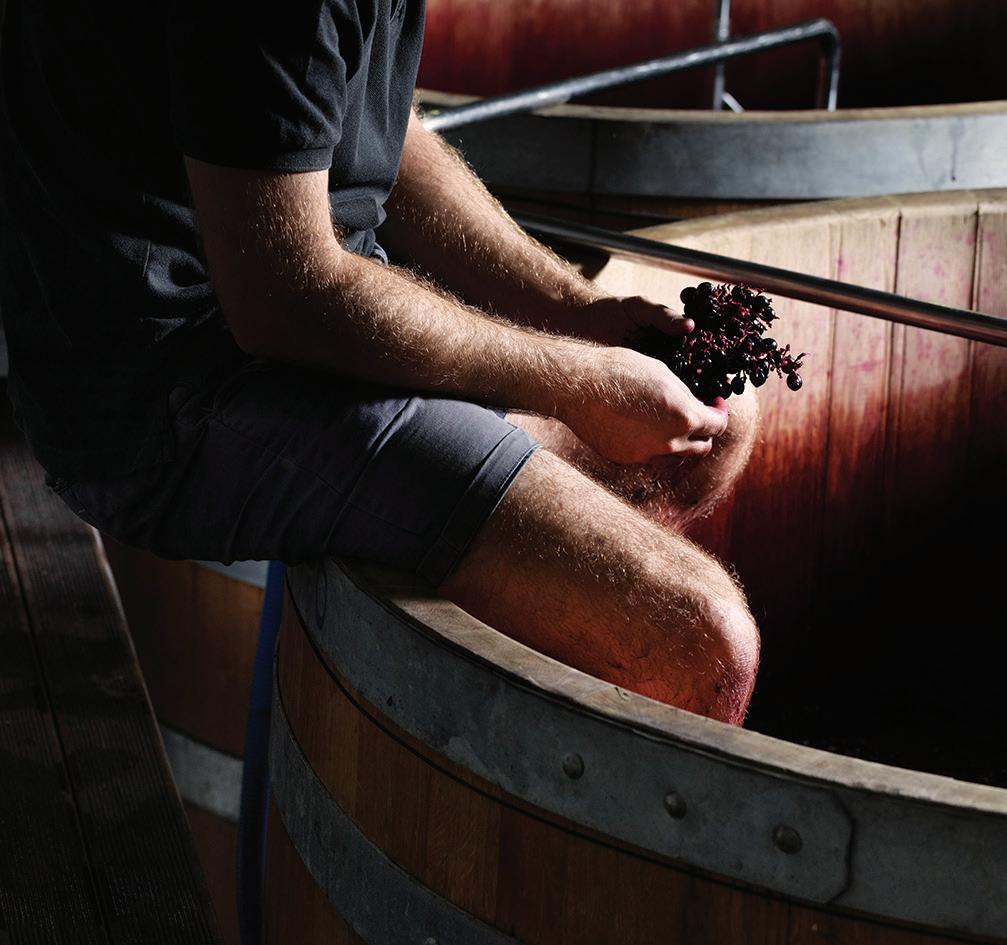
University of Auckland
Precipitation of calcium tartrate and other compounds in wine
University of Canterbury
Potential applications of nanotechnology for wine growing in New Zealand
University of Auckland
Winealyse Lab on a Chip
University of Canterbury
Sustainability
Microbial responses to under vine treatment
Bragato Research Institute, AERU, Lincoln University
Shared vision for land use in Marlborough
Bragato Research Institute, Meihama, AgResearch, Tipuake systems, Market Economics
Development of an anaerobic chainelongation bioprocess for grape marc valorisation
University of Auckland
Evaluating ecologically sustainable ways to disrupt the wētā-vine association
Plant & Food Research
Paul Sutherland Photography
Factors influencing Pinot noir berry weight and resulting wine quality
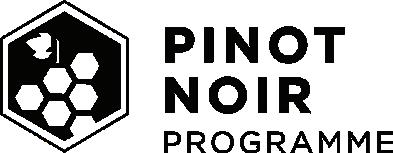 Martin D, Grab F, Scofield C, Schurmann M, Stuart L, Grose C (Plant & Food Research)
Martin D, Grab F, Scofield C, Schurmann M, Stuart L, Grose C (Plant & Food Research)
Since the initiation of the Pinot Noir Programme in January 2018, we have established a network of 12 trial sites in three New Zealand regions (refer to page 80 for map) in a search to find individual vines that produced acceptable commercial yields (above 1.75 kg per metre of row) and wines of composition comparable to that of wines made with ‘Icon’ vines.

Five seasons of study have shown that berry weight is the dominant factor driving changes in berry, juice and wine composition. As the berry size decreases, there is a proportional increase in marc:wine ratio that in turn leads to a correlated increase in wine colour density and total phenolics. Smaller berries also have higher colour and phenolic content per unit area of skin. The effect of berry weight on composition is stronger than that of vintage, which in turn is stronger than yield, vineyard or region effects.
What does the international literature say about berry size and vine water deficits?
Soil water content and consequent vine water status has been extensively shown to strongly influence yield, berry size, fruit composition and overall wine quality. Vine water deficits lead to smaller berries and changes in fruit and wine composition. In Pinot noir, leaf water potential and surface soil water content have shown relationships with yield components (berry weight, cluster number and yield) but not with vine size. Higher (less negative) leaf water potential, and therefore lower water stress in the vines, related directly to larger berries but without associating directly with higher yields in all cases. Smaller Pinot noir berries had more anthocyanins, phenols and higher total soluble solids.
The effect of water stress on Pinot noir vines has also been tested using carbon isotope discrimination testing (δ13C) of juice and wine because photosynthates from water stressed vines have relatively more 13C than 12C which results in a less negative C isotope ratio. Findings have shown volatile compounds such as
higher alcohols and acetic acid were generally more abundant in wines from mild to severe water-stressed treatments. This effect was more evident when irrigation restrictions were accompanied by hot and dry summers. A moderate water stress in Pinot noir vines has also been shown to result in more complex and structured Pinot noir wine than those from well-watered vines.
Research in California has shown that a harvest juice δ13C value more negative than -27‰ corresponds with a mean seasonal stem water potential above -1.0 MPa, indicative of no (or very weak) vine water stress. It has also been shown that juice and wine carbon isotope ratios are well correlated to each other and to leaf water potentials for a given variety.
Berry weight differences were not always related to vine water status
All the vineyards in our ‘Ideal vine’ study had drip irrigation installed and very few vines in the overall population displayed visible water-
RESEARCH SUPPLEMENT NEW ZEALAND WINEGROWER I AUGUST/SEPTEMBER I 75
deficit symptoms in the dry 2019, 2020 and 2021 vintages. Carbon isotope testing of the wines carried out in 2018, 2019 and 2021 showed only minor differences in overall seasonal vine water status (Figure 1). Regression plots show negative linear relationships between δ13C and berry weight that are season dependent. The slopes of the regressions are similar between vintages but the berry weight is offset, suggesting that something other than vine water status was having an effect on berry size. For a (well-watered) δ13C greater than -27 ‰, the predicted mean berry weight of the overall study population was approximately 1.4 g in 2018, 1.2 g in 2021 and 1.0 g in 2019. Figure 1 also suggests a tipping point at a δ13C above -27‰ where berry weight is reduced as vine water deficit increases. Less than 10 % of the wines had a δ13C in the range of -26‰ to -24‰, which is considered the weak to moderate water stress range. While very short-term vine water deficits that reduced berry weight and increased berry skin colour cannot be completely ruled out, it seems unlikely that the entire study network of 12 vineyards would be concurrently affected in a similar way.
What caused season and vineyard related differences in berry weight?
While vine water status is often the primary cause of reduced berry size, other seasonal factors can affect berry growth. For example, weather conditions during early berry development, leaf area at flowering or nitrogen supply between fruitset and véraison. In our study, bunch weights for Pinot noir Abel clone and, to a slightly lesser extent, berry number per bunch, were highly correlated to the mean maximum temperatures (Tmax) experienced 7 days either side of mid-flowering (Figure 2). Berry size was also significantly but less well correlated to the flowering period Tmax (R2 = 0.48; P <0.001).

Across the country and seasons higher temperatures during the flowering period consistently led to a proportional increase in bunch weight
from more and larger berries.
Take-home messages
Smaller berries have higher colour and phenolic content per unit area of skin
and proportionally higher marc:wine ratio that results in greatly increased Pinot noir wine colour density and total phenolics. The majority of vines in the Ideal vine study population

RESEARCH SUPPLEMENT 76 I NEW ZEALAND WINEGROWER I AUGUST/SEPTEMBER
Figure 1. Relationships between wine carbon isotope discrimination ratio δ13C:12C and berry weight for the New Zealand Pinot noir Ideal vine study network in vintages 2018, 2019 and 2021. The dotted blue line at δ13C:12C of -27‰ represents a probable water deficit threshold
Figure 2. Relationship between the average maximum air temperature (Tmax) during the 7 days either side of mid-flowering and the average annual regional bunch weight (purple dots) and the berry number per bunch (orange dots) for Pinot noir Abel clone.
did not experience water deficits which might otherwise account for differences in berry weight from year to year.
In New Zealand conditions, maximum temperature during flowering was a good predictor of Pinot noir (Abel clone) bunch and berry weight. It should, therefore, be possible to predict smaller and larger berried years from flowering weather data. Early warning of potential deficiencies in berry phenolic content would provide opportunities to implement targeted management techniques.
Manual green thinning should be used as a tool to reduce variation in bunch phenology and ensure a correct balance between leaf area and yield, but typically will not reduce berry size. Early leaf plucking will increase berry skin tannin, while mechanical
shaking and deficit irrigation will more effectively reduce berry size than crop thinning. Opportunities also exist to manipulate the marc:wine ratio in the winery through sorting and “saignée” techniques. Within the wider Pinot noir programme our work provides hints that faster (active) sugar ripening paired with extended (passive) hang-time may also generate increases in the quantity and especially quality of berry phenolics, but solid proof remains elusive.
Acknowledgements
The authors would like to thank the 11 participating wine companies for providing the study vineyards and grape samples. This type of research is made possible by the intellectual contributions and passion of winemakers and viticulturists. For more information about the
programme and these research aims, including full reports and methods used, please visit the research library in the members’ section of nzwine.com.

About the programme:
The Pinot Noir Programme was a multi-year partnership between New Zealand Winegrowers and the Ministry for Business, Innovation and Employment that was managed by the Bragato Research Institute and conducted by Plant & Food Research. The research programme ended in September 2022, aiming to grow returns through disassociating quality from yield in New Zealand Pinot noir production. This article presents findings relating to Research aims 2.5 and 2.6 – Ideal vines and ideal wines
Pinot Noir Programme Q&A
Martin D, Grab F, Scofield C, Schurmann M, Stuart L, Grose C (Plant & Food Research)
In this final article of the series about the Ideal vine study within the New Zealand Pinot Noir Programme, we take a plunge to try to answer specific questions that have been posed by wine industry professionals at various reviews, workshops and forums.
What does ‘Ideal vine’ mean?
We established a network of 12 trial sites in three New Zealand regions from 2018 to 2022 in a search for individual vines that produced viable commercial yields and wines of composition comparable to that of wines made with ‘Icon’ label vines.
A commercially viable minimum Pinot noir yield was defined at the start of the programme by the Industry Advisory Group as 9 tonnes per hectare which, at the average planting density of the study network, broadly equated to 2.1 kg per vine or 1.75 kg per metre of row length. Grape composition targets were derived from a random subset of the vines grown in Icon vineyards. Vines that achieved the Icon grape quality specification, at yields above 1.75 kg/m were considered the outstanding performers or Ideal vines within the study population.
Is there a relationship between Pinot noir vine yield and wine quality?

The answer is both yes and no. At a population level there are more vines within a block that achieve a high-quality standard when yield is low than when yield is high. However, at an individual plant level, and depending on the vineyard and season, 10–30% of vines achieve both good yields and Icon quality.
What does an Ideal vine look like?
The question is not easy to answer
RESEARCH SUPPLEMENT NEW ZEALAND WINEGROWER I AUGUST/SEPTEMBER I 77
because we did not find a single vine in the entire 993 (vine x year) combinations in the study that met the Ideal definition more than three years in five. This was, however, partly due to crop-thinning strategies adopted by the Icon vineyards which kept many vines below the commercial yield target. Nevertheless, we can propose that an ideal Pinot noir vine in New Zealand conditions should have some or all of the following attributes:
• Vine size
Many of the Ideal vines were small (i.e., of lower capacity) as a result of higher planting densities and lower fertility soils. This is probably because the interannual swings in vine performance are within a narrower and lower range when the vine is small compared with larger vines. Ideal vines probably hit a sweet-spot combination of bud load that matches both the dormant vine’s capacity and the upcoming season’s ripening potential. This would appear
to happen more frequently when the vine is small.
• Canopy density
Ideal Pinot noir vine canopies were very open. Shoot vigour was moderate to low, with spacings of 10 to 12 shoots per metre of fruiting wire. The vast majority of shoots on a vine (> 80%) had a diameter between 6 and 10 mm at the third internode (i.e. there were only one or two stunted or highly vigorous shoots per vine). An example of an Ideal vine canopy is provided in Figure 1. Shoot lignification was well advanced at véraison and complete (at least visually) at harvest.
• Optimum ratio of yield to leaf area
The majority (67%) of In-Spec vines had an estimated 0.7–1.7 m2 of leaf per kg of yield with a mean value of 1.1 m2 per kg. That represents two smaller bunches (150 g) on a shoot with 20 leaves, the largest of which is about saucer-size.

• Ripening speed
Fruit typically ripened well and quickly such that a TSS of 22–23° Brix was achieved without obvious berry dehydration or shrivelling. Because Pinot noir berry skin integrity has a finite lifespan, fast (active) ripening allows longer hang-time (after berry sugar loading has stopped) before shrivelling sets in.
• Berry size
Ideal vines had a mean berry weight below 1.2 g but a yield greater than the commercial threshold of 1.75 kg/m of row length. This means that vines needed to have a higher number of smaller berries rather than a lower number of larger berries for a given yield. Small berries not only resulted in a higher marc:wine ratio but they also had higher phenolic content per unit area of skin and better acid, YAN and potassium statistics. In vintages that had large berries (2018 and 2022), wine colour was as much as three-fold lower than in high-colour vintages like 2019 and 2021.
RESEARCH SUPPLEMENT 78 I NEW ZEALAND WINEGROWER I AUGUST/SEPTEMBER
Example image of an Ideal vine at harvest in 2019 (background has been digitally removed).
• Yield
This is obviously the big question surrounding the Pinot noir Ideal vine work. What we can say is that at an individual vine level, the optimal range at which Icon grape quality can be regularly achieved is between 1.5 and 2.75 kg metre. Below 1.5 kg there would appear to be little quality gain whereas there was a rapid drop-off in quality above 2.75 kg. This yield range requires that all the other Ideal vine attributes are also met – especially that of maximum berry size.
Should we try to manipulate canopy with water usage down to a fine art?
In general terms, the Ideal vines were all irrigated and showed no visible or measurable signs of lengthy water limitations in any of the vintages. Carbon isotope testing of the wines showed only minor differences in overall seasonal vine water status between years, with vintage means being more negative than the threshold water deficit value of −27.0. While short-term vine water deficits cannot be completely ruled out, it seems unlikely that the entire study network of 12 vineyards would be concurrently affected in a similar way.
What is the role of timing and severity of leaf plucking on quality?
The vast majority of the vines in the study had well-exposed bunches from a combination of low vigour, widely spaced shoots and leaf plucking. We could not find any differences between Ideal or non-ideal vines. Analysis of quercetin glycosides in wine (a key indicator of fruit exposure to UV radiation) was strongly influenced by vintage but not by vineyard (and therefore not by management differences). In more general terms, early leaf plucking increases berry tannin (but not colour) while late leaf plucking can improve berry colour if sunshine hours are limiting during ripening.
Are current management practices fit-for-purpose?
The challenge isn’t really the management practices we use, but
the scale at which they are applied. A management approach may work for one vine but not the one next to it. It’s also not a constant from year to year as what may work one year may not the next. The viticultural practices generally used by New Zealand’s topend Pinot noir producers, especially with regard to yield management, provide an effective means of ensuring the majority of vines in block meet a high-quality standard. In the future we can seek to develop and operationalise vine management strategies that allow individual tailoring of bud load to the actual winter reserves of each vine (which depend on the previous season’s yield and growing conditions and cane selection on the vine in question).
How do you best forecast yield and thinning needs?
For Pinot noir, very early véraison provides the optimal time to assess yield because the final bunch weight is more predictable than at pre-bunchclosure and manual green thinning reduces bunch-to-bunch variation in phenology. Gains in sugar ripeness are less marked if thinning is carried out much earlier or later than this. We are currently developing harvest bunch weight prediction models for Pinot noir based on flowering temperatures which will assist in yield estimation and thinning decisions.
What did we learn about crop thinning?
One of the key points is that it is very hard to achieve a target bunch number/yield on the majority of vines in a block. Even in the most meticulously managed vineyards, where manual crop thinning happened multiple times throughout the season, vine-to-vine yields were surprisingly variable. In the best case about 20% of the vines didn’t have enough crop and about 30% of the vines had too much relative to the mean or target yield. The other key point was that berry size and season were most influential for berry quality. Neither of these two factors is altered by crop thinning, which is probably less beneficial to quality if berry size and season are favourable.
Is there anything we can do in the winery if berry monitoring tells us that quality potential might be lower?
If pre-harvest testing shows that colour/phenolic development in the berries and ripeness are adequate then “saignée” to compensate for a higher than desired berry size is an effective option. A proviso is that the saignée volume should remain below about 15% of the must volume. If preharvest sampling shows that colour/ phenolic development is low then, with the right processing equipment, an option would be to sort intact destemmed berries to separate the largest size group (above 1.2 g) using a vibrating table system with an appropriately sized grill. Both saignée and sorting approaches assume that there is an alternative product stream able to accept the culled juice/fruit.
Acknowledgements

The authors would like to thank the 11 participating wine companies for providing the study vineyards and grape samples. This type of research is made possible by the intellectual contributions and passion of winemakers and viticulturists. For more information about the programme and these research aims, including full reports and methods used, please visit the research library in the members’ section of nzwine.com.
About the programme:
The Pinot Noir Programme was a multi-year partnership between New Zealand Winegrowers and the Ministry for Business, Innovation and Employment that was managed by the Bragato Research Institute and conducted by Plant & Food Research. The research programme ended in September 2022, aiming to grow returns through disassociating quality from yield in New Zealand Pinot noir production. This article presents findings relating to Research aims 2.5 and 2.6 – Ideal vines and Ideal wines.
RESEARCH SUPPLEMENT NEW ZEALAND WINEGROWER I AUGUST/SEPTEMBER I 79
The quest to find ideal vines…
Martin D,
Pinot Noir Vineyard Trial Map

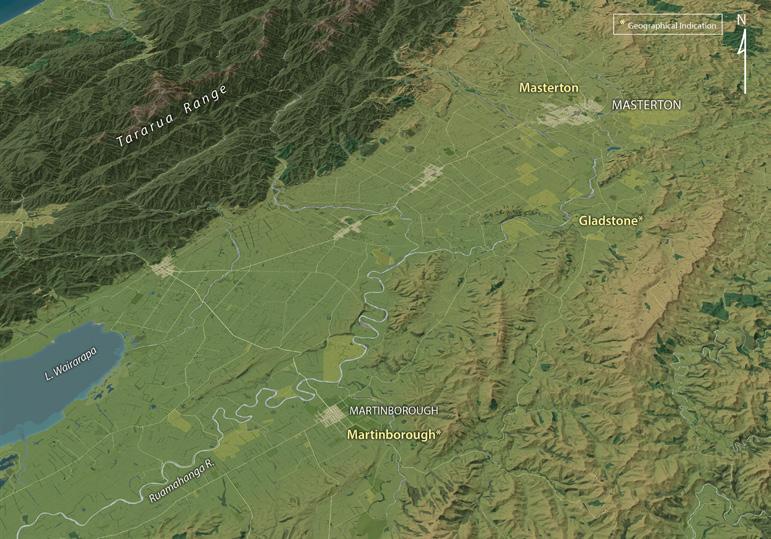

Can we find individual vines that produce acceptable commercial yields (above 2.5 kg per vine or 9 tonnes per hectare) with grape and wine composition comparable to “Icon” labels?
What this experiment in the Pinot noir Programme has tried to control:
• Rootstock (3309C)
• Pinot noir clone (Abel)
• Training system (VSP)
• Pruning system (2-cane mostly)
• Vine age (partially)
• GTD and virus (visually)
• A mix of “Icon” (single-vineyard, high-value wine) and “Affordable” (larger volume varietal blend)
The different vineyards (12) and seasons (5) provide the replication for this trial. The design also allows scope to look at regional effects, although this is not the main goal. Our goal is to identify and understand
if/how yield affects grape and wine composition predictably and consistently at every location, under a range of vineyard management regimes, and across multiple seasons.
The 20 individually monitored vines within each vineyard are the base unit where the (uncontrolled) vine-tovine variation is yield studied. Yield and other data can be statistically analysed at different scales (e.g. Vine < Vineyard < Region < Product < Year)
What is typically not changing for vines within a vineyard:
• Overall management approach (i.e. biodynamic, organic, conventional)
• Target product type (i.e. Icon, Affordable)
• Target (block) crop load (mostly)
• Timing and intensity of general vineyard operations
• Irrigation and fertiliser strategies/ inputs
What is not changing for an individual vine between seasons:
• Root volume and soil properties
• Vine capacity
• Long-term disease status (GTD, virus – although symptom expression could differ)
• Relative topoclimate compared with adjacent vines
We can therefore eliminate the above factors as responsible for variations in performance when we compare individual vines within a vineyard or between years.
For more information about the Pinot Noir Programme and these research aims (2.5 and 2.6), please visit the members’ section of the NZ Winegrower website at nzwine.com.

RESEARCH SUPPLEMENT 80 I NEW ZEALAND WINEGROWER I AUGUST/SEPTEMBER
OB OD OA OC
WB WD WA WC WAIRARAPA
MB MA MD MC
CENTRAL OTAGO WINE REGION
WINE REGION
MARLBOROUGH WINE REGION
Trial Vineyard
Grab F, Scofield C, Schurmann M, Yang L, Stuart L, Moore T, Zhu J, Grose C (Plant & Food Research)
The influence of cold pre-fermentative macerating enzymes on the polysaccharide profile of New Zealand Pinot noir wines

Pinot noir (PN) is one of the most popular red wines in the world and is the second largest produced wine in New Zealand making up 14% of total vineyard area and 4% of exports. PN is a challenging variety and winemakers need a solid understanding of techniques and decisions that can optimise returns through targeting high quality, high price point wines. Wine polysaccharides are large polymers of simple sugars that are thought to influence many parameters that govern quality including, aroma, mouthfeel, and clarity. Present in both the cell walls of grapes and yeasts, they are released into the wine matrix during maceration, fermentation, and ageing processes. The final concentration and profile of polysaccharides is highly dependent on the variety, vintage, climate, and processing techniques employed. During maceration, enzymes are often added to enhance the degradation of the grape skin cell wall. This leads to increased grape juice volume, improved clarification, and greater extraction of compounds such as polyphenols, polysaccharides, and aroma precursors. Commercially employed pectinolytic enzymes are employed to break down the complex, ‘tightly-woven’ cell-wall network, releasing polysaccharides. This process modifies the molecular weight (MW)
distribution of the polysaccharides and their overall content in the final wine. The research group at the University of Auckland led by Prof Bruno Fedrizzi
and supported by Bragato Research Institute have been investigating and profiling the polysaccharides in New Zealand Pinot Noir wines. Recently

RESEARCH SUPPLEMENT NEW ZEALAND WINEGROWER I AUGUST/SEPTEMBER I 81
Hayden Jones-Moore, Dr Rebecca Jelley and Professor Bruno Fedrizzi (University of Auckland)
Figure 1. Research-scale Pinot noir winemaking, cold soak maceration and primary fermentation was carried out in coffee plungers, allowing for pigeage, or punchdown, of the cap multiple times daily. Secondary fermentation was carried out in conical flasks with an airlock and a stopper/bung.
Nautilus Estate
the research group have studied the influence of the use of fermentative macerating enzymes during cold soaking on the polysaccharide profile of PN wines. An experiment was carried out where New Zealand PN juice was treated with five commercially available pectinolytic enzymes for four days at 10 °C prior to inoculation with commercial RC212 yeast. In addition to this, a ‘control’ juice sample was also subjected to the same conditions but without enzyme addition, an inoculated control wine. The polysaccharide profile of both the finished wines and the starting PN juice was then quantified using an inhouse method.
It was postulated that the addition of pectinolytic enzymes during cold soaking may result in higher concentrations of polysaccharides due to increased extractions from the cell-wall network of the grape berry. It was also thought that the increased concentration of enzymes, in addition to the endogenous enzymes released by the yeasts and the naturally occurring grape enzymes, would further assist in extraction of these macromolecules. However, the results from this experiment identified no significant statistical differences in the polysaccharide profile between the wines produced

from juice treated with enzymes and those that were not. As expected, all categories of polysaccharides in the six wines showed statistically increased contents of polysaccharides compared to the juice. The addition of any of the exogenous pectinolytic enzymes species did not significantly out-perform the endogenous enzymes released by the yeast during fermentation, thus none of the enzyme treated juice samples altered the polysaccharide profile of the wines in comparison to the control. It should be noted that the temperature of the cold soak is below that required for optimal enzyme activity.
These results, in conjunction with commercial yeast strain experiments conducted in 2021 (published in the Research Supplement of New Zealand Winegrowers Magazine Dec 2021/ Jan 2022 edition) suggest that the addition of a commercial yeast strain has a more important role in the modulation of the polysaccharide profile of a final wine than the addition of an exogenous macerating enzyme (when added during cold soaking). These results are useful for providing information on the effect these winemaking decisions have on some of the important wine macromolecules that can play a role towards influencing mouthfeel of a finished wine.
About the programme:
This three-year project aimed to develop an analytical method to measure high, medium, and low molecular weight polysaccharides in wines and to determine the effect of different yeast strains and different pectolytic enzymes on polysaccharides concentration in Pinot noir wines during winemaking. It was funded by MBIE and NZW levies.
RESEARCH SUPPLEMENT 82 I NEW ZEALAND WINEGROWER I AUGUST/SEPTEMBER
Misha’s Vineyard
The results from this experiment identified no significant statistical differences in the polysaccharide profile between the wines produced from juice treated with enzymes and those that were not.

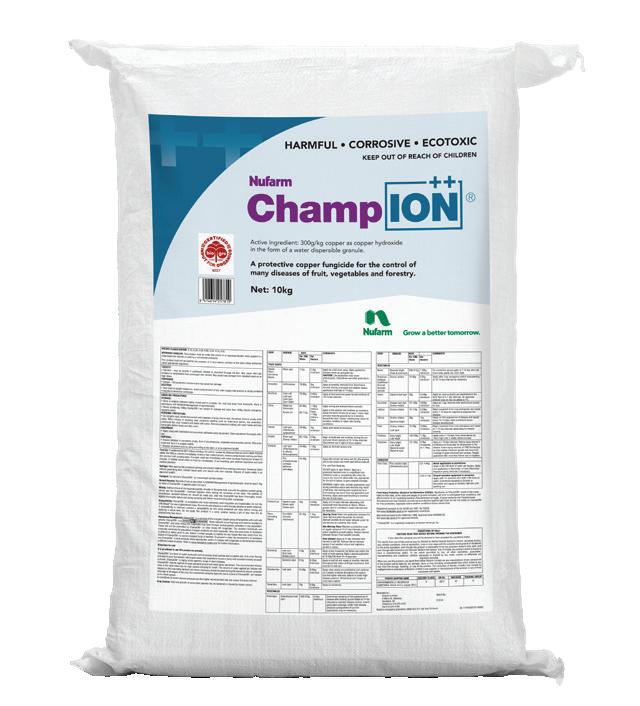
® ChampION++ is a registered trademark of Nufarm Americas Limited ONF207975NF Against disease, our copper is gold! Prevent Black spot and Downy mildew with ChampION++®. A unique WDG copper formulation, ChampION++ has smaller particles that deliver superior coverage on leaves and buds. It also has less environmental load than high dose copper products. For grape growers, that’s pure gold! For more information contact your rural supplier or Nufarm Territory Manager or visit us at nufarm.co.nz/champion




Mike Annand M +6 4 27 533 3343 | P +64 6 879 8312 E info@nzfrostfans.com or visit nzfrostfans.com Take the guesswork out of fighting frost with our FrostBoss® advanced wind solution. • De signed by an ex-America’s Cup Research Engineer • Blows warmer air across the crop to stop frost settling • L ow noise, no ’chop-chop’ sound • E xcellent coverage • Fuel efficient • Auto start and stop to preset temperatures • C ompatible with FrostSmart™ real-time monitoring • Ongoing support The quiet frost fan. Stops frost damage.









































































 Kia kaha, Charlotte Charlotte Read is NZW General Manager Brand
Kia kaha, Charlotte Charlotte Read is NZW General Manager Brand


























































































































 Downer, 24 Vineyard Supervisor at Felton Road
Downer, 24 Vineyard Supervisor at Felton Road
























































 Martin D, Grab F, Scofield C, Schurmann M, Stuart L, Grose C (Plant & Food Research)
Martin D, Grab F, Scofield C, Schurmann M, Stuart L, Grose C (Plant & Food Research)



















